REST API マニュアル(ver1.12.0)
REST API マニュアル 情報
- ALIファームウェア バージョン:
ver. 1.12.0 - 著者: Keigan
REST API 共通
基本
REST API を使⽤して、AMRの動作を制御します。
コンテンツ形式
リクエスト及びレスポンスの Body について、基本的に JSON 形式で情報のやり取りを⾏います。
ヘッダー
JSONを送信するため、以下を追加します。
Content-Type: application/jsonURL(アドレス)
REST API にアクセスするためのアドレスは以下です。
http://[IP Address]:9085/[Path][IP Address]
LAN経由の場合は、ルーター側でIPアドレスを割り当て、または固定設定を行うことにより、決定される。
- 直接
AMRのアクセスポイントに接続する場合・・・10.0.60.1 - ローカルエリアネットワーク
LAN経由で接続する場合・・・192.XXX.X.XX
[Path]
次項 REST API リスト で定義する Path を⽤いる。
HTTPメソッド
| HTTPメソッド | 内容 |
|---|---|
| GET | リソースを取得します。 |
| POST | リソースを新しく追加します。 |
| PUT | 指定されたリソースを修正します。 |
| DELETE | 指定されたリソースを削除します。 |
GET ・・・・・・引数をクエリパラメータに設定(URLの Path 末尾に「?」を付随)POST、PUT、DELETE・・・・引数をBodyに設定
基本的なフロー
基本的な運⽤⽅法は以下とする。
M1マップの選択M2現在位置の設定T1タスクセットの再⽣ または T2 タスクセットのダイレクト再⽣T3タスクセットの再⽣停⽌T4タスクセットの再開
エラーからの復帰
T6-3エラー状態から復帰 を使⽤します。
単体の地点に移動
T7指定位置へ移動 を使⽤します。
マップの取得
M4マップの取得を⾏います。
REST API リスト
| No. | 機能 | HTTP メソッド | Path |
|---|---|---|---|
| T1 | タスクセットの再⽣ | POST | /v2/taskset/exec |
| T2 | タスクセットの直接再⽣ | POST | /v2/taskset/direct_exec |
| T3 | タスクセットの再⽣停⽌ | POST | /v2/taskset/abort |
| T4 | タスクセットの再開 | POST | /v2/taskset/resume |
| T5 | タスクセットのリスト取得 | GET | /v2/taskset/tasksets |
| T6-1 | Idでタスクセットの取得 | GET | /v2/taskset |
| T6-2 | タスクセットの追加 | POST | /v2/taskset |
| T6-3 | タスクセットの削除 | DELETE | /v2/taskset/delete |
| T6-4 | 名前でタスクセットの取得 | GET | /v2/taskset |
| T6-5 | 名前でタスクセットの実行 | POST | /v2/taskset /exec_by_name |
| T7 | エラー状態から復帰 | POST | /v2/error/reset |
| T8 | 指定位置へ移動 | POST | /v2/task/move_position |
| T9 | タスクセットの名前変更 | PUT | /v2/taskset/name |
| T10 | タスクセットを他のマップへ移動 | PUT | /v2/taskset/mapid |
| T11 | タスクセットのcmdsを変更 | PUT | /v2/taskset/tasks |
| T12 | タスクセットの一時停止 | POST | /v2/taskset/pause |
| T13 | 充電ステーションへ移動し、ドッキングする | POST | /v2/charging/dock_to_charging_station |
| T14 | 充電ステーションから離れる | POST | /v2/charging/undock_from_charging_station |
| T15 | 充電ステーション座標の取得 | GET | /v2/calibration/get_charging_station_pose |
| M1 | マップのリスト取得 | GET | /v2/map/maps |
| M2-1 | Idでマップの選択 | POST | /v2/map/select |
| M2-2 | 名前でマップの選択 | POST | /v2/map/select |
| M3 | 現在位置の設定 | POST | /v2/map/initial_position |
| M4-1 | マップidでマップを取得 | GET | /v2/map |
| M4-2 | マップ名で、マップを取得 | GET | /v2/map |
| M5-1 | マップの削除 | DELETE | /v2/map |
| M5-2 | マップの追加 | POST | /v2/map |
| M6 | マップスキャンの開始、中止 | POST | /v2/map/mapping/start |
| M7 | スキャンしたマップの保存 | POST | /v2/map/mapping/save |
| M8 | マップデータを変更 | PUT | /v2/map/map |
| M9 | マップデータの名前を変更 | PUT | /v2/map/name |
| M10 | マップデータの走行可能領域を変更 | PUT | /v2/map/map_edits |
| M11 | マップデータの走行不可領域を変更 | PUT | /v2/map/virtual_obstacles |
| M12 | マップデータの減速エリアを変更 | PUT | /v2/map/speed_limit_zones[KJ6] |
| M13 | マップデータのランドマークを変更 | PUT | V2/map/landmarks[KJ7] |
| STG1 | KeiganALIの基本設定情報を取得 | GET | /v2/settings |
| STG2 | KeiganALIの最高速度を変更 | POST | /v2/settings/max_speed |
| STG3 | スピーカーの音量を変更 | POST | /v2/settings/speaker_volume |
| STG4 | フットプリントを設定 | POST | /v2/settings/amr_footprint |
| STG5 | JOG運転時の直進速度の変更 | POST | /v2/settings/manual_control/translational_speed |
| STG6 | JOG運転時の旋回速度の変更 | POST | /v2/settings/manual_control/rotational_speed |
| STG7 | クリフ(崖)センサの有効/無効設定 | POST | /v2/settings/manual_control/cliff_detection |
| STG8 | ライントレースゲイン(PID)値の設定 | POST | /v2/settings/manual_control/line_tracer_pid_gains |
| STG9 | ライントレースHSV rangeの設定 | POST | /v2/settings/v2/settings/line_tracer_hsv_range |
| STG10 | 自己位置測位パラメーターの取得 | GET | /v2/settings/v2/settings/cauchy_range |
| STG11 | 自己位置測位パラメーターの設定 | POST | /v2/settings/v2/settings/cauchy_range |
| STG12 | LiDARフィルターの取得 | GET | /v2/settings/v2/settings/lidar_filter |
| STG13 | LiDARフィルターの設定 | POST | /v2/settings/v2/settings/lidar_filter |
| STG14 | 直進ゲインの有効/無効設定 | POST | 直進ゲインの有効/無効を設定する |
| STG15 | 直進ゲインの設定 | POST | 直進ゲイン(Kp, Ki, Kd)を設定する |
| STG16 | ユーザーサウンドの追加 | PUT | /v2/settings/v2/settings/user_sound |
| STG17 | ユーザーサウンドの削除 | DELETE | /v2/settings/v2/settings/user_sound |
| STG18 | ユーザーサウンドの取得 | GET | /v2/settings/v2/settings/user_sound |
| STG19 | ユーザーサウンドリストの取得 | GET | /v2/settings/v2/settings/user_sound/list |
| S1 | システムのシャットダウン | POST | /v2/system/shutdown |
| S2 | システムの再起動 | POST | /v2/system/restart |
| S3 | ロボットコントローラの再起動 | POST | /v2/system/controller/reboot |
| C1 | ライントレースオフセット(前後)値の取得 | GET | /v2/system/calibration/line_tracer_offset |
| C2 | ライントレースオフセット(前後)値の設定 | POST | /v2/system/calibration/line_tracer_offset |
| C3 | ライントレースオフセット(左右)値の取得 | GET | /v2/calibration/line_tracer_side_offset |
| C4 | ライントレースオフセット(左右)値の設定 | POST | /v2/calibration/line_tracer_side_offset |
| C5 | ライントレースオフセット値(壁際で停止)の設定 | GET | /v2/calibration/line_tracer_wall_distance_offset |
| C6 | ライントレースオフセット値(壁際で停止)の設定 | POST | /v2/calibration/line_tracer_wall_distance_offset |
| C7 | 充電ドッキング距離のオフセットの取得 | GET | /v2/calibration/docking_distance_offset |
| C8 | 充電ドッキング距離のオフセットの設定 | POST | /v2/calibration/docking_distance_offset |
T1 タスクセットの再⽣
| Path | Method | Function |
|---|---|---|
| /v2/taskset/exec | POST | 指定idの taskSet を再生する |
Request Body
{
"cmdSetId": <int32> #taskset ID
"count":<int32> #Unusd,Number of repeat
"startIndex":<int32> #Index of starting task
}Response Body
{
"message": <string>
"success": <bool>
}APIプラットフォーム(例:Postman)
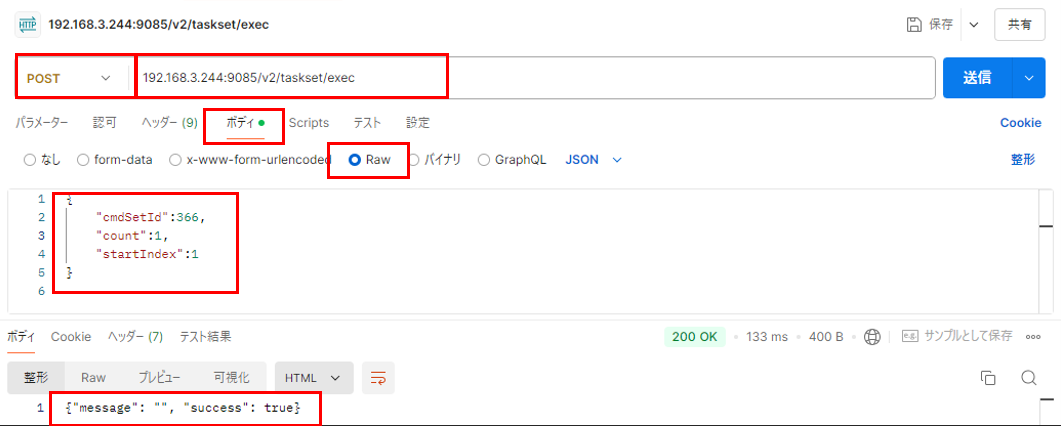
参考コード例 Python
import requests #「requests」ライブラリのインストールが必要です
import json
url = 'http://xxx.xxx.x.xxx:9085/v2/taskset/exec' #IPアドレスを入力
params = {
"cmdSetId":xxx, #cmdSetId, count, startIndexを入力
"count":x,
"startIndex":x
}
res = requests.post(url, json=params)
data = json.loads(res.text)
print(data)参考コード例 Javascript
<script>
let request = new XMLHttpRequest();
request.open("POST", "http://xxx.xxx.x.xxx:9085/v2/taskset/exec", true); //IPアドレスを入力
request.setRequestHeader("content-type", "application/json;charset=UTF-8");
request.responseType = "json";
let body = { cmdSetId: xxx, count: x, startIndex: x }; //cmdSetId, count, startIndexを入力
request.send(JSON.stringify(body));
request.onload = function () {
window.alert(JSON.stringify(this.response));
};
</script>T2 タスクセットのダイレクト再⽣
| Path | Method | Function |
|---|---|---|
| /v2/taskset/direct_exec | POST | taskSet を直接再生する |
Request Body
{
"cmds" <string> # taskset json
}例
{
"cmds": [
{
"arg": {
"ignoreTheta": true,
"passingPoint": false,
"enableObstacleAvoidance": false,
"disableStartAnnouncement": false,
"disableStopAnnouncement": false,
"fastRotation": false,
"mode": 0,
"fastStopping": false,
"x": 2.327471801946775,
"y": 2.849605112286424,
"theta": 1.47598,
"pathWidth": 1,
"obstacleTimeout": 0,
"type": 0,
"enableRerouteRecovery": false,
"disableReplanning": false,
"name": ""
},
"cmdType": 100
}
]
}Response Body
{
"message": <string>,
"success": <bool>
}APIプラットフォーム(例:Postman)
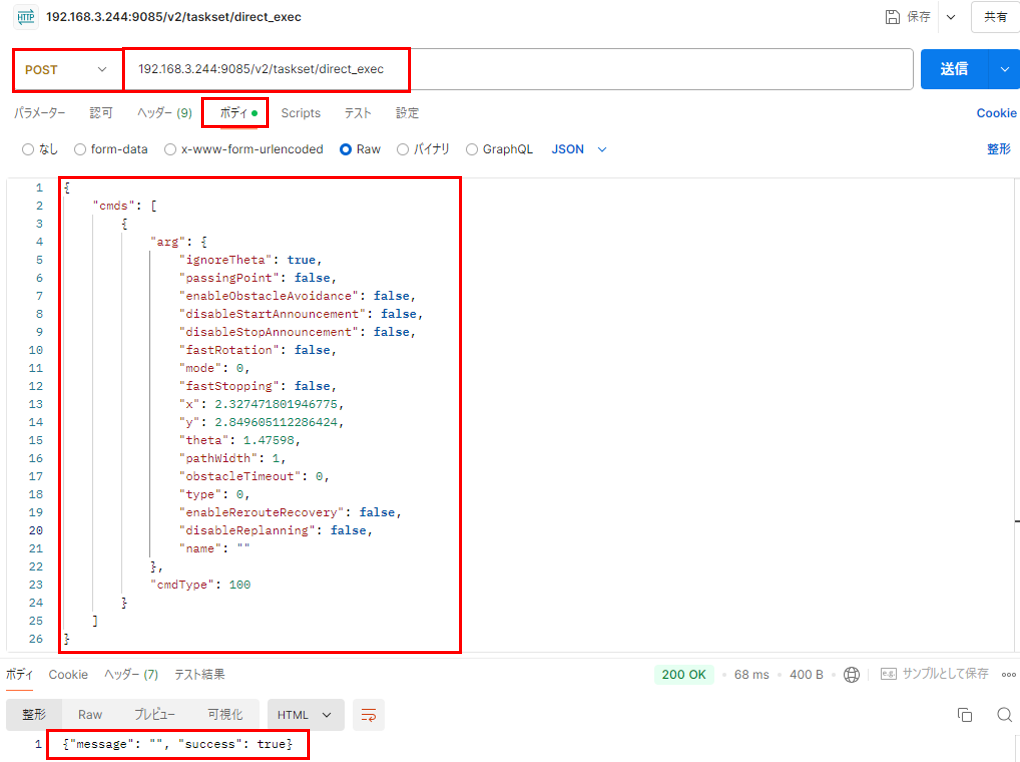
参考コード例 Python
import requests # 「requests」ライブラリのインストールが必要です
import json
url = 'http://xxx.xxx.x.xxx:9085/v2/taskset/direct_exec' # IPアドレスを入力
params = {
"cmds": [
{
"arg": { #cmdTypeに合ったcmdsの内容を記述
…
},
"cmdType": xxx #cmdTypeを入力
}
]
}
res = requests.post(url, json=params)
data = json.loads(res.text)
print(data)参考コード例 Javascript
<script>
let request = new XMLHttpRequest();
request.open("POST", "http://xxx.xxx.x.xxx:9085/v2/taskset/direct_exec", true); //IPアドレスを入力
request.setRequestHeader("content-type", "application/json;charset=UTF-8");
request.responseType = "json";
let body = {
cmds: [
{
arg: {
… //cmdTypeに合ったcmdsの内容を記述
},
cmdType: xxx,
},
],
};
request.send(JSON.stringify(body));
request.onload = function () {
window.alert(JSON.stringify(this.response));
};
</script>T3 タスクセットの再⽣停⽌
| Path | Method | Function |
|---|---|---|
| /v2/taskset/abort | POST | taskSet の再⽣を停⽌する |
Request Body: なし
Response Body
{
"success": <bool>
}APIプラットフォーム(例:Postman)
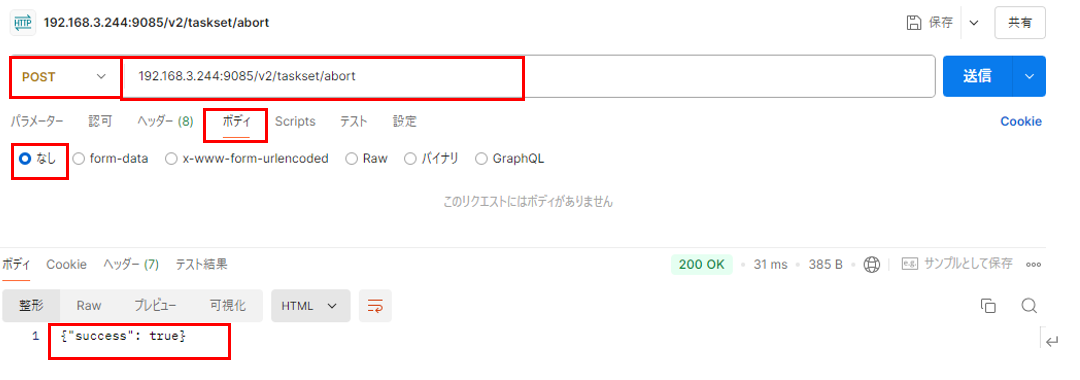
参考コード例 Python
import requests #「requests」ライブラリのインストールが必要です
import json
url = 'http://xxx.xxx.x.xxx:9085/v2/taskset/abort' #IPアドレスを入力
res = requests.post(url)
data = json.loads(res.text)
print(data)参考コード例 Javascript
<script>
let request = new XMLHttpRequest();
request.open('POST', 'http://192.XXX.X.XX:9085/v2/taskset/abort', true); //IPアドレスを入力
request.setRequestHeader('content-type', 'application/json;charset=UTF-8');
request.responseType = 'json';
request.send();
request.onload = function() {
window.alert( JSON.stringify( this.response ) );
};
</script>T4 タスクセットの再開
| Path | Method | Function |
|---|---|---|
| /v2/taskset/resume | POST | taskSet の再⽣を再開する |
Request Body: なし
Response Body
{
"success": <bool>
}APIプラットフォーム(例:Postman)
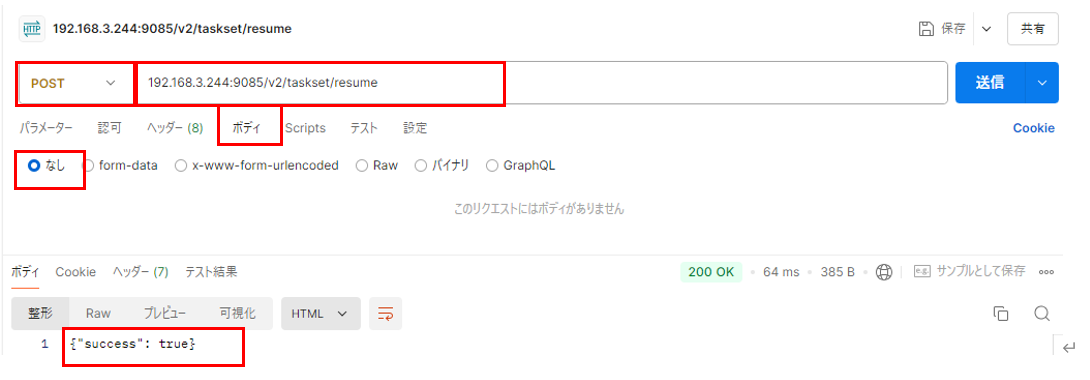
参考コード例 Python
import requests #「requests」ライブラリのインストールが必要です
import json
url = 'http://xxx.xxx.x.xxx:9085/v2/taskset/resume' #IPアドレスを入力
res = requests.post(url)
data = json.loads(res.text)
print(data)参考コード例 Javascript
<script>
let request = new XMLHttpRequest();
request.open("POST", "http:// xxx.xxx.x.xxx:9085/v2/taskset/resume", true); //IPアドレスを入力
request.setRequestHeader("content-type", "application/json;charset=UTF-8");
request.responseType = "json";
request.send();
request.onload = function () {
window.alert(JSON.stringify(this.response));
};
</script>T5 タスクセットのリスト取得
| Path | Method | Function |
|---|---|---|
| /v2/taskset/tasksets | GET | taskSet のリストを取得する |
Request Body
{
"mapId" :<int32>
}Request Body
{
'success': True,
'lists': [
{
'name': 'xxxx', #Taskset Name
'appData': {}, # 拡張予約
'cmdSetType': xx, # cndSet type
'mapId': xxx, #map id
'cmds': [
{'arg': {
... #cmdTypeに合ったcmdsの内容
},
'cmdType': xxx #cmd type
},
.
.
],
'id': xxx # taskset id
},
{
'name': 'xxxx',
'appData': {},
'cmdSetType': xx,
'mapId': xxx,
'cmds': [
{'arg': {
...
},
'cmdType': xxx
},
.
.
],
'id': xxx
},
]APIプラットフォーム(例:Postman)
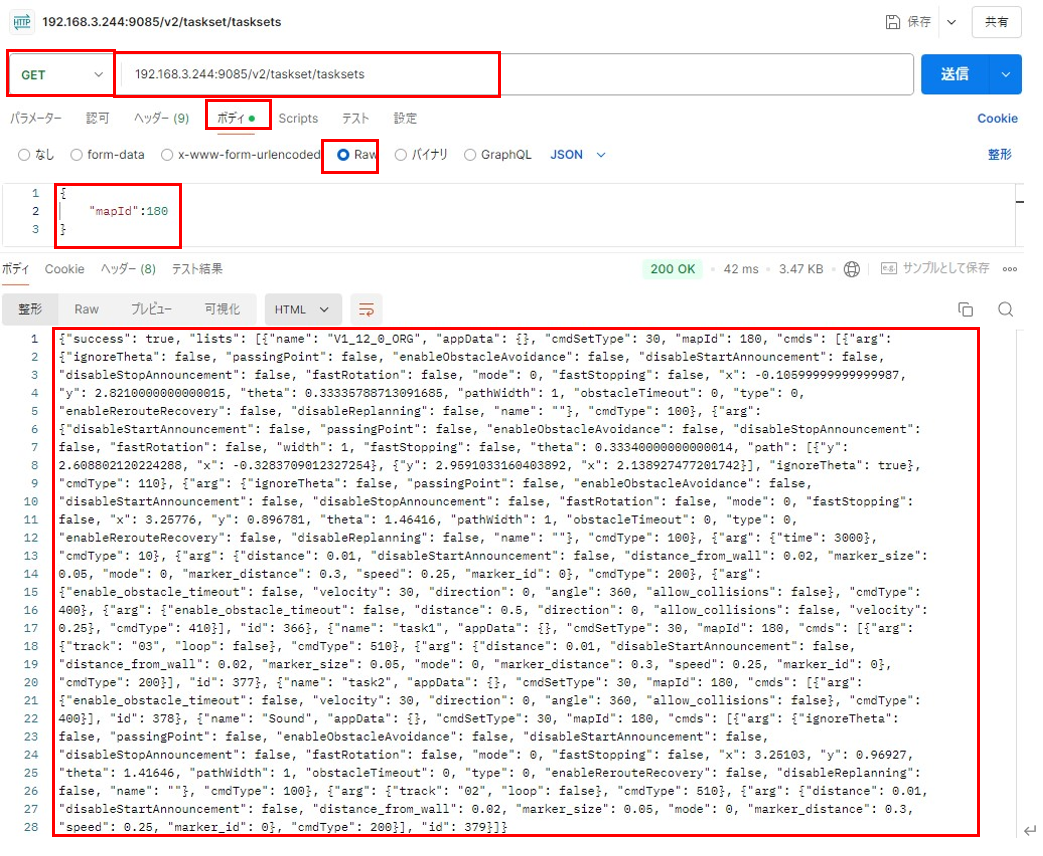
参考コード例 Python
import requests #「requests」ライブラリのインストールが必要です
import json
url = 'http://xxx.xxx.x.xxx:9085/v2/taskset/tasksets' #IPアドレスを入力
params = {'mapId':xxx} #mapIdを入力
res = requests.get(url, json=params)
data = json.loads(res.text)
print(data)参考コード例 Javascript
<script>
let request = new XMLHttpRequest();
request.open( "GET", "http://xxx.xxx.x.xxx:9085/v2/taskset/tasksets?mapId=xxx", true); //IPアドレス、mapIdを入力
request.setRequestHeader("content-type", "application/json;charset=UTF-8");
request.responseType = "json";
request.send();
request.onload = function () {
window.alert(JSON.stringify(this.response));
};
</script>NG例
request.open('GET', 'http://192.xxx.x.xxx9085/v2/taskset/taskset, true);
request.setRequestHeader('content-type', 'application/json;charset=UTF-8');
request.responseType = 'json';
request.send(JSON.stringify({mapId:xxx})); //GETメソッドでは引数をBodyにして送信できませんT6-1 idでタスクセットの取得
| Path | Method | Function |
|---|---|---|
| /v2/taskset | GET | 指定idのtaskSetを取得する |
Request Body
{
"cmdSetId":<int32> #taskset ID
}Response Body
{
"cmdSetName": "xxx", #タスクセット名
"success": true,
"appData": {}, #拡張予約
"cmdSetType": 30, #固定値
"mapId": xxx, #map id
"id": xxx, #taskSet id
"cmds": [
{
"arg": {
. #cmdTypeに合ったcmdsの内容
.
},
"cmdType": xxx
},
.
.
"arg": {
.
.
},
"cmdType": xxx
}
}APIプラットフォーム(例:Postman)
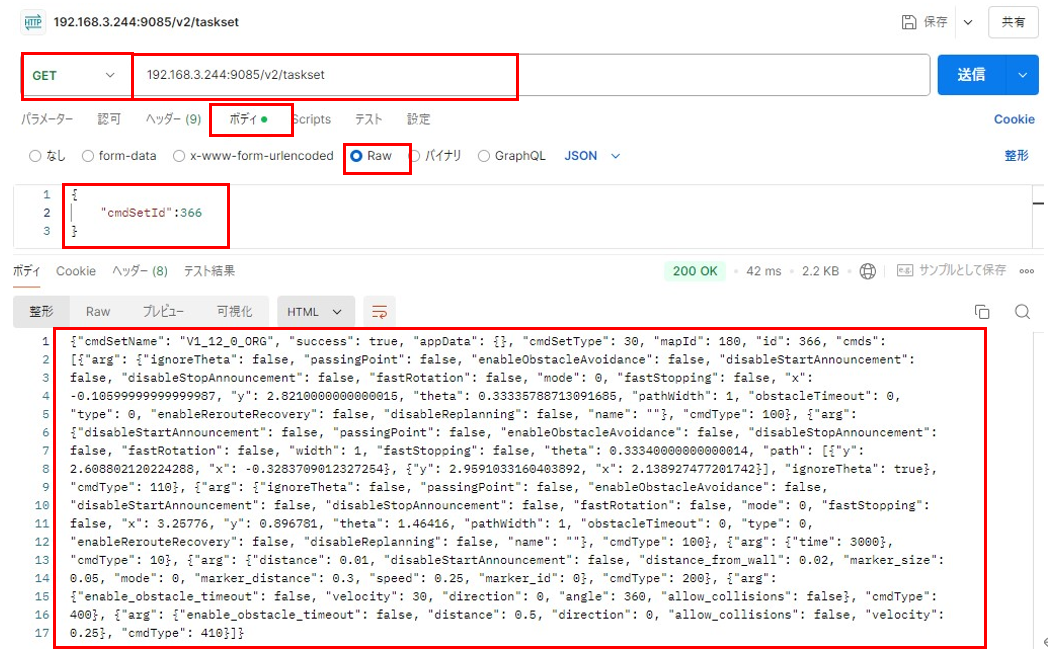
参考コード例 Python
import requests #「requests」ライブラリのインストールが必要です
import json
url = 'http://xxx.xxx.x.xxx:9085/v2/taskset' #IPアドレスを入力
params = {'cmdSetId':xxx} #cmdSetIdを入力
res = requests.get(url, json=params)
data = json.loads(res.text)
print(data)参考コード例 Javascript
<script>
let request = new XMLHttpRequest();
request.open('GET', 'http://192.xxx.x.xxx:9085/v2/taskset?cmdSetId=xxx', true); //IPアドレス、cmdSetIdを入力
request.setRequestHeader('content-type', 'application/json;charset=UTF-8');
request.responseType = 'json';
request.send();
request.onload = function() {
window.alert( JSON.stringify( this.response ) );
};
</script>NG例
request.open('GET', 'http://192.XXX.X.XX:9085/v2/taskset, true);
request.setRequestHeader('content-type', 'application/json;charset=UTF-8');
request.responseType = 'json';
request.send(JSON.stringify({cmdSetId:XXX})); //GETメソッドでは引数をBodyにして送信できませんT6-2 タスクセットの追加
| Path | Method | Function |
|---|---|---|
| /v2/taskset | POST | taskSet を追加する |
Request Body
json
{
"mapId": xxx, #map id
"cmdSetName": "xxx", #タスクセット名
"cmdSetType": 30, #固定値
"cmds": [
{
"arg": {
. #cmdTypeに合ったcmdsの内容
.
},
"cmdType": xxx
},
.
.
{
"arg": {
.
.
},
"cmdType": xxx
}
],
"appData": {}
}Response Body
{
"success":<bool>
"cmdSetId":<int32> #Ali側でナンバリングされたtaskSet id
}APIプラットフォーム(例:Postman)
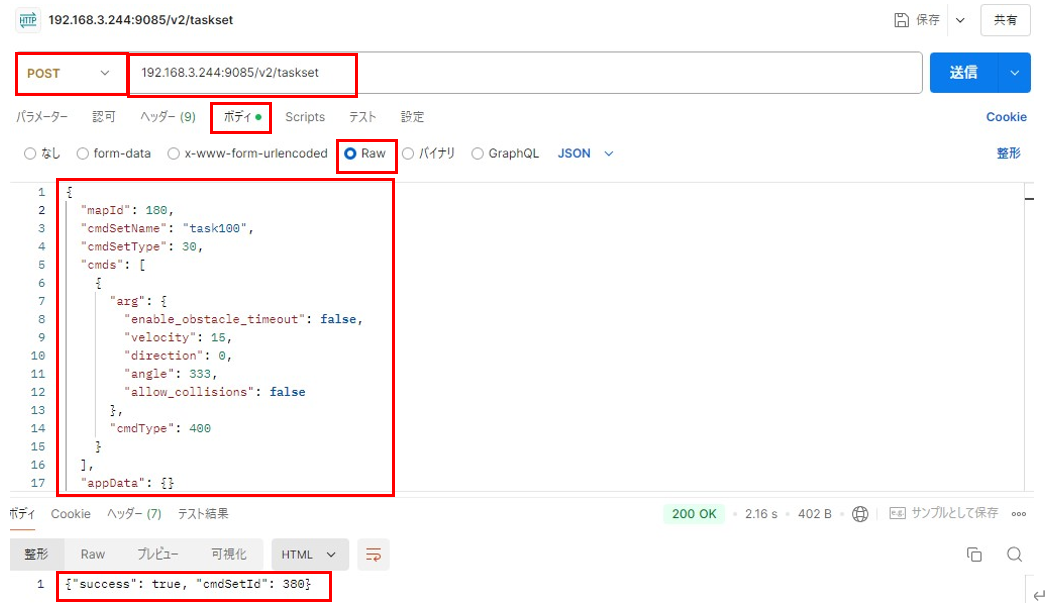
参考コード例 Python
import requests #「requests」ライフラリのインストールが必要です
import json
url = 'http://xxx.xxx.x.xxx:9085/v2/taskset' #IPアドレスを入力
params = {
"mapId": xxx, # mapId, cmdSetName, cmdsを入力
"cmdSetName": "xxx",
"cmdSetType": 30, # cmdSetTypeは30の固定値
"cmds": [
{
"arg": {
. #cmdTypeに合ったcmdsの内容
.
},
"cmdType": xxx
},
.
.
{
"arg": {
.
.
},
"cmdType": xxx
}
],
"appData": {}
}
res = requests.post(url, json=params)
data = json.loads(res.text)
print(data)参考コード例 Javascript
<script>
let request = new XMLHttpRequest();
request.open("POST", "http://xxx.xxx.x.xxx:9085/v2/taskset", true); //IPアドレスを入力
request.setRequestHeader("content-type", "application/json;charset=UTF-8");
request.responseType = "json";
let body = {
mapId: xxx, //mapId, cmdSetName, cmdsを入力
cmdSetName: "xxx",
cmdSetType: 30, //固定値
cmds: [
{
arg: {
. //cmdTypeに合ったcmdsの内容
.
},
cmdType: xxx,
},
.
.
arg: {
.
.
},
cmdType: xxx, //cmd typeを入力
}
],
appData: {}, //拡張予約
};
request.send(JSON.stringify(body));
request.onload = function () {
window.alert(JSON.stringify(this.response));
};
</script>T6-3 タスクセットの削除
| Path | Method | Function |
|---|---|---|
| /v2/taskset/delete | DELETE | taskSet を削除する |
Request Body
{
"cmdSetId" <int32>
}Response Body
{
"success":<bool>
}APIプラットフォーム(例:Postman)
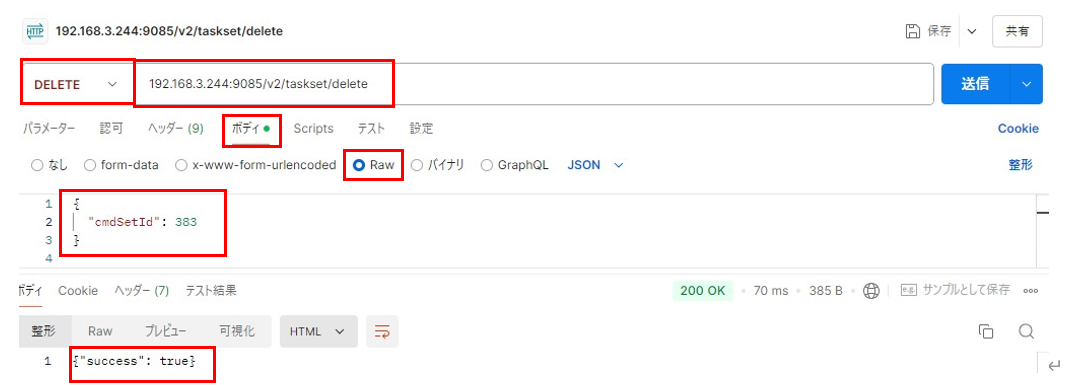
参考コード例 Python
import requests #「requests」ライブラリのインストールが必要です
import json
url = 'http://xxx.xxx.x.xxx:9085/v2/taskset/delete' #IPアドレスを入力
params = {'cmdSetId': xxx } #cmdSetIdを入力
res = requests.delete(url, json=params)
data = json.loads(res.text)
print(data)参考コード例 Javascript
<script>
let request = new XMLHttpRequest();
request.open('DELETE', 'http://192.XXX.X.XX:9085/v2/taskset/delete', true); //IPアドレスを入力
request.setRequestHeader('content-type', 'application/json;charset=UTF-8');
request.responseType = 'json';
let body ={'cmdSetId':XXX}; //cmdSetIdを入力
request.send(JSON.stringify(body));
request.onload = function() {
window.alert( JSON.stringify( this.response ) );
};
</script>T6-4 名前でタスクセットの取得
| Path | Method | Function |
|---|---|---|
| /v2/taskset | GET | 指定名前のtaskSetを取得する |
Request Body
{
"cmdSetname":<string> #taskset name
}Response Body
{
"cmdSetName": "xxx", #タスクセット名
"success": true,
"appData": {}, #拡張予約
"cmdSetType": 30, #固定値
"mapId": xxx, #map id
"id": xxx, #taskSet id
"cmds": [
{
"arg": {
. #cmdTypeに合ったcmdsの内容
.
},
"cmdType": xxx
},
.
.
"arg": {
.
.
},
"cmdType": xxx
}
}APIプラットフォーム(例:Postman)
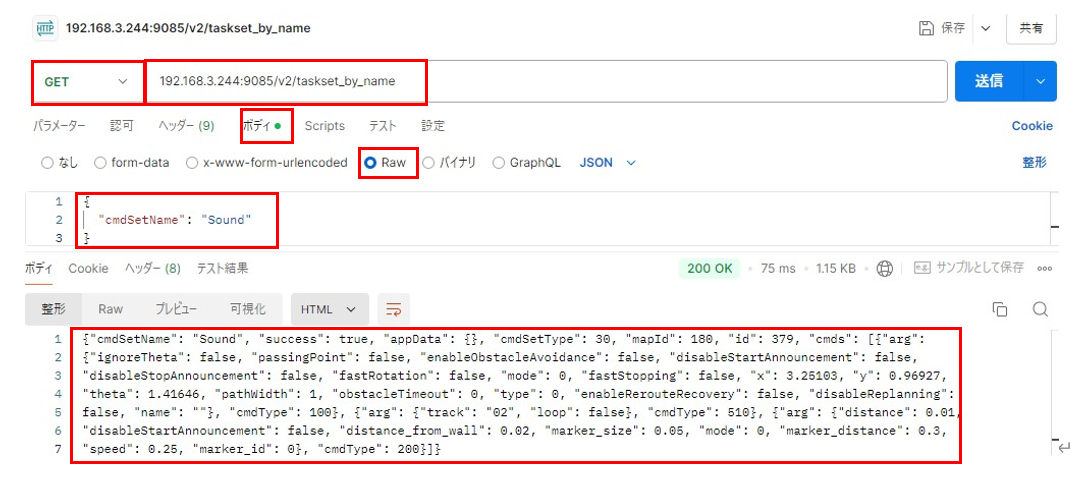
参考コード例 Python
import requests #「requests」ライブラリのインストールが必要です
import json
url = 'http://xxx.xxx.x.xxx:9085/v2/taskset_by_name' #IPアドレスを入力
params = {"cmdSetName": "xxx"} #タスクセット名を入力
res = requests.get(url, json=params)
data = json.loads(res.text)
print(data)参考コード例 Javascript
<script>
let request = new XMLHttpRequest();
request.open('GET', 'http://192.XXX.X.XX:9085/v2/taskset?cmdSetName=XXX', true); #IPアドレス、cmdSetIdを入力
request.setRequestHeader('content-type', 'application/json;charset=UTF-8');
request.responseType = 'json';
request.send();
request.onload = function() {
window.alert( JSON.stringify( this.response ) );
};
</script>NG例
request.open('GET', 'http://192.XXX.X.XX:9085/v2/taskset_by_name, true);
request.setRequestHeader('content-type', 'application/json;charset=UTF-8');
request.responseType = 'json';
request.send(JSON.stringify({cmdSetname:XXX})); //GETメソッドでは引数をBodyにして送信できませんT6-5 名前でタスクセットを実行
| Path | Method | Function |
|---|---|---|
| /v2/taskset/exec_by_name | POST | 名前でタスクセットを実行 |
Request Body
{
"cmdSetname":<string> #taskset name
}Response Body
{
"success":<bool>
}APIプラットフォーム(例:Postman)
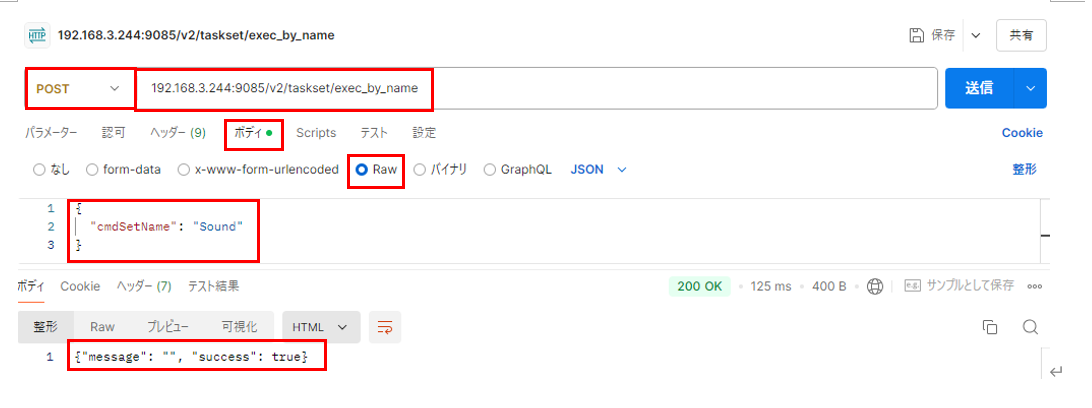
参考コード例 Python
import requests #「requests」ライブラリのインストールが必要です
import json
url = 'http://xxx.xxx.x.xxx:9085/v2/taskset_by_name' #IPアドレスを入力
params = {"cmdSetName": "xxx"} #タスクセット名を入力
res = requests.post(url, json=params)
data = json.loads(res.text)
print(data)参考コード例 Javascript
<script>
let request = new XMLHttpRequest();
request.open("POST", "http://xxx.xxx.x.xxx:9085/v2/taskset/exec_by_name", true); //IPアドレスを入力
request.setRequestHeader("content-type", "application/json;charset=UTF-8");
request.responseType = "json";
let body = { cmdSetName: "xxx" }; //cmdSetId, count, startIndexを入力
request.send(JSON.stringify(body));
request.onload = function () {
window.alert(JSON.stringify(this.response));
};
</script>NG例
request.open('GET', 'http://192.XXX.X.XX:9085/v2/taskset_by_name, true);
request.setRequestHeader('content-type', 'application/json;charset=UTF-8');
request.responseType = 'json';
request.send(JSON.stringify({cmdSetname:XXX}));
//GETメソッドでは引数をBodyにして送信できませんT7 エラー状態から復帰
| Path | Method | Function |
|---|---|---|
| /v2/error/reset | POST | エラー状態から復帰する |
Request Body: なし
Response Body
{
"success":<bool>
}APIプラットフォーム(例:Postman)

参考コード例 Python
import requests #「requests」ライブラリのインストールが必要です
import json
url = 'http://xxx.xxx.x.xxx:9085/v2/error/reset' #IPアドレスを入力
res = requests.post(url)
data = json.loads(res.text)
print(data)参考コード例 Javascript
<script>
let request = new XMLHttpRequest();
request.open("POST", "http://xxx.xxx.x.xxx:9085/v2/error/reset", true); //IPアドレスを入力
request.setRequestHeader("content-type", "application/json;charset=UTF-8");
request.responseType = "json";
request.send();
request.onload = function () {
window.alert(JSON.stringify(this.response));
};
</script>T8 指定位置へ移動
| Path | Method | Function |
|---|---|---|
| /v2/task/move_position | POST | 指定位置へ移動 |
Request Body
{
"x": <float32> # x, (マップ原点に対する AMR 座標)
"y": <float32> # y, (マップ原点に対する AMR 座標)
"theta": <float32> # Machine angle (radian) (実機の⽅向)
"type":<int32> # 拡張予約
}Response Body
{
"success":<bool>
}APIプラットフォーム(例:Postman)
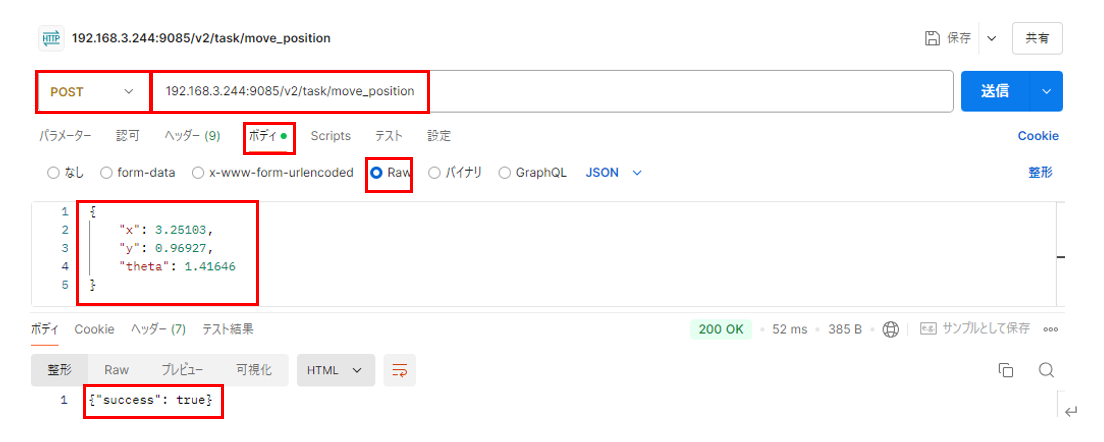
参考コード例 Python
import requests #「requests」ライブラリのインストールが必要です
import json
url = 'http://192.XXX.X.XX:9085/v2/task/move_position' #IPアドレスを入力
params = {'x':XXX, 'y':XXX, 'theta':XXX} #x, y, thetaを入力
res = requests.post(url, json=params)
data = json.loads(res.text)
print(data)参考コード例 Javascript
<script>
let request = new XMLHttpRequest();
request.open('POST', 'http://xxx.xxx.x.xxx:9085/v2/task/move_position', true); //IPアドレスを入力
request.setRequestHeader('content-type', 'application/json;charset=UTF-8');
request.responseType = 'json';
let body = {x:xxx, y:xxx, theta:xxx}; //x, y, thetaを入力
request.send(JSON.stringify(body));
request.onload = function() {
window.alert( JSON.stringify( this.response ) );
};
</script>T9 タスクセットの名前変更
| Path | Method | Function |
|---|---|---|
| /v2/taskset/name | PUT | 指定idのタスクセットの名前変更 |
Request Body
{
"cmdSetId": <int32>
"name": <string>
}Response Body
{
"success": <bool>
}APIプラットフォーム(例:Postman)
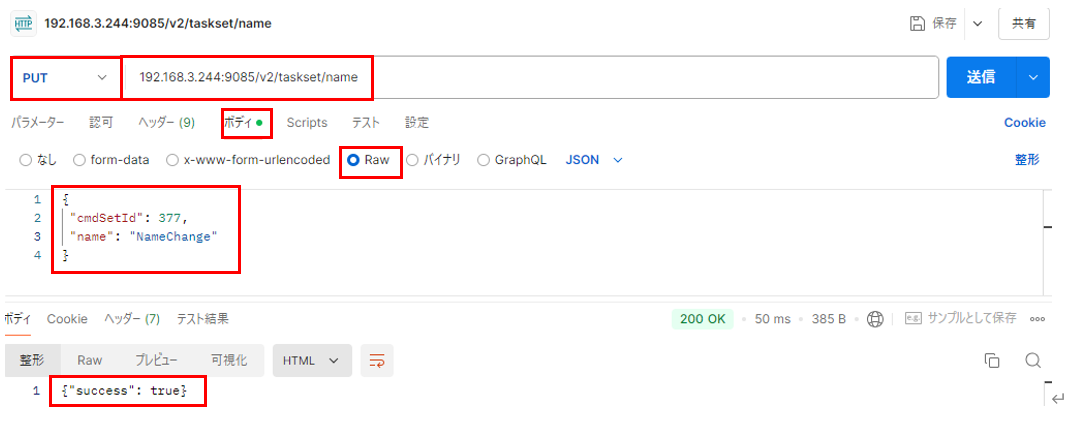
参考コード例 Python
import requests #「requests」ライブラリのインストールが必要です
import json
url = 'http://xxx.xxx.x.xxx:9085/v2/taskset/name' #IPアドレスを入力
params = { "cmdSetId":xxx "name": “xxx” } #cmdSetId, nameを入力
res = requests.put(url, json=params)
data = json.loads(res.text)
print(data)参考コード例 Javascript
<script>
let request = new XMLHttpRequest();
request.open('PUT', 'http://xxx.xxx.x.xxx:9085/v2/taskset/name', true); //IPアドレスを入力
request.setRequestHeader('content-type', 'application/json;charset=UTF-8');
request.responseType = 'json';
let body = {cmdSetId : xxx, name : “xxx”}; //cmdSetId, nameを入力
request.send(JSON.stringify(body));
request.onload = function() {
window.alert( JSON.stringify( this.response ) );
};
</script>T10 タスクセットを他のマップへ移動
| Path | Method | Function |
|---|---|---|
| /v2/taskset/mapId | PUT | 指定idのタスクセットを他のマップへ移動 |
Request Body
{
"cmdSetId": <int32>
"mapId": <int32>
}Response Body
{
"success": <bool>
}APIプラットフォーム(例:Postman)
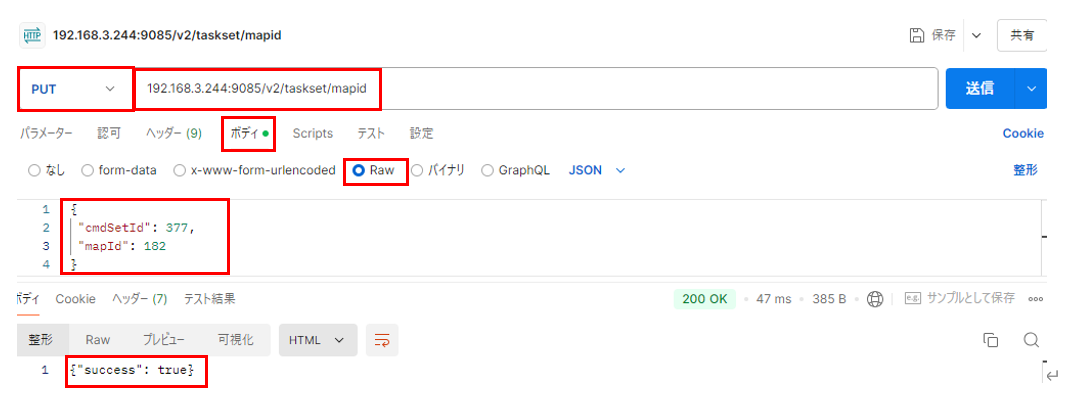
参考コード例 Python
import requests #「requests」ライブラリのインストールが必要です
import json
url = 'http://xxx.xxx.x.xxx:9085/v2/taskset/mapid' #IPアドレスを入力
params = { "cmdSetId":xxx, "mapId":xxx} #cmdSetId, mapIdを入力
res = requests.put(url, json=params)
data = json.loads(res.text)
print(data)参考コード例 Javascript
<script>
let request = new XMLHttpRequest();
request.open('PUT', 'http://xxx.xxx.x.xxx:9085/v2/taskset/mapid', true); //IPアドレスを入力
request.setRequestHeader('content-type', 'application/json;charset=UTF-8');
request.responseType = 'json';
let body = {cmdSetId :xxx, mapId :xxx }; //cmdSetId, mapIdを入力
request.send(JSON.stringify(body));
request.onload = function() {
window.alert( JSON.stringify( this.response ) );
};
</script>T11 タスクセットのcmdsを変更
| Path | Method | Function |
|---|---|---|
| /v2/taskset/tasks | PUT | 指定idのタスクセットのcmdsを変更 |
Request Body
{
"cmdSetId": <int32>
"cmds": <string>
}Response Body
{
"success": <bool>
}APIプラットフォーム(例:Postman)
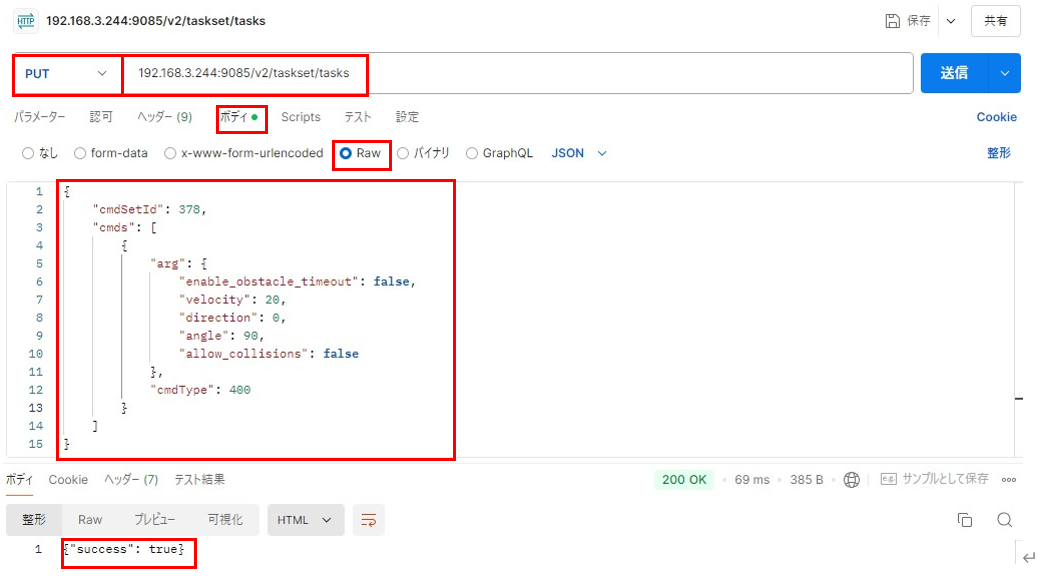
参考コード例 Python
import requests #「requests」ライブラリのインストールが必要です
import json
url = 'http://xxx.xxx.x.xxx:9085/v2/taskset/tasks' #IPアドレスを入力
params = { "cmdSetId":xxx,
"cmds":[
{
"arg":{
… #cmdTypeに合ったcmdsの内容を記述
},
"cmdType":xxx #cmdTypeを入力
},
,
.
{
"arg":{
… #cmdTypeに合ったcmdsの内容を記述
},
"cmdType":xxx #cmdTypeを入力
}
]
}
res = requests.put(url, json=params)
data = json.loads(res.text)
print(data)参考コード例 Javascript
<script>
let request = new XMLHttpRequest();
request.open('PUT', 'http://xxx.xxx.x.xxx:9085/v2/taskset/tasks', true); //IPアドレスを入力
request.setRequestHeader('content-type', 'application/json;charset=UTF-8');
request.responseType = 'json';
let body = { cmdSetId :xxx,
cmds :[
{
arg :{
… //cmdTypeに合ったcmdsの内容を記述
},
cmdType :xxx //cmdTypeを入力
},
,
.
{
arg :{
… //cmdTypeに合ったcmdsの内容を記述
},
cmdType :xxx //cmdTypeを入力
}
]
}
request.send(JSON.stringify(body));
request.onload = function() {
window.alert( JSON.stringify( this.response ) );
};
</script>T12 タスクセットの一時停止
| Path | Method | Function |
|---|---|---|
| /v2/taskset/pause | POST | タスクセットの再生を一時停止する |
Request Body : なし
Response Body
{
"success": <bool>
}APIプラットフォーム(例:Postman)

参考コード例 Python
import requests #「requests」ライブラリのインストールが必要です
import json
url = 'http://xxx.xxx.x.xx:9085/v2/taskset/pause' #IPアドレスを入力
res = requests.post(url)
data = json.loads(res.text)
print(data)参考コード例 Javascript
<script>
let request = new XMLHttpRequest();
request.open('POST', 'http://192.XXX.X.XX:9085/v2/taskset/pause', true); //IPアドレスを入力
request.setRequestHeader('content-type', 'application/json;charset=UTF-8');
request.responseType = 'json';
request.send();
request.onload = function() {
window.alert( JSON.stringify( this.response ) );
};
</script>T13 充電ステーションへ移動し、ドッキングする
| Path | Method | Function |
|---|---|---|
| /v2/charging/dock_to_charging_station | POST | 充電ステーションへ移動し、ドッキングする |
Request Body :
{
"dock_x": <float32>,
"dock_y": <float32>,
"dock_theta": <float32>
}Response Body
{
"success": <bool>
}APIプラットフォーム(例:Postman)
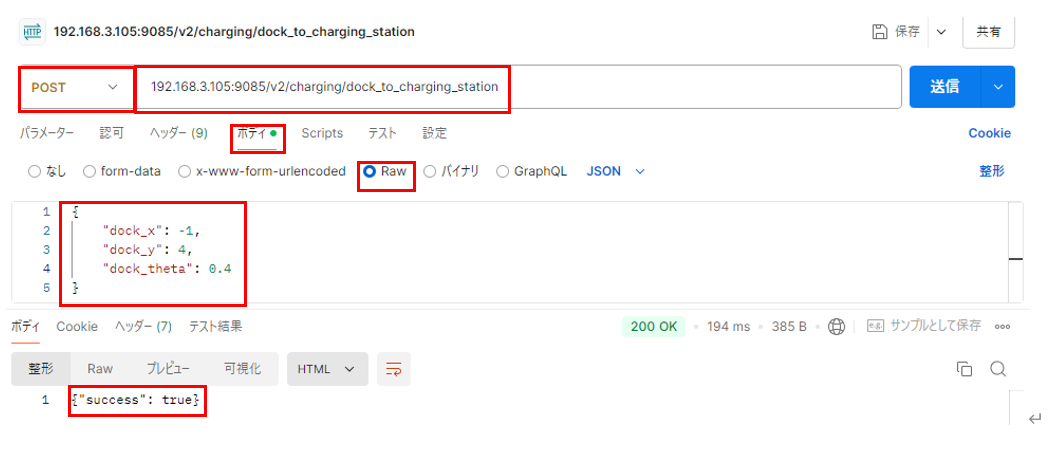
参考コード例 Python
import requests #「requests」ライブラリのインストールが必要です
import json
url = 'http://xxx.xxx.x.xxx:9085/v2/charging/dock_to_charging_station' #IPアドレスを入力
params = {
"dock_x":xxx,
"dock_y":xxx,
"dock_theta":xxx
}
res = requests.post(url, json=params)
data = json.loads(res.text)
print(data)参考コード例 Javascript
<script>
let request = new XMLHttpRequest();
request.open('POST', 'http://xxx.xxx.x.xxx:9085/v2/charging/dock_to_charging_station ', true); //IPアドレスを入力
request.setRequestHeader('content-type', 'application/json;charset=UTF-8');
request.responseType = 'json';
let body = { //充電ステーションの座標
dock_x: xxx,
dock_y: xxx,
dock_theta: xxx
};
request.send(JSON.stringify(body));
request.onload = function() {
window.alert( JSON.stringify( this.response ) );
};
</script>T14 充電ステーションから離れる
| Path | Method | Function |
|---|---|---|
| /v2/charging/undock_from_charging_station | POST | 充電ステーションから離れる |
Request Body なし
Response Body
{
"success": <bool>
}APIプラットフォーム(例:Postman)
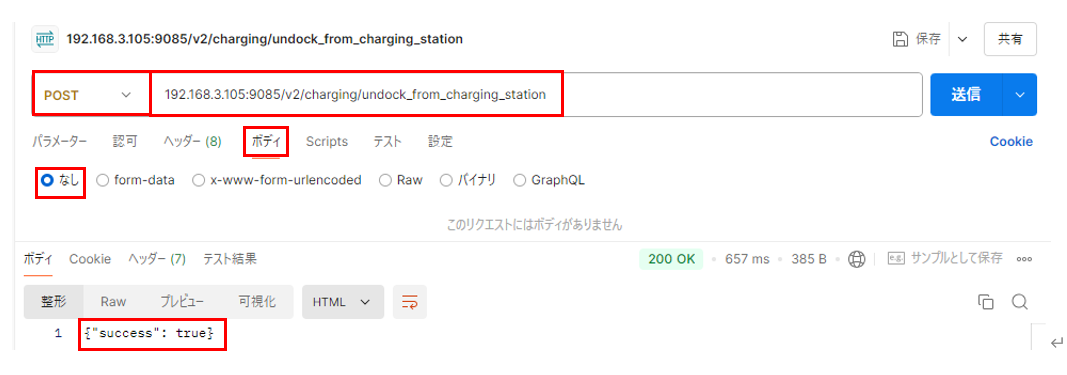
参考コード例 Python
import requests #「requests」ライブラリのインストールが必要です
import json
url = 'http://xxx.xxx.x.xxx:9085/v2/charging/undock_from_charging_station' #IPアドレスを入力
res = requests.post(url)
data = json.loads(res.text)
print(data)参考コード例 Javascript
<script>
let request = new XMLHttpRequest();
request.open('POST', 'http://xxx.xxx.x.xxx:9085/v2/charging/undock_from_charging_station ', true); //IPアドレスを入力
request.setRequestHeader('content-type', 'application/json;charset=UTF-8');
request.responseType = 'json';
request.send();
request.onload = function() {
window.alert( JSON.stringify( this.response ) );
};
</script>T15 充電ステーション座標の取得
| Path | Method | Function |
|---|---|---|
| /v2/calibration/get_charging_station_pose | GET | 充電ステーションの座標を取得する |
Request Body なし
Response Body
{
"dock_x": <float32>, #充電ステーションのx座標
"dock_y": <float32>, #充電ステーションのy座標
"dock_theta": <float32>, #充電ステーションの角度
“success”: <bool >
}APIプラットフォーム(例:Postman)
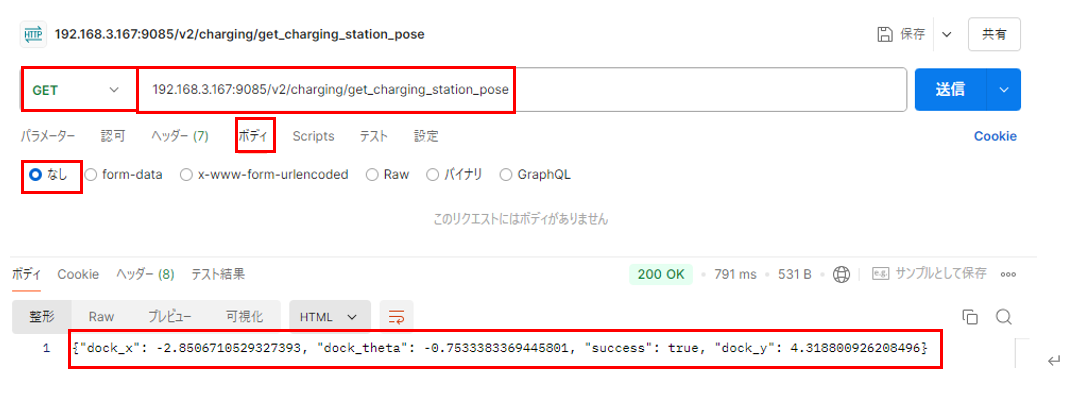
参考コード例 Python
import requests #「requests」ライブラリのインストールが必要です
import json
url = 'http://xxx.xxx.x.xxx:9085/v2/charging/get_charging_station_pose ' #IPアドレスを入力
res = requests.get(url)
data = json.loads(res.text)
print(data)参考コード例 Javascript
<script>
let request = new XMLHttpRequest();
request.open('GET', 'http://xxx.xxx.x.xxx:9085/v2/calibration/docking_distance_offset', true); //IPアドレスを入力
request.setRequestHeader('content-type', 'application/json;charset=UTF-8');
request.responseType = 'json';
request.send();
request.onload = function() {
window.alert( JSON.stringify( this.response ) );
};
</script>M1 マップのリスト取得
| Path | Method | Function |
|---|---|---|
| /v2/map/maps | GET | マップのリストを取得する |
Request Body: なし
Response Body
{
"success": <bool >
"lists": [ … ] #JSON
}"list"
[
{
"info": "<string>", # map info (Reserved, not used)
"id": <uint32>, # map id
"name": "<string>" # map name
},
.
.
{
"info": "<string>", # map info (Reserved, not used)
"id": <uint32>, # map id
"name": "<string>" # map name
}
]APIプラットフォーム(例:Postman)
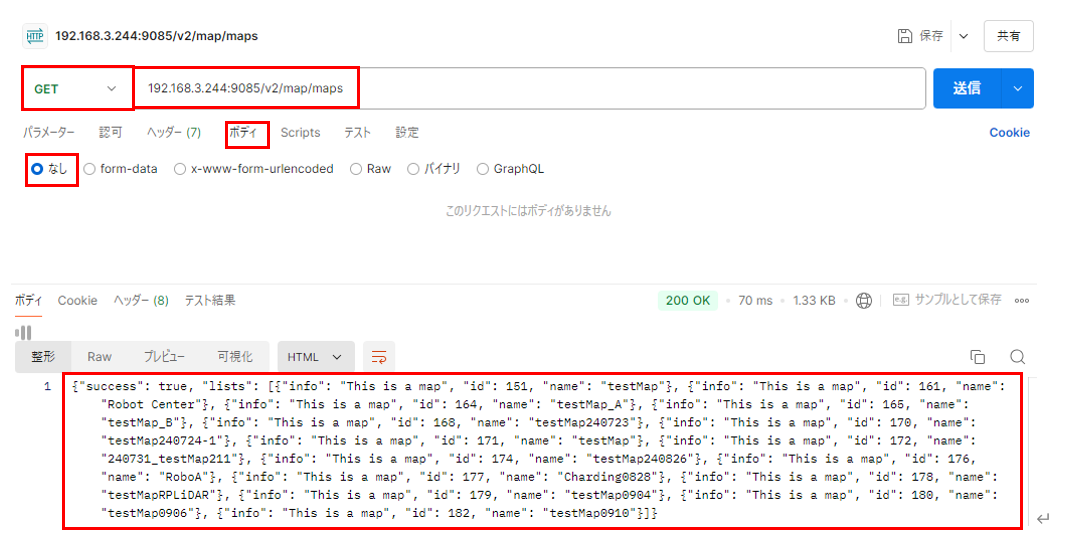
参考コード例 Python
import requests #「requests」ライブラリのインストールが必要です
import json
url = 'http://192.XXX.X.XX:9085/v2/map/maps' #IPアドレスを入力
res = requests.get(url)
data = json.loads(res.text)
print(data)参考コード例 Javascript
<script>
let request = new XMLHttpRequest();
request.open('GET', 'http://192.XXX.X.XX:9085/v2/map/maps', true); //IPアドレスを入力
request.setRequestHeader('content-type', 'application/json;charset=UTF-8');
request.responseType = 'json';
request.send();
request.onload = function() {
window.alert( JSON.stringify( this.response ) );
};
</script>M2-1 idを指定してマップの選択
| Path | Method | Function |
|---|---|---|
| /v2/map/select | POST | idを指定してマップを選択する |
「M10: マップデータの走行可能領域を変更」/v2/map/map_edits「M11: マップデータの走行不可領域を変更」/v2/map/virtual_obstacles「M12: マップデータの減速エリアを変更」/v2/map/speed_limit_zones「M13: マップデータのランドマークを変更」/v2/map/landmarks
を送信後は、マップへ正しく反映させるために、必ず本APIを送信してください。
Request Body
{
"mapId":xxx, #mapIdを入力
"set_initial_pose":<bool>, #イニシャルポジションを有効/無効
"x":<float64>, #イニシャルポジションのx座標
"y":<float64>, #イニシャルポジションのx座標
"theta":<float64> #イニシャルポジションの向き
}Response Body
{
"success":<bool>
}APIプラットフォーム(例:Postman)
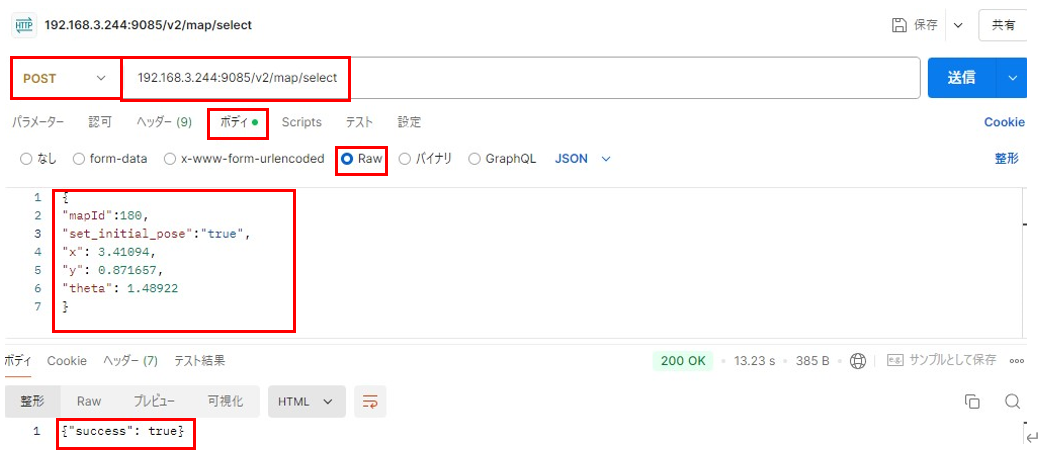
参考コード例 Python
import requests #「requests」ライブラリのインストールが必要です
import json
url = 'http://xxx.xxx.x.xxx:9085/v2/map/select' #IPアドレスを入力
params = {
"mapId":xxx, #mapIdを入力
"set_initial_pose":<bool>, #イニシャルポジションを有効/無効
"x": xxx, #イニシャルポジションのx座標
"y": xxx, #イニシャルポジションのx座標
"theta": xxx #イニシャルポジションの向き
}
res = requests.post(url, json=params)
data = json.loads(res.text)
print(data)参考コード例 Javascript
<script>
let request = new XMLHttpRequest();
request.open("POST", "http://xxx.xxx.x.xxx:9085/v2/map/select", true); //IPアドレスを入力
request.setRequestHeader("content-type", "application/json;charset=UTF-8");
request.responseType = "json";
let body = {
mapId: xxx, // mapIdを入力
set_initial_pose: <bool>, //</bool>イ ニシャルポジションを有効/無効
x: xxx, //</float64>イニシャルポジションのx座標
y: xxx, //</float64>イニシャルポジションのx座標
theta: xxx //</float64>イニ/シャルポジションの向き
};
request.send(JSON.stringify(body));
request.onload = function () {
window.alert(JSON.stringify(this.response));
};
</script>M2-2 名前でマップの選択
| Path | Method | Function |
|---|---|---|
| /v2/map/select_by_name | POST | 名前を指定してマップを選択する |
「M10: マップデータの走行可能領域を変更」/v2/map/map_edits「M11: マップデータの走行不可領域を変更」/v2/map/virtual_obstacles「M12: マップデータの減速エリアを変更」/v2/map/speed_limit_zones「M13: マップデータのランドマークを変更」/v2/map/landmarks
を送信後は、マップへ正しく反映させるために、必ず本APIを送信してください。
Request Body
{
"map_name":<string> #MapNameを入力
"set_initial_pose":<bool>, #イニシャルポジションを有効/無効
"x":<float64>, #イニシャルポジションのx座標
"y":<float64>, #イニシャルポジションのx座標
"theta":<float64> #イニシャルポジションの向き}Response Body
{
"success":<bool>
}APIプラットフォーム(例:Postman)
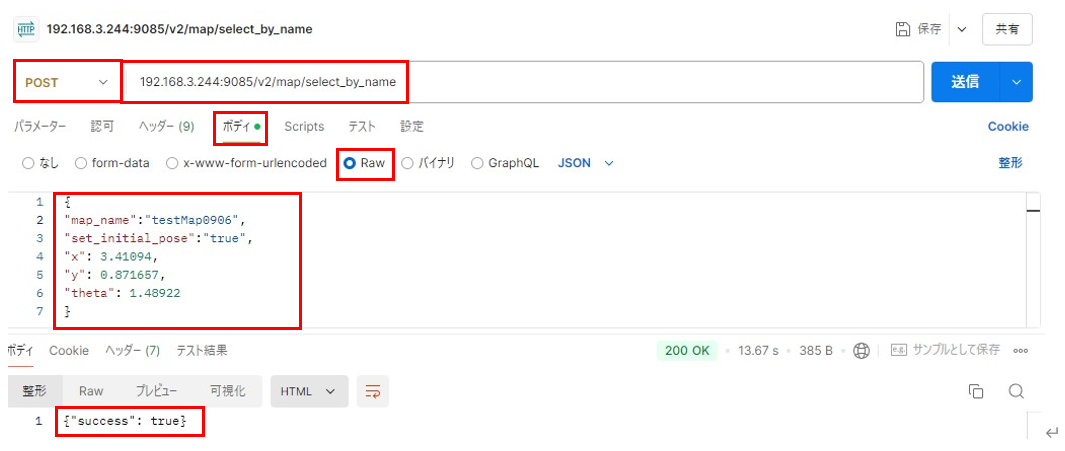
参考コード例 Python
import requests #「requests」ライブラリのインストールが必要です
import json
url = 'http://xxx.xxx.x.xxx:9085/v2/map/select' #IPアドレスを入力
params = {
"map_name":xxx, #map名を入力
"set_initial_pose":<bool>, #イニシャルポジションを有効/無効
"x": xxx, #イニシャルポジションのx座標
"y": xxx, #イニシャルポジションのx座標
"theta": xxx #イニシャルポジションの向き
}
res = requests.post(url, json=params)
data = json.loads(res.text)
print(data)参考コード例 Javascript
<script>
let request = new XMLHttpRequest();
request.open("POST", "http://xxx.xxx.x.xxx:9085/v2/map/select_by_name”, true); //IPアドレスを入力
request.setRequestHeader(“content-type”, “application/json;charset=UTF-8”);
request.responseType = “json”;
let body = {
map_name: xxx, // map名を入力
set_initial_pose: <bool>, //</bool>イ ニシャルポジションを有効/無効
x: xxx, //</float64>イニシャルポジションのx座標
y: xxx, //</float64>イニシャルポジションのx座標
theta: xxx, //</float64>イニ/シャルポジションの向き
};
request.send(JSON.stringify(body));
request.onload = function () {
window.alert(JSON.stringify(this.response));
};
</script>M3 現在位置の設定
| Path | Method | Function |
|---|---|---|
| /v2/map/initial_position | POST | 選択中のマップに対して⾃機の現在位置を設定する |
Request Body
{
"x": <float32> # ros_native_x, (マシン相対座標)
"y": <float32> # ros_native_y, (マシン相対座標)
"theta": <float32> # Machine angle (radian) (実機の⽅向)
}Response Body
{
"success":<bool>
}APIプラットフォーム(例:Postman)
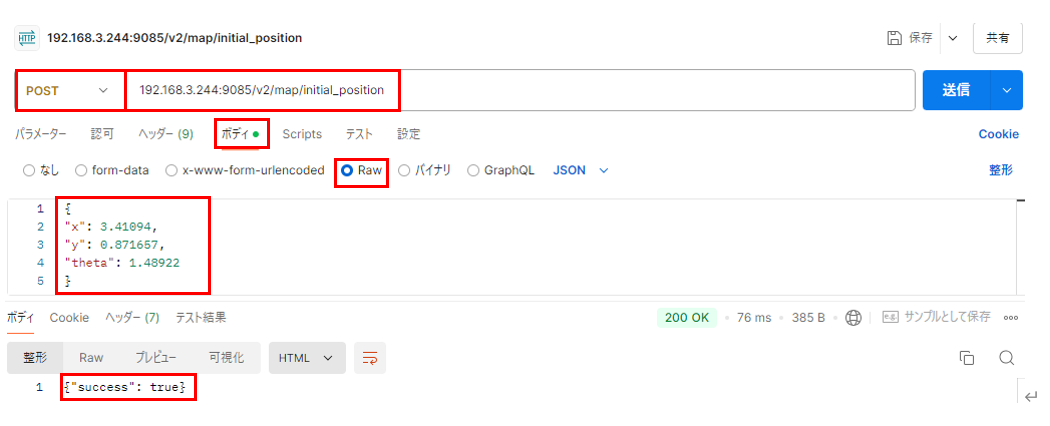
参考コード例 Python
import requests #「requests」ライブラリのインストールが必要です
import json
url = 'http://xxx.xxx.x.xxx:9085/v2/map/initial_position' #IPアドレスを入力
params = {
"x": xxx, #イニシャルポジションのx座標
"y": xxx, #イニシャルポジションのx座標
"theta": xxx #イニシャルポジションの向き
}
res = requests.post(url, json=params)
data = json.loads(res.text)
print(data)参考コード例 Javascript
<script>
let request = new XMLHttpRequest();
request.open("POST", "http://xxx.xxx.x.xxx:9085/v2/map/initial_position", true); //IPアドレスを入力
request.setRequestHeader("content-type", "application/json;charset=UTF-8");
request.responseType = "json";
let body = {
x: xxx, //</float64>イニシャルポジションのx座標
y: xxx, //</float64>イニシャルポジションのx座標
theta: xxx, //</float64>イニ/シャルポジションの向き
};
request.send(JSON.stringify(body));
request.onload = function () {
window.alert(JSON.stringify(this.response));
};
</script>M4-1 マップの取得
| Path | Method | Function |
|---|---|---|
| /v2/map | GET | 指定idのマップを取得する |
Request Body
{
"mapId":<int32>
}Response Body
{
"info": <string>, #map info reservation. Not used.
"map": <string (base64)>, #map png
"name": <string>, #map name
"success" : <bool>, #true:Done, false:failure
“landmarks”:[
{
“info”:<string>, #Not used.
“other:{“defaultHome”:<bool>}, #Default setting
“name”:<string>, #landmark name
“location”:{
“y”:<float32>, #y, (マップ原点に対するlandmark座標)
“x”:<float32>, #x, (マップ原点に対するlandmark座標)
“theta”:<float32> #angle (radian) (Landmarkの⽅向)
}
}
],
"map_edits": <string (base64)>, #edits png
"virtual_obstacles": <string (base64)>, #obst png
"map_h: <uint32>, #ADD map png width pixel
"yaml": <string>, #map yaml including origin and resolution}
“speed_limit_zones”:[
{
“color”<color hex code>, #color of speed limit zone
“speed”:<float32>, #setting spped of speed limit zone
“zone:[
[<float32>,<float32>] #corner1 of speed limit zone
[<float32>,<float32>] #corner2 of speed limit zone
[<float32>,<float32>] #corner3 of speed limit zone
[<float32>,<float32>] #corner4 of speed limit zone
}
],
"map_w: <uint32>, #ADD map png width pixel
"iniYaml": <string>, #initial_pose yaml
"id" : <uint32> #map id
}APIプラットフォーム(例:Postman)
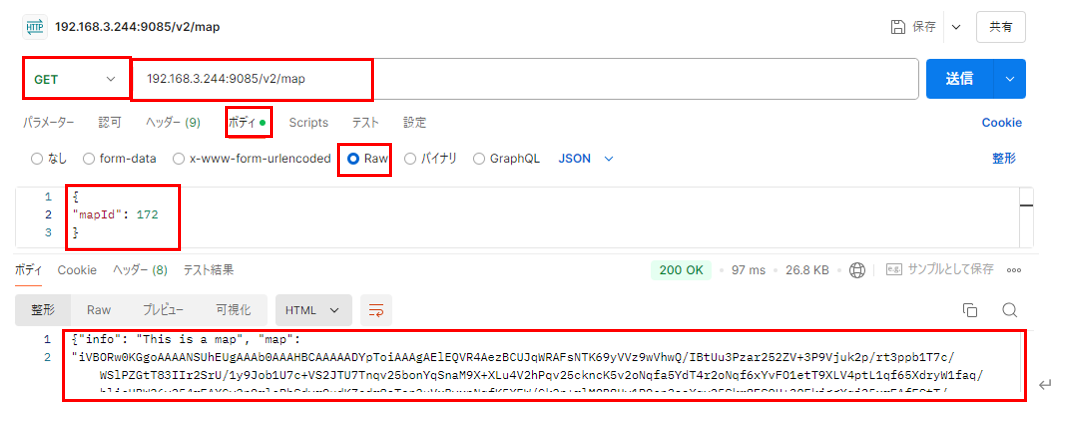
参考コード例 Python
import requests #「requests」ライブラリのインストールが必要です
import json
url = 'http://xxx.xxx.x.xxx:9085/v2/map' #IPアドレスを入力
params = {'mapId':xxx} #mapIdを入力
res = requests.get(url, json=params)
data = json.loads(res.text)
print(data)参考コード例 Javascript
<script>
let request = new XMLHttpRequest();
request.open('GET', 'http://xxx:.xxx.x.xxx:9085/v2/map?mapId=xxx', true); //IPアドレス, mapIdを入力
request.setRequestHeader('content-type', 'application/json;charset=UTF-8');
request.responseType = 'json';
request.send();
request.onload = function() {
window.alert( JSON.stringify( this.response ) );
};
</script>NG例
request.open('GET', 'http://192.XXX.X.XX:9085/v2/map, true);
request.setRequestHeader('content-type', 'application/json;charset=UTF-8');
request.responseType = 'json';
request.send(JSON.stringify({mapId:XXX})); //GETメソッドでは引数をBodyにして送信できません説明
info : 拡張予約
map: マップの画像データ (拡張子 png)
name : マップ名
success : コマンド成功・失敗
landmarks: ランドマーク位置情報
map_edits: マップの形状編集データ (拡張子 png)
virtual_obstacles: 走行不可領域のデータ (拡張子 png)
map_h: マップ高さ(単位 pixel)
yaml: マップ原点情報と解像度情報を含む
speedlimitzones: 減速エリア領域情報
map_w: マップ幅(単位 pixel)
iniYaml: AMR初期位置情報
id : マップid
yaml について
KeiganALI でマップを作成した場合⾃動で⽣成され、マップに紐付けられる。以下のようなデータとなる。
image: map.png #マップの画像データ名
resolution: 0.050000 #地図の解像度(5cm=0.05), 固定値
origin: [-8.000000, -11.200000, 0.000000] #マップの原点座標resolution は 0.05 (単位 m) 固定。
origin は、マップ原点に対する、マップ左下のコーナー点の座標(マップ原点の定義)となる。
詳細は後半「座標指定について」を参照下さい。
M4-2 マップ名で、マップを取得
| Path | Method | Function |
|---|---|---|
| /v2/map | GET | 指定マップ名のマップを取得する |
Request Body
{
"map_name":<string>
}Response Body
{
"info": <string>, #map info reservation. Not used.
"map": <string (base64)>, #map png
"name": <string>, #map name
"success" : <bool>, #true:Done, false:failure
“landmarks”:[
{
“info”:<string>, #Not used.
“other:{“defaultHome”:<bool>}, #Default setting
“name”:<string>, #landmark name
“location”:{
“y”:<float32>, #y, (マップ原点に対するlandmark座標)
“x”:<float32>, #x, (マップ原点に対するlandmark座標)
“theta”:<float32> #angle (radian) (Landmarkの⽅向)
}
}
],
"map_edits": <string (base64)>, #edits png
"virtual_obstacles": <string (base64)>, #obst png
"map_h: <uint32>, #ADD map png width pixel
"yaml": <string>, #map yaml including origin and resolution}
“speed_limit_zones”:[
{
“color”<color hex code>, #color of speed limit zone
“speed”:<float32>, #setting spped of speed limit zone
“zone:[
[<float32>,<float32>] #corner1 of speed limit zone
[<float32>,<float32>] #corner2 of speed limit zone
[<float32>,<float32>] #corner3 of speed limit zone
[<float32>,<float32>] #corner4 of speed limit zone
}
],
"map_w: <uint32>, #ADD map png width pixel
"iniYaml": <string>, #initial_pose yaml
"id" : <uint32> #map id
}APIプラットフォーム(例:Postman)
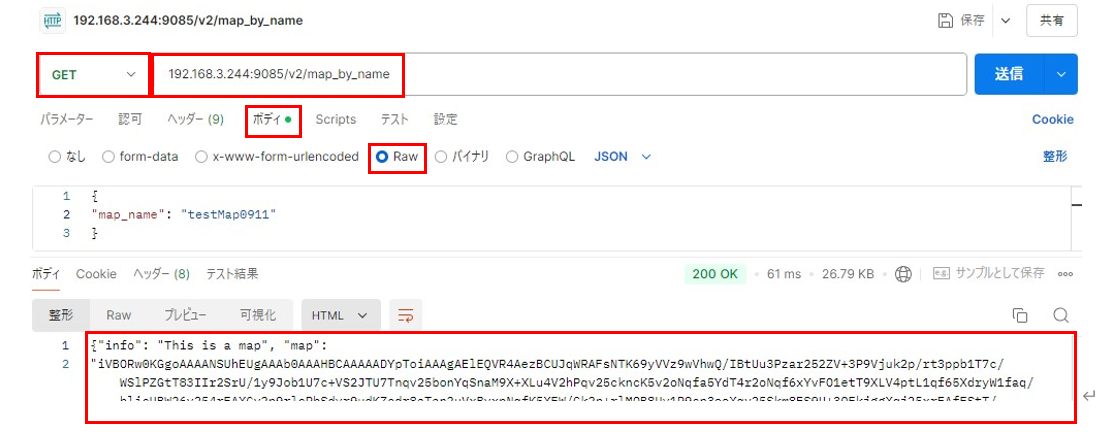
参考コード例 Python
import requests #「requests」ライブラリのインストールが必要です
import json
url = 'http://xxx.xxx.x.xxx:9085/v2/map_by_name' #IPアドレスを入力
params = {'map_name':"xxx"} #mapIdを入力
res = requests.get(url, json=params)
data = json.loads(res.text)
print(data)参考コード例 Javascript
<script>
let request = new XMLHttpRequest();
request.open("GET", "http://xxx.xxx.x.xxx:9085/v2/map_by_name", true); //IPアドレスを入力
request.setRequestHeader("content-type", "application/json;charset=UTF-8");
request.responseType = "json";
let body = { map_name: "xxx" }; //マップ名を入力
request.send(JSON.stringify(body));
request.onload = function () {
window.alert(JSON.stringify(this.response));
};
</script>NG例
request.open('GET', 'http://192.XXX.X.XX:9085/v2/map, true);
request.setRequestHeader('content-type', 'application/json;charset=UTF-8');
request.responseType = 'json';
request.send(JSON.stringify({map_name:XXX})); //GETメソッドでは引数をBodyにして送信できませんM5-1 マップの削除
| Path | Method | Function |
|---|---|---|
| /v2/map | DELETE | 指定idのマップを削除 |
Request Body
{
"mapId": <int32>
}Response Body
{
"success": <bool>
}APIプラットフォーム(例:Postman)
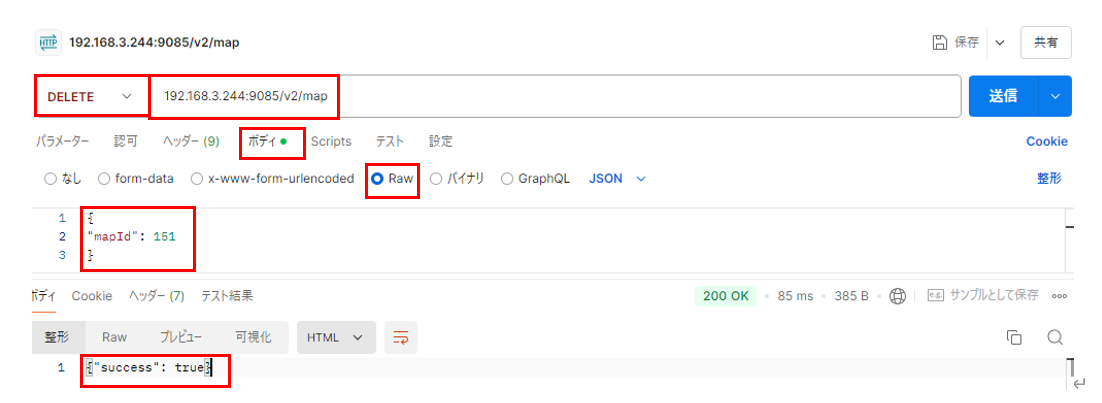
参考コード例 Python
import requests #「requests」ライブラリのインストールが必要です
import json
url = 'http://xxx.xxx.x.xxx:9085/v2/map' #IPアドレスを入力
params = { "mapId":xxx } #mapIdを入力
res = requests.delete(url, json=params)
data = json.loads(res.text)
print(data)参考コード例 Javascript
<script>
let request = new XMLHttpRequest();
request.open("DELETE", "http://xxx.xxx.x.xxx:9085/v2/map", true); //IPアドレスを入力
request.setRequestHeader("content-type", "application/json;charset=UTF-8");
request.responseType = "json";
let body = { mapId: xxx }; //mapIdを入力
request.send(JSON.stringify(body));
request.onload = function () {
window.alert(JSON.stringify(this.response));
};
</script>M5-2 マップの追加
| Path | Method | Function |
|---|---|---|
| /v2/map | POST | マップを追加する |
Request Body
{
"map_name": <string> #map name
"map": <string(base64)> #map png
"map_edits": < string(base64)> #edits png
"virtual_obstacles": < string(base64)> #obst png
"map_yaml": <string> #map yaml including origin and resolution
"init_yaml": <string> #initial_pose yaml
“landmarks”:[
{
“info”:<string>, #landmark info reservation. Not used.
“other:{“defaultHome”:<bool>}, #Default setting
“name”:<string>, #landmark name
“location”:{
“y”:<float32>, #y, (マップ原点に対するlandmark座標) “x”:<float32>, #x, (マップ原点に対するlandmark座標)
“theta”:<float32> #angle (radian) (Landmarkの⽅向)
}
}
] ,
“speed_limit_zones”:[
{
“color”<color hex code>, #color of speed limit zone
“speed”:<float32>, #setting spped of speed limit zone
“zone:[
[<float32>,<float32>] #corner1 of speed limit zone
[<float32>,<float32>] #corner2 of speed limit zone
[<float32>,<float32>] #corner3 of speed limit zone
[<float32>,<float32>] #corner4 of speed limit zone
}
]
}Response Body
{
"mapId": <int32>
"success": <bool>
}APIプラットフォーム(例:Postman)
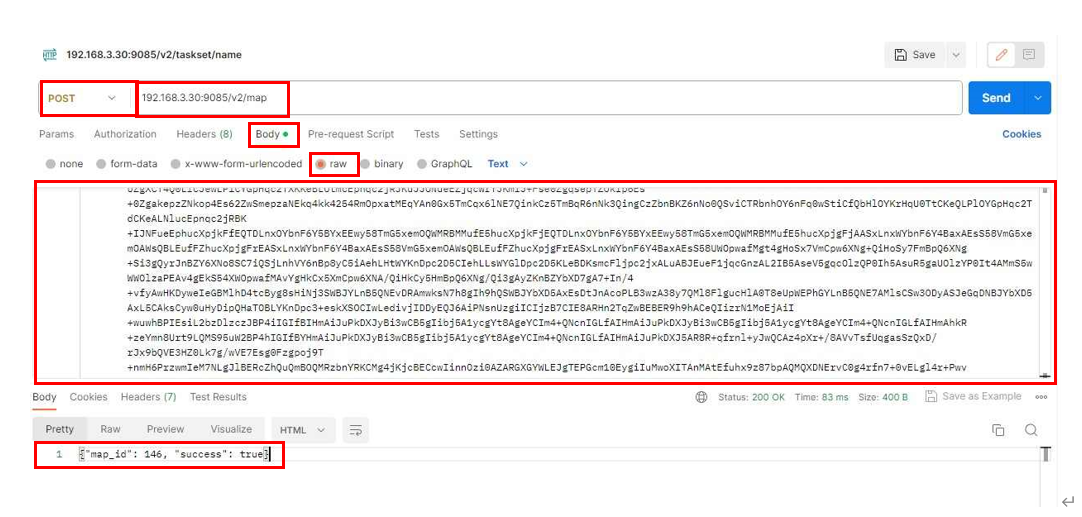
参考コード例 Python
import requests #「requests」ライブラリのインストールが必要です
import json
url = 'http://192.XXX.X.XX:9085/v2/map' #IPアドレスを入力
params = {
"map_name":XXX.png, #任意のマップ名を入力
"map":"iVB0Rw0KGg~~中省略~~SuQmCC", #追加するマップデータ(png)
"map_edits":"", #追加する走行可能領域のマップデータ(png), 必要な場合のみ
"virtual_obstacles":"", #追加する走行不可領域のマップデータ(png), 必要な場合のみ
"map_yaml":"image: map.png\nresolution: 0.050000\norigin: [-6.400000, -9.600000, 0.000000]\nnegate: 0\noccupied_thresh: 0.65\nfree_thresh: 0.196\n",
#originの値のみ変更可, 他は固定値
"init_yaml":"initial_pos_x: 0.11\ninitial_pos_y: 0.15\ninitial_pos_a: -3.00\n"
#KeiganALIの初期位置情報, 必要な場合のみ
}
res = requests.post(url, json=params)
data = json.loads(res.text)
print(data)参考コード例 Javascript
<script>
let request = new XMLHttpRequest();
request.open('POST', 'http://192.XXX.X.XX:9085/v2/map', true); #IPアドレスを入力
request.setRequestHeader('content-type', 'application/json;charset=UTF-8');
request.responseType = 'json';
let body = {
'map_name':XXX.png, #任意のマップ名を入力
'map':"iVB0Rw0KGg~~中省略~~SuQmCC", #追加するマップデータ(png)
'map_edits':"", #追加する走行可能領域のマップデータ(png), 必要な場合のみ
'virtual_obstacles':"", #追加する走行不可領域のマップデータ(png), 必要な場合のみ
'map_yaml':"image: map.png\nresolution: 0.050000\norigin: [-6.400000, -9.600000, 0.000000]\nnegate: 0\noccupied_thresh: 0.65\nfree_thresh: 0.196\n",
#originの値のみ変更可, 他は固定値
'init_yaml':"initial_pos_x: 0.11\ninitial_pos_y: 0.15\ninitial_pos_a: -3.00\n"
#KeiganALIの初期位置情報, 必要な場合のみ
};
request.send(JSON.stringify(body));
request.onload = function() {
window.alert( JSON.stringify( this.response ) );
};
</script>M6 マップスキャンの開始、中止
| Path | Method | Function |
|---|---|---|
| /v2/map/mapping/start | POST | マップのスキャンの開始・中止 |
Request Body
{
"type": <uint32> // 1:start, 2:stop
}Response Body
{
"success": <bool>
}APIプラットフォーム(例:Postman)
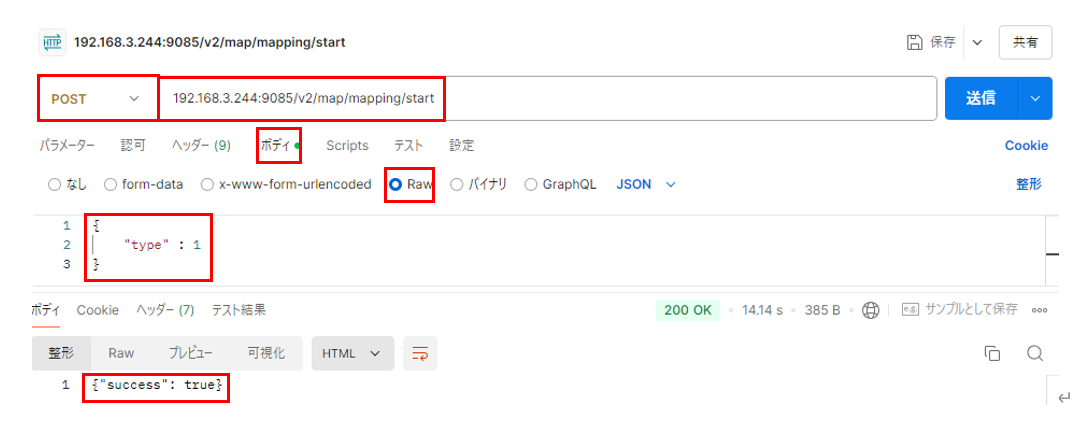
参考コード例 Python
import requests #「requests」ライブラリのインストールが必要です
import json
url = 'http://xxx.xxx.x.xxx:9085/v2/map/mapping/start' #IPアドレスを入力
params = {
"type":x #マップスキャンの開始:1 , 中止2
}
res = requests.post(url, json=params)
data = json.loads(res.text)
print(data)参考コード例 Javascript
<script>
let request = new XMLHttpRequest();
request.open('POST', 'http://xxx.xxx.x.xxx:9085/v2/map/mapping/start', true); //IPアドレスを入力
request.setRequestHeader('content-type', 'application/json;charset=UTF-8');
request.responseType = 'json';
let body = {
'type':1 //マップスキャンの開始:1 , 中止2
};
request.send(JSON.stringify(body));
request.onload = function() {
window.alert( JSON.stringify( this.response ) );
};
</script>M7 スキャンしたマップの保存
| Path | Method | Function |
|---|---|---|
| /v2/map/mapping/save_map | POST | スキャンしたマップの保存 |
Request Body
{
"mapName": <string> #マップ名
}Response Body
{
"success": <bool>
"mapId": <int32>
}APIプラットフォーム(例:Postman)
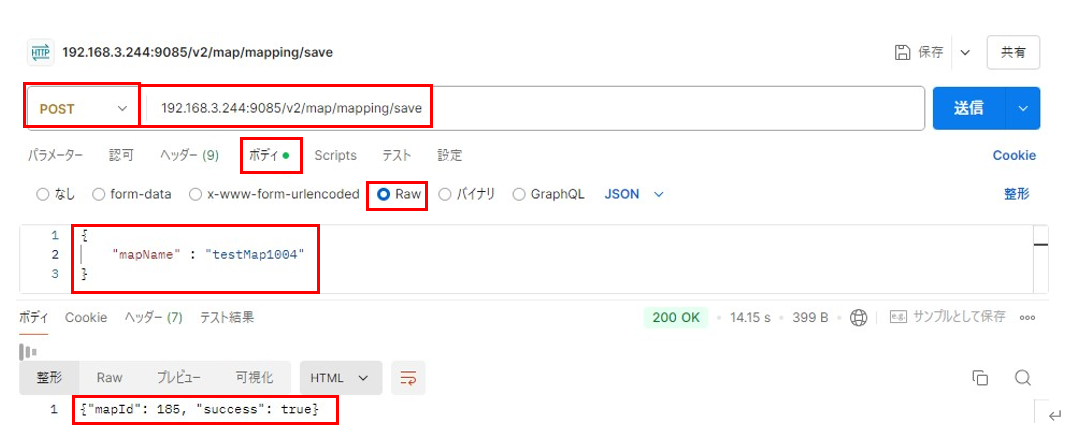
参考コード例 Python
import requests #「requests」ライブラリのインストールが必要です
import json
url = 'http://xxx.xxx.x.xxx:9085/v2/map/mapping/save' #IPアドレスを入力
params = {
"mapName":"xxx" #追加したいマップ名を入力
}
res = requests.post(url, json=params)
data = json.loads(res.text)
print(data)参考コード例 Javascript
<script>
let request = new XMLHttpRequest();
request.open('POST', 'http://xxx.xxx.x.xxx:9085/v2/map/mapping/save', true); //IPアドレスを入力
request.setRequestHeader('content-type', 'application/json;charset=UTF-8');
request.responseType = 'json';
let body = {
'mapName':"xxx" //追加したいマップ名を入力
};
request.send(JSON.stringify(body));
request.onload = function() {
window.alert( JSON.stringify( this.response ) );
};
</script>M8 マップデータを変更
| Path | Method | Function |
|---|---|---|
| /v2/map/map | PUT | 指定idのマップを変更する |
Request Body
{
"mapId": <int32> #map id
"map": <uint8[]> #map png
}Response Body
{
"success": <bool>
}APIプラットフォーム(例:Postman)
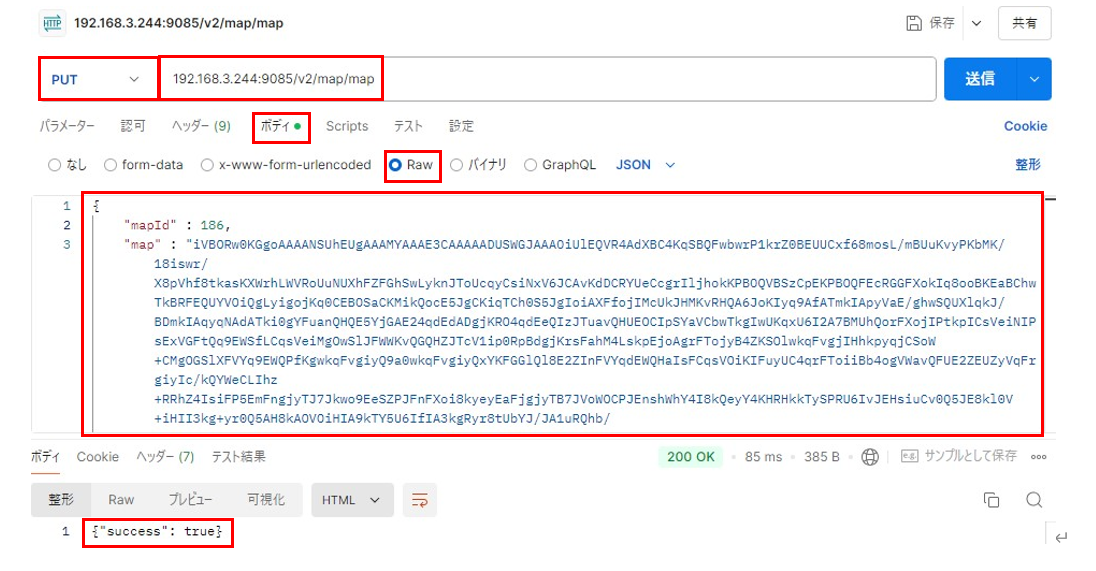
参考コード例 Python
import requests #「requests」ライブラリのインストールが必要です
import json
url = 'http://xxx.xxx.x.xxx:9085/v2/map/map' #IPアドレスを入力
params = {
"mapId":xxx, #任意のmapIdを入力
"map": "iVB0Rw0KGg~~中省略~~SuQmCC" #追加するマップデータ(png)
}
res = requests.put(url, json=params)
data = json.loads(res.text)
print(data)参考コード例 Javascript
<script>
let request = new XMLHttpRequest();
request.open('PUT', 'http://xxx.xxx.x.xxx:9085/v2/map/map', true); #IPアドレスを入力
request.setRequestHeader('content-type', 'application/json;charset=UTF-8');
request.responseType = 'json';
let body = {
'mapId':xxx, //任意のmapIdを入力
'map':"iVB0Rw0KGg~~中省略~~SuQmCC" //追加するマップデータ(png)
};
request.send(JSON.stringify(body));
request.onload = function() {
window.alert( JSON.stringify( this.response ) );
};
</script>M9 マップデータの名前を変更
| Path | Method | Function |
|---|---|---|
| /v2/map/name | PUT | 指定idのマップの名前を変更する |
Request Body
{
"mapId": <int32> #map id
"name": <string> #map name
}Response Body
{
"success": <bool>
}APIプラットフォーム(例:Postman)
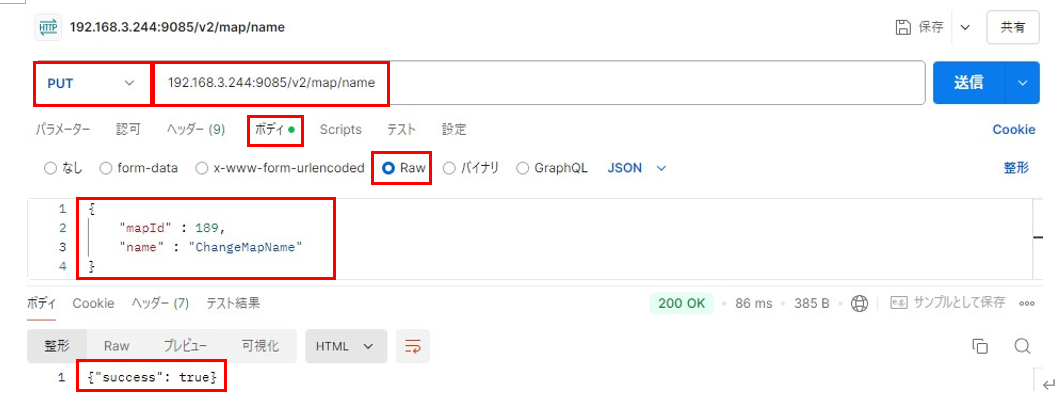
参考コード例 Python
import requests #「requests」ライブラリのインストールが必要です
import json
url = 'http://xxx.xxx.x.xxx:9085/v2/map/name' #IPアドレスを入力
params = {
"mapId":xxx, #変更するmapIdを入力
"name":"ABCD" #変更したいマップの名前を入力
}
res = requests.put(url, json=params)
data = json.loads(res.text)
print(data)参考コード例 Javascript
<script>
let request = new XMLHttpRequest();
request.open('PUT', 'http://xxx.xxx.x.xxx:9085/v2/map/name', true); //IPアドレスを入力
request.setRequestHeader('content-type', 'application/json;charset=UTF-8');
request.responseType = 'json';
let body = {
'mapId':xxx, //任意のmapIdを入力
'name':"ABCD" //変更したいマップの名前を入力
};
request.send(JSON.stringify(body));
request.onload = function() {
window.alert( JSON.stringify( this.response ) );
};
</script>M10 マップデータの走行可能領域を変更
| Path | Method | Function |
|---|---|---|
| /v2/map/map_edits | PUT | 指定idのマップデータの走行可能領域を変更 |
コマンドを送信しないと、正しくマップへ反映されません。
Request Body
{
"mapId": <int32> #map id
"map_edits": <string(base64)> #map_edits png
}Response Body
{
"success": <bool>
}APIプラットフォーム(例:Postman)
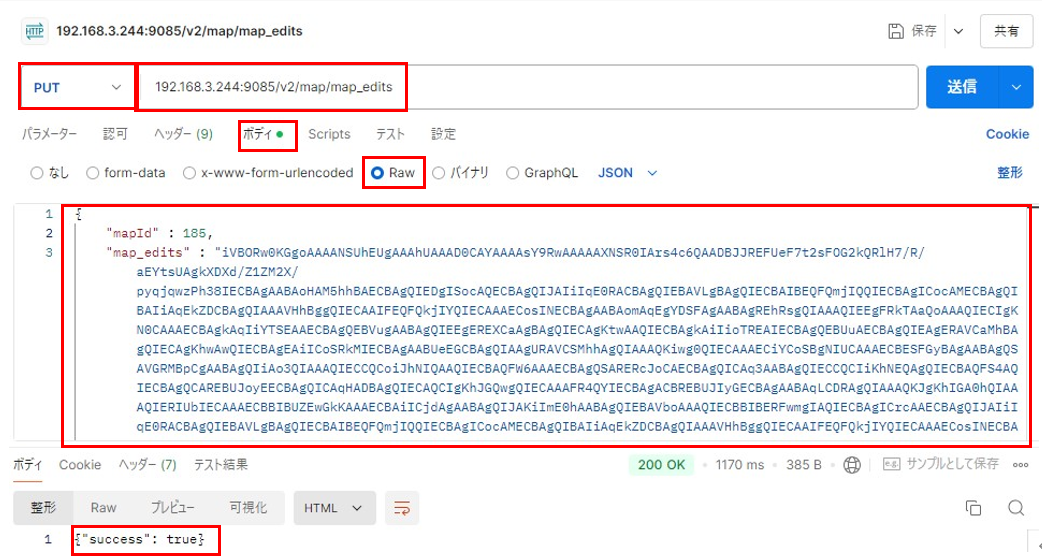
参考コード例 Python
import requests #「requests」ライブラリのインストールが必要です
import json
url = 'http://xxx.xxx.x.xxx:9085/v2/map/map_edits' #IPアドレスを入力
params = {
"mapId":xxx, #任意のmapIdを入力
"map_edits":"iVB0Rw0KGg~~中省略~~SuQmCC" #追加する走行可能領域のマップデータ(png)
}
res = requests.put(url, json=params)
data = json.loads(res.text)
print(data)参考コード例 Javascript
<script>
let request = new XMLHttpRequest();
request.open('PUT', 'http://xxx.xxx.x.xxx:9085/v2/map/map_edits', true); //IPアドレスを入力
request.setRequestHeader('content-type', 'application/json;charset=UTF-8');
request.responseType = 'json';
let body = {
'mapId':xxx, //任意のmapIdを入力
'map_edits':"iVB0Rw0KGg~~中省略~~SuQmCC" //追加する走行可能領域のマップデータ(png)
};
request.send(JSON.stringify(body));
request.onload = function() {
window.alert( JSON.stringify( this.response ) );
};
</script>M11 マップデータの走行不可領域を変更
| Path | Method | Function |
|---|---|---|
| /v2/map/virtual_obstacles | PUT | 指定idのマップデータの走行不可領域を変更 |
コマンドを送信しないと、正しくマップへ反映されません。
Request Body
{
"mapId": <int32> #map id
"virtual_obstacles": <string(base64)> #virtual_obstacles png
}Response Body
{
"success": <bool>
}APIプラットフォーム(例:Postman)
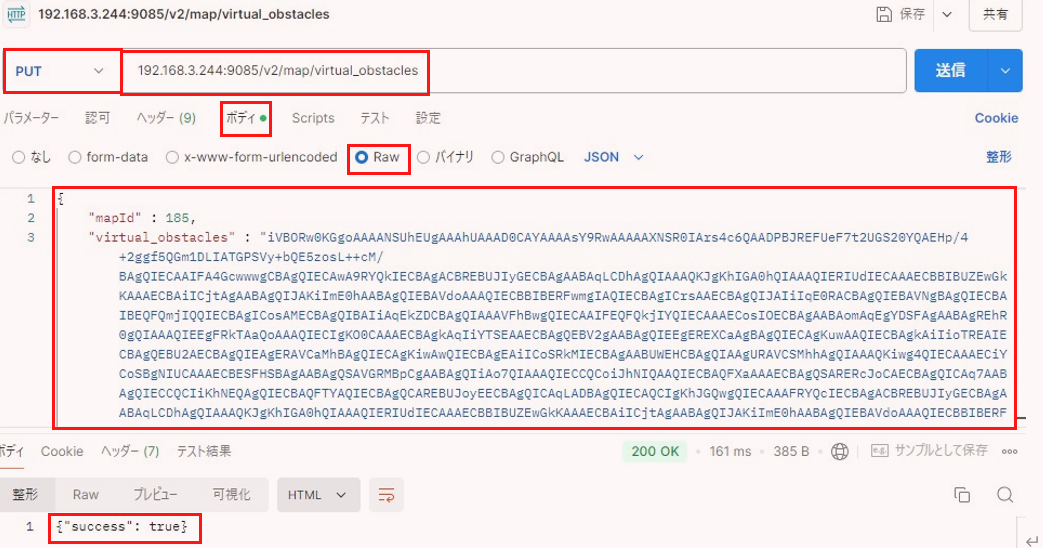
参考コード例 Python
import requests #「requests」ライブラリのインストールが必要です
import json
url = 'http://xxx.xxx.x.xxx:9085/v2/map/virtual_obstacles' #IPアドレスを入力
params = {
"mapId":xxx, #任意のmapIdを入力
"virtual_obstacles":"iVB0Rw0KGg~~中省略~~SuQmCC" #追加する走行不可領域のマップデータ(png)
}
res = requests.put(url, json=params)
data = json.loads(res.text)
print(data)参考コード例 Javascript
<script>
let request = new XMLHttpRequest();
request.open('PUT', 'http://xxx.xxx.x.xxx:9085/v2/map/virtual_obstacles', true); //IPアドレスを入力
request.setRequestHeader('content-type', 'application/json;charset=UTF-8');
request.responseType = 'json';
let body = {
'mapId':xxx, //任意のmapIdを入力
'virtual_obstacles':"iVB0Rw0KGg~~中省略~~SuQmCC" //追加する走行不可領域のマップデータ(png)
};
request.send(JSON.stringify(body));
request.onload = function() {
window.alert( JSON.stringify( this.response ) );
};
</script>M12 マップデータの減速エリアを変更
| Path | Method | Function |
|---|---|---|
| /v2/map/speed_limit_zones | PUT | 指定idのマップデータの走行不可領域を変更 |
コマンドを送信しないと、正しくマップへ反映されません。
Request Body
{
"mapId": <int32> #map id
"zones":[
{
“color”:<string, hex color>,
“speed”:<float64>,
“zone”[
[<float64>,<float64>],[<float64>,<float64>],[<float64>,<float64>],[<float64>,<float64>]
]
}
.
.
“color”:<string, hex color>,
“speed”:<float64>,
“zone”[
[<float64>,<float64>],[<float64>,<float64>],[<float64>,<float64>],[<float64>,<float64>]
]
}
]Response Body
{
"success": <bool>
}APIプラットフォーム(例:Postman)
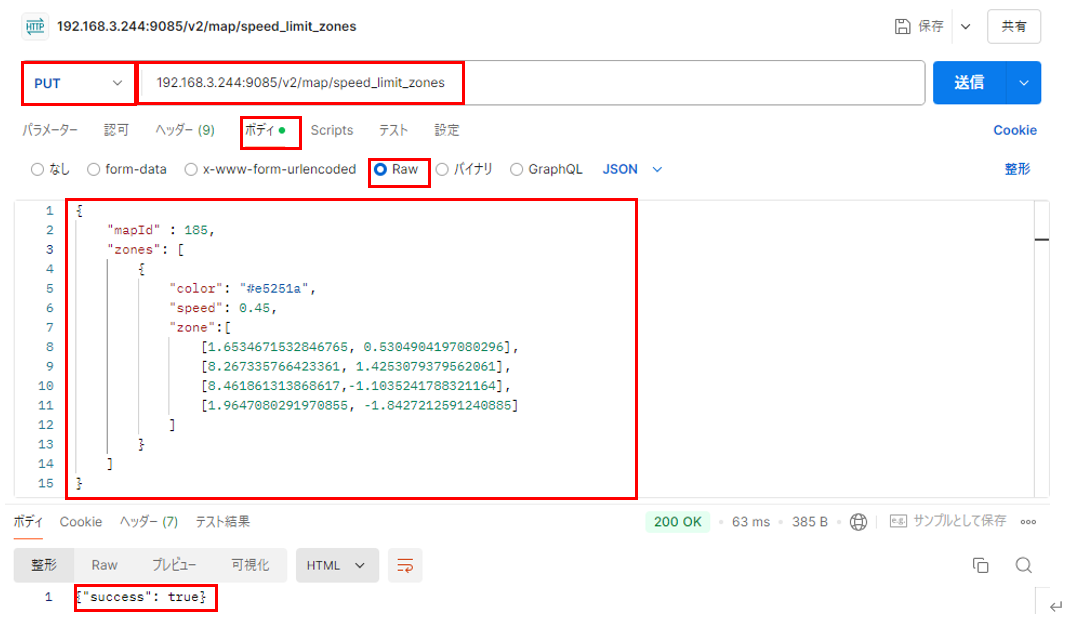
参考コード例 Python
import requests #「requests」ライブラリのインストールが必要です
import json
url = 'http://xxx.xxx.x.xxx:9085/v2/map/speed_limit_zones' #IPアドレスを入力
params = {
"mapId":xxx, #任意のmapIdを入力
"zones": [ #任意の色、速度、領域を入力
{
"color": "#xxx",
"speed": xxx,
"zone":[
[xxxx, xxxx],
[xxxx xxxx],
[xxxx,xxxx],
[xxxx,xxxx]
]
}
]
}
res = requests.put(url, json=params)
data = json.loads(res.text)
print(data))参考コード例 Javascript
<script>
let request = new XMLHttpRequest();
request.open("PUT", "http://xxx.xxx.x.xxx:9085/v2/map/speed_limit_zones", true); //IPアドレスを入力
request.setRequestHeader("content-type", "application/json;charset=UTF-8");
request.responseType = "json";
let body = {
mapId: xxx, //任意のmapIdを入力
zones: [ //追加する減速エリアのマップデータ(color,speed,zone)
{
color: "#xxx",
speed: xxx,
zone: [
[xxx, xxx,
[xxx, xxx],
[xxx, xxx],
[xxx, xxx],
],
},
],
};
request.send(JSON.stringify(body));
request.onload = function () {
window.alert(JSON.stringify(this.response));M13 マップのランドマークを変更
| Path | Method | Function |
|---|---|---|
| /v2/map/landmarks | PUT | 指定idのマップデータの走行不可領域を変更 |
コマンドを送信しないと、正しくマップへ反映されません。
Request Body
{
"mapId": <int32> #map id
"landmarks":[
{
“info”:<string>, # reserve
“other”: {“defaultHome”:<boo;>},
“name”:<string>,
“location”:{
“x”:<float64>,
“y”:<float64>,
“theta”:<float64>
}
]
}Response Body
{
"success": <bool>
}APIプラットフォーム(例:Postman)
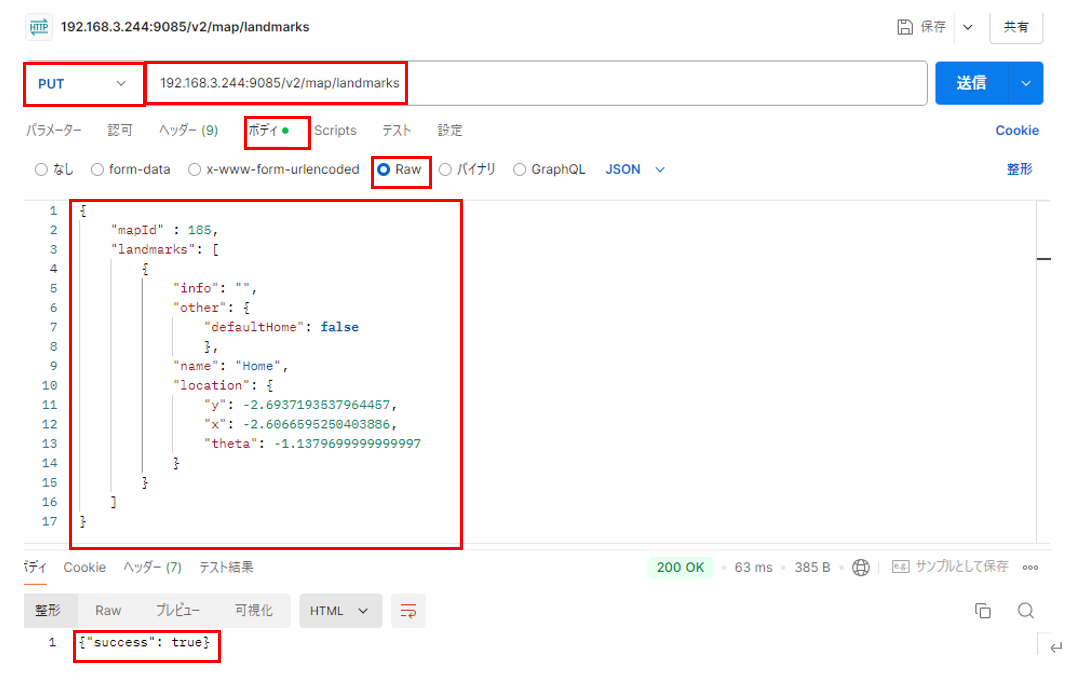
参考コード例 Python
import requests #「requests」ライブラリのインストールが必要です
import json
url = 'http://xxx.xxx.x.xxx:9085/v2/map/landmarks' #IPアドレスを入力
params = {
"mapId":xxx, #任意のmapIdを入力
"landmarks":[ #追加するランドマークのデータ()
{
“info”:<string>,
“other”: {“defaultHome”:<boo;>},
“name”:<string>,
“location”:{
“x”:<float64>,
“y”:<float64>,
“theta”:<float64>
}
}
]
}
res = requests.put(url, json=params)
data = json.loads(res.text)
print(data)参考コード例 Javascript
<script>
let request = new XMLHttpRequest();
request.open("PUT", "http://192.168.3.244:9085/v2/map/landmarks", true); //IPアドレスを入力
request.setRequestHeader("content-type", "application/json;charset=UTF-8");
request.responseType = "json";
let body = { //任意のmapIdを入力
mapId: xxx,
landmarks: [
{
info: "",
other: {
defaultHome: <bool>,
},
name: "xxx",
location: {
y: xxx,
x: xxx,
theta:xxx,
},
},
],
};
request.send(JSON.stringify(body));
request.onload = function () {
window.alert(JSON.stringify(this.response));
};
</script>
</script>STG1 KeiganALIの基本設定情報を取得
| Path | Method | Function |
|---|---|---|
| /v2/settings | GET | KeiganALIの基本情報を取得する |
Request Body: なし
Response Body
{
"message": {
"lineTracerKp": 0.003, #ライントレースゲインKp
"right_cliff_is_enabled": <bool>, #クリフセンサ(右)を有効
"left_cliff_is_enabled": <bool>, #クリフセンサ(左)を有効
"moveStraightControlKp": 200, #直進ゲインKp
"maxRunningSpeed": <float64>, #自動運転最高速度
"line_tracer_hsv_range": { #ライン検知HSV値
"h_max": <unit8>, #h(色相)最大値(0-179)
"h_min": <unit8>, #h(色相)最小値(0-179)
"s_max": <unit8> #s(彩度)最大値 (0-255)
"v_max": <unit8>, #v(明度)最大値(0-255)
"s_min": <unit8>, #s(色彩)最小値(0-255)
"v_min": <unit8> #v(明度)最小値(0-255)
},
"speakerVolume": <int32>, #音量設定
"maxRunningSpeedLowerLimit": <float64>, #自動運転 最低速度
"robot_radius": <float64>, #AMR半径
"manualControlRotationalSpeed": <float64>, #マニュアル操作 旋回速度
"moveStraightControlKd": 0, #直進ゲインKd
"manualControlTranslationalSpeed": 0.5, #マニュアル操作 最高速度
"lineTracerKi": <float64>, #ライントレースゲインKi
"lineTracerKd": <float64>, #ライントレースゲインKd
"mqttAddress": <string>, #mqttアドレス
"logRecording": <int32>, #ログ記録 1 or -1
"footprint": [ #フットプリントサイズ
[<float64>, <float64>],
[<float64>, <float64>],
[<float64>, <float64>],
[<float64>, <float64>]
],
"maxRunningSpeedUpperLimit": <float64>, #自動運転 最高速度
"moveStraightControlEnabled": <bool>, #直進ゲイン設定 有効/無効
"moveStraightControlKi": <float64>, #直進ゲインKi
},
"success": <bool> #レスポンス
}APIプラットフォーム(例:Postman)
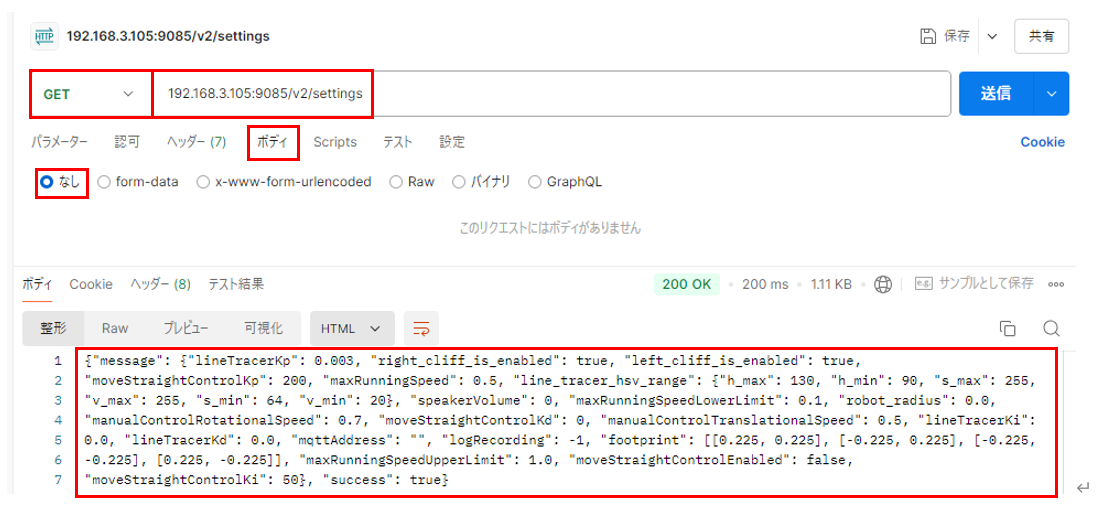
参考コード例 Python
import requests #「requests」ライブラリのインストールが必要です
import json
url = 'http://xxx.xxx.x.xxx:9085/v2/settings' #IPアドレスを入力
res = requests.get(url)
data = json.loads(res.text)
print(data)参考コード例 Javascript
<script>
let request = new XMLHttpRequest();
request.open('GET', 'http://xxx.xxx.x.xxx:9085/v2/settings', true); //IPアドレスを入力
request.setRequestHeader('content-type', 'application/json;charset=UTF-8');
request.responseType = 'json';
request.send();
request.onload = function() {
window.alert( JSON.stringify( this.response ) );
};
</script>STG2 KeiganALIの最高速度を変更
| Path | Method | Function |
|---|---|---|
| /v2/settings/max_speed | POST | KeiganALIの最高速度を変更する |
Request Body
{
"data": <float32> #max_speed: 0.5m/s *1m/sec対応(オプション)されたAliは、 max 1m/sec
}Response Body
{
"success": <bool>
}APIプラットフォーム(例:Postman)
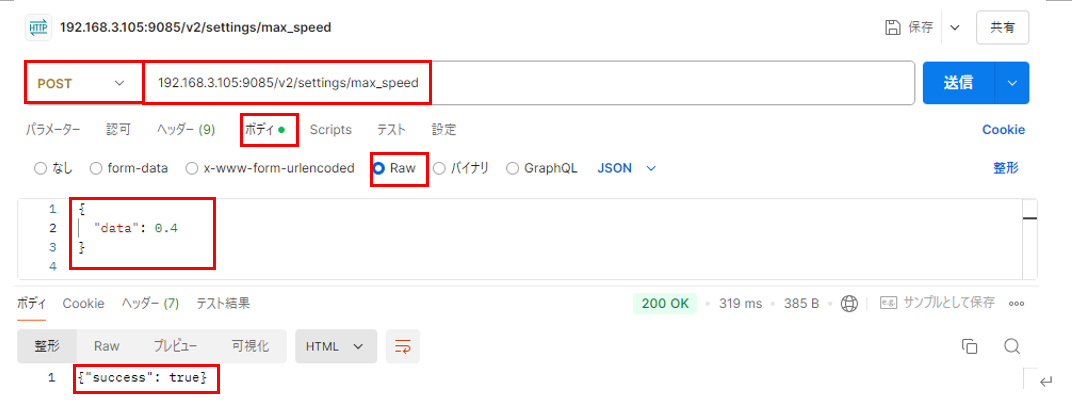
参考コード例 Python
import requests #「requests」ライブラリのインストールが必要です
import json
url = 'http://xxx.xxx.x.xxx:9085/v2/settings/max_speed' #IPアドレスを入力
params = {
"data":xxx, #ALIの最高速度を入力
}
res = requests.post(url, json=params)
data = json.loads(res.text)
print(data)参考コード例 Javascript
<script>
let request = new XMLHttpRequest();
request.open('POST', 'http://xxx.xxx.x.xxx:9085/v2/settings/max_speed', true); //IPアドレスを入力
request.setRequestHeader('content-type', 'application/json;charset=UTF-8');
request.responseType = 'json';
let body = {
'data':xxx, //ALIの最高速度を入力
};
request.send(JSON.stringify(body));
request.onload = function() {
window.alert( JSON.stringify( this.response ) );
};
</script>STG3 スピーカーの音量を変更
| Path | Method | Function |
|---|---|---|
| /v2/settings/speaker_volume | POST | KeiganALIのスピーカーの音量を変更する |
Request Body
{
"data": <int32> # 0 to 100
}Response Body
{
"success": <bool>
}APIプラットフォーム(例:Postman)
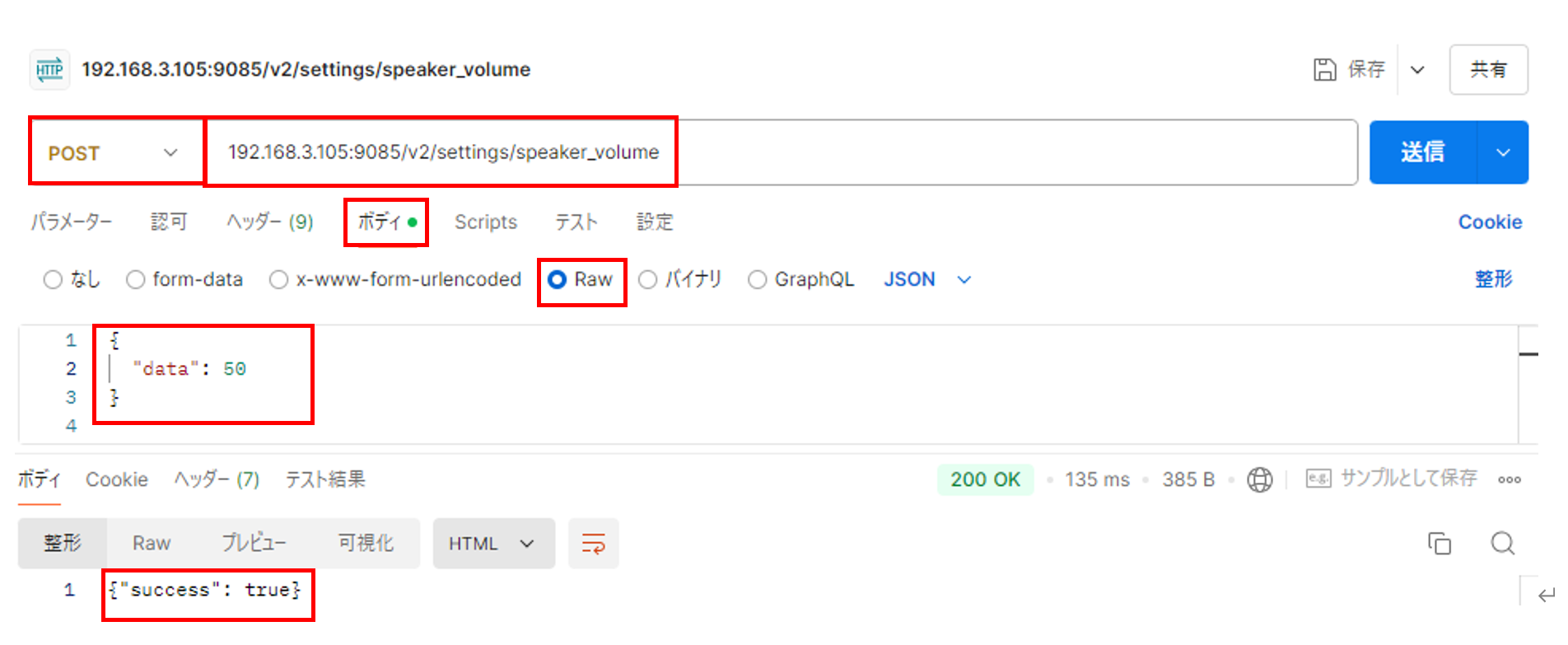
参考コード例 Python
import requests #「requests」ライブラリのインストールが必要です
import json
url = 'http://xxx.xxx.x.xxx:9085/v2/settings/speaker_volume' #IPアドレスを入力
params = {
"data":xxx, #スピーカーの音量を入力
}
res = requests.post(url, json=params)
data = json.loads(res.text)
print(data)参考コード例 Javascript
<script>
let request = new XMLHttpRequest();
request.open('POST', 'http://192.XXX.X.XX:9085/v2/settings/speaker_volume', true); //IPアドレスを入力
request.setRequestHeader('content-type', 'application/json;charset=UTF-8');
request.responseType = 'json';
let body = {
'data':xxx, //スピーカーの音量を入力
};
request.send(JSON.stringify(body));
request.onload = function() {
window.alert( JSON.stringify( this.response ) );
};
</script>STG4 フットプリントを設定
| Path | Method | Function |
|---|---|---|
| /v2/settings/amr_footprint | POST | KeiganALIのフットプリントの値を変更する |
Request Body
{
"footprint":[ #フットプリントの値を入力
[<string>, <string>],
[<string>, <string>],
[<string>, <string>],
[<string>, <string>]
],
"robot_radius": <float64>
}Response Body
{
"success": <bool>
}APIプラットフォーム(例:Postman)
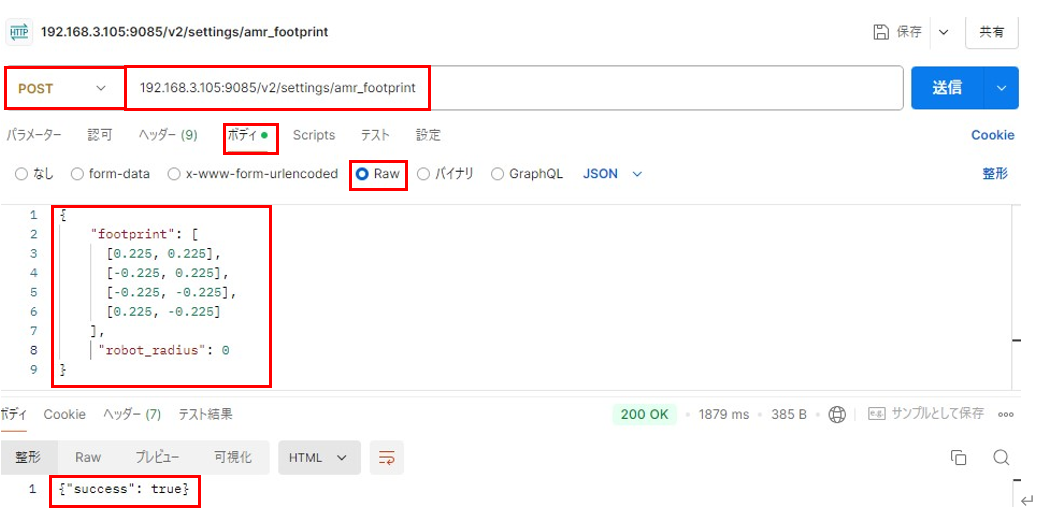
参考コード例 Python
import requests #「requests」ライブラリのインストールが必要です
import json
url = 'http://xxx.xxxx.x.xxx:9085/v2/settings/amr_footprint' #IPアドレスを入力
params = {
"footprint":[ #フットプリントの値を入力
[xxx, xxx],
[xxx, xxx],
[xxx, xxx],
[xxx, xxx]
],
"robot_radius":xxx
}
res = requests.post(url, json=params)
data = json.loads(res.text)
print(data)参考コード例 Javascript
<script>
let request = new XMLHttpRequest();
request.open('POST', 'http://xxx.xxx.x.xxx:9085/v2/settings/amr_footprint', true); //IPアドレスを入力
request.setRequestHeader('content-type', 'application/json;charset=UTF-8');
request.responseType = 'json';
let body = {
"footprint":[ //フットプリントの値を入力
[xxx, xxx],
[xxx, xxx],
[xxx, xxx],
[xxx, xxx]
],
"robot_radius":xxx
};
request.send(JSON.stringify(body));
request.onload = function() {
window.alert( JSON.stringify( this.response ) );
};
</script>STG5 JOG運転時の直進速度の変更
| Path | Method | Function |
|---|---|---|
| /v2/settings/manual_control/translational_speed | POST | JOG運転時の直進速度を変更する |
Request Body
{
"data": <float32> #設定可能範囲は0.05~0.5 [m/s]
}Response Body
{
"success": <bool>
}APIプラットフォーム(例:Postman)
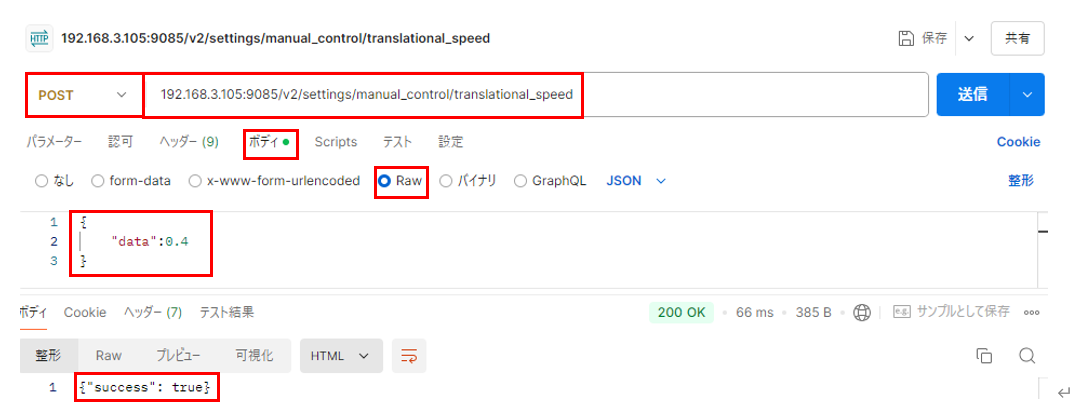
参考コード例 Python
import requests #「requests」ライブラリのインストールが必要です
import json
url = 'http://xxx.xxx.x.xxx:9085/v2/settings/manual_control/translational_speed' #IPアドレスを入力
params = {
"data":xxx, #マニュアル操作時の直進速度(単位:m/s)を設定
}
res = requests.post(url, json=params)
data = json.loads(res.text)
print(data)参考コード例 Javascript
<script>
let request = new XMLHttpRequest();
request.open('POST', 'http://xxx.xxx.x.xxx:9085/v2/settings/manual_control/translational_speed', true); //IPアドレスを入力
request.setRequestHeader('content-type', 'application/json;charset=UTF-8');
request.responseType = 'json';
let body = {
'data':xxx, //マニュアル操作時の直進速度(単位:m/s)を設定
};
request.send(JSON.stringify(body));
request.onload = function() {
window.alert( JSON.stringify( this.response ) );
};
</script>STG6 JOG運転時の旋回速度の変更
| Path | Method | Function |
|---|---|---|
| /v2/settings/manual_control/rotational_speed | POST | JOG運転時の旋回速度を変更する |
Request Body
{
"data": <float32> #設定可能範囲は0.1~0.7 [rad/s]
}Response Body
{
"success": <bool>
}APIプラットフォーム(例:Postman)
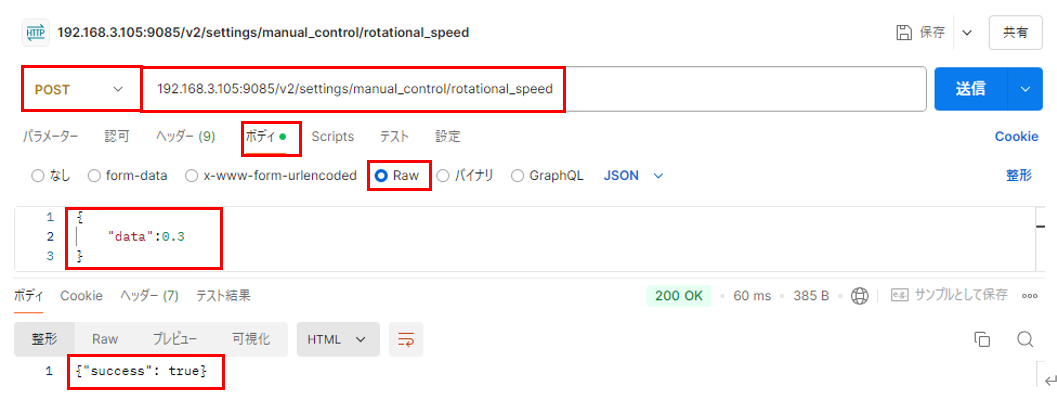
参考コード例 Python
import requests #「requests」ライブラリのインストールが必要です
import json
url = 'http://xxx.xxx.x.xxx:9085/v2/settings/manual_control/rotational_speed' #IPアドレスを入力
params = {
"data":xxx, #旋回速度(単位:rad/s)を設定
}
res = requests.post(url, json=params)
data = json.loads(res.text)
print(data)参考コード例 Javascript
<script>
let request = new XMLHttpRequest();
request.open('POST', 'http://xxx.xxx.x.xxx:9085/v2/settings/manual_control/rotational_speed', true); //IPアドレスを入力
request.setRequestHeader('content-type', 'application/json;charset=UTF-8');
request.responseType = 'json';
let body = {
'data':xxx, //旋回速度(単位:rad/s)を設定
};
request.send(JSON.stringify(body));
request.onload = function() {
window.alert( JSON.stringify( this.response ) );
};
</script>STG7 クリフセンサ(崖)センサの有効/無効設定
| Path | Method | Function |
|---|---|---|
| /v2/settings/cliff_detection | POST | クリフ(崖)センサ左右の有効/無効を設定する |
Request Body
{
"enable_left": <bool>, #true:有効, false:無効
"enable_right": <bool>, #true:有効, false:無効
}Response Body
{
"success": <bool>
}APIプラットフォーム(例:Postman)
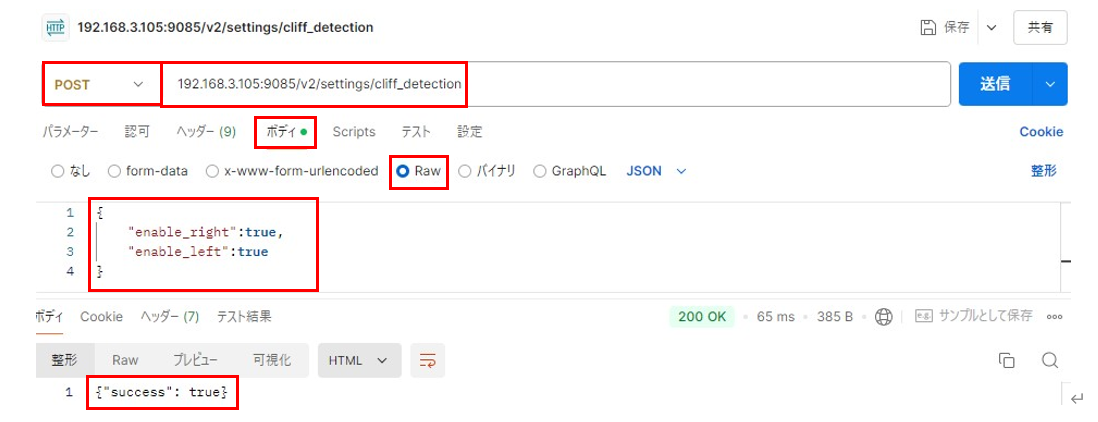
参考コード例 Python
import requests #「requests」ライブラリのインストールが必要です
import json
url = 'http://xxx.xxx.x.xxx:9085/v2/settings/cliff_detection' #IPアドレスを入力
params = {
"enable_left": <bool>, #True:有効, False:無効
"enable_right": <bool>, #True:有効, False:無効
}
res = requests.post(url, json=params)
data = json.loads(res.text)
print(data)参考コード例 Javascript
<script>
let request = new XMLHttpRequest();
request.open('POST', 'http://xxx.xxx.x.xxx:9085/v2/settings/cliff_detection', true); //IPアドレスを入力
request.setRequestHeader('content-type', 'application/json;charset=UTF-8');
request.responseType = 'json';
let body = {
‘enable_left’: <bool>, //true:有効, false:無効
‘enable_right’: <bool> //true:有効, false:無効
};
request.send(JSON.stringify(body));
request.onload = function() {
window.alert( JSON.stringify( this.response ) );
};
</script>STG8ライントレースゲイン (PID) 値の設定
| Path | Method | Function |
|---|---|---|
| /v2/settings/cliff_detection | POST | ライントレースゲイン(PID)値を設定する |
Request Body
{
"Kp": <float64>, #ライントレースゲインKp値
"Ki": <float64>, #ライントレースゲインKi値
"Kd": <float64> #ライントレースゲインKd値
}Response Body
{
"success": <bool>
}APIプラットフォーム(例:Postman)
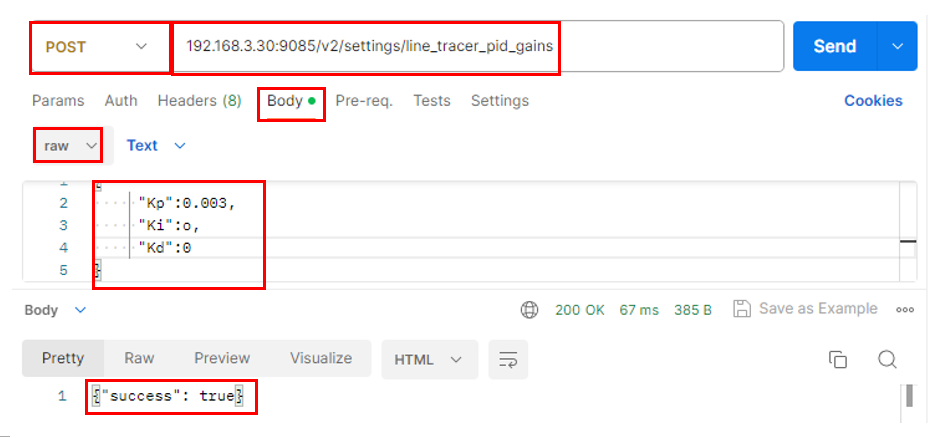
参考コード例 Python
import requests #「requests」ライブラリのインストールが必要です
import json
url = 'http://xxx.xxx.x.xxx:9085/v2/settings/line_tracer_pid_gains' #IPアドレスを入力
params = {
"Kp": <float64>, #ライントレースゲインKp値
"Ki": <float64>, #ライントレースゲインKi値
"Kd": <float64> #ライントレースゲインKd値
}
res = requests.post(url, json=params)
data = json.loads(res.text)
print(data)参考コード例 Javascript
<script>
let request = new XMLHttpRequest();
request.open('POST', 'http://192.XXX.X.XX:9085/v2/settings/line_tracer_pid_gains', true); //IPアドレスを入力
request.setRequestHeader('content-type', 'application/json;charset=UTF-8');
request.responseType = 'json';
let body = {
Kp: <float64>, //ライントレースゲインKp値
Ki: <float64>, //ライントレースゲインKi値
Kd: <float64> //ライントレースゲインKd値
};
request.send(JSON.stringify(body));
request.onload = function() {
window.alert( JSON.stringify( this.response ) );
};
</script>STG9 ライントレースHSV rangeの設定
| Path | Method | Function |
|---|---|---|
| /v2/settings/ v2/settings/line_tracer_hsv_range | POST | ライントレースのHSV rangeを設定する |
Request Body
{
"reset_to_default": <bool> #デフォルト設定値にリセットする
"h_min": <unit8>, #h(色相)最小値(0-179)
"h_max": <unit8>, #h(色相)最大値(0-179)
"s_min": <unit8>, #s(色彩)最小値(0-255)
"s_max": <unit8>, #s(彩度)最大値 (0-255)
“v_min”: <unit8>, #v(明度)最小値(0-255)
"v_max": <unit8>, #v(明度)最大値(0-255)
)Response Body
{
"success": <bool>
}APIプラットフォーム(例:Postman)
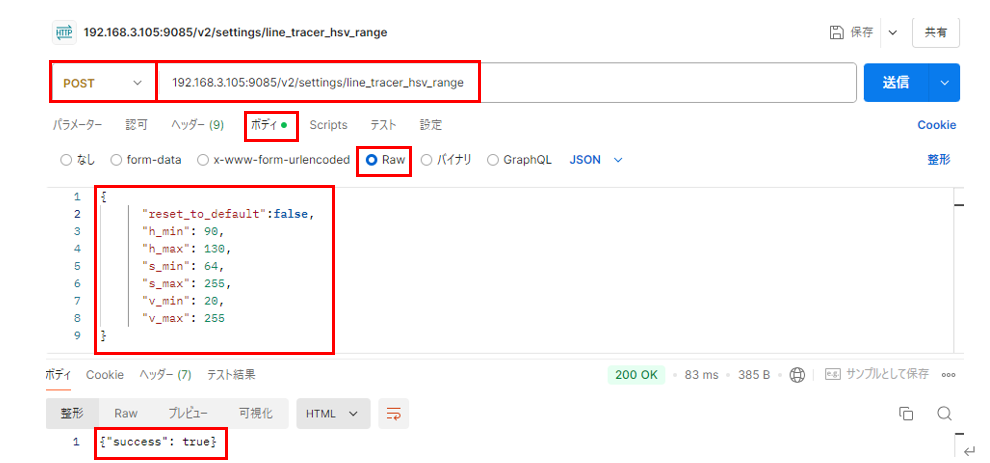
参考コード例 Python
import requests #「requests」ライブラリのインストールが必要です
import json
url = 'http://xxx.xxx.x.xxx:9085/v2/settings/line_tracer_hsv_range ' #IPアドレスを入力
params = {
"reset_to_default": <bool> #デフォルト設定値にリセットする
"h_min": <unit8>, #h(色相)最小値(0-179)
"h_max": <unit8>, #h(色相)最大値(0-179)
"s_min": <unit8>, #s(色彩)最小値(0-255)
"s_max": <unit8>, #s(彩度)最大値 (0-255)
“v_min”: <unit8>, #v(明度)最小値(0-255)
"v_max": <unit8>, #v(明度)最大値(0-255)
}
res = requests.post(url, json=params)
data = json.loads(res.text)
print(data)参考コード例 Javascript
<script>
let request = new XMLHttpRequest();
request.open('POST', 'http://xxx.xxx.x.xxx:9085/v2/settings/line_tracer_pid_gains', true); //IPアドレスを入力
request.setRequestHeader('content-type', 'application/json;charset=UTF-8');
request.responseType = 'json';
let body = {
reset_to_default": <bool>, //デフォルト設定値にリセットする
h_min": <unit8>, //h(色相)最小値(0-179)
h_max": <unit8>, //h(色相)最大値(0-179)
s_min": <unit8>, //s(色彩)最小値(0-255)
s_max": <unit8>, //s(彩度)最大値(0-255)
v_min”: <unit8>, //v(明度)最小値(0-255)
v_max": <unit8> //v(明度)最大値(0-255)
};
request.send(JSON.stringify(body));
request.onload = function() {
window.alert( JSON.stringify( this.response ) );
};
</script>STG10 自己位置測位パラメーターの取得
| Path | Method | Function |
|---|---|---|
| /v2/settings/ v2/settings/cauchy_range | GET | 自己位置測位パラメーターを取得する |
Request Body なし
Response Body
{
"success": <bool>
"max": <float64>, #厳密性max
"min": <float64> #厳密性min
}APIプラットフォーム(例:Postman)
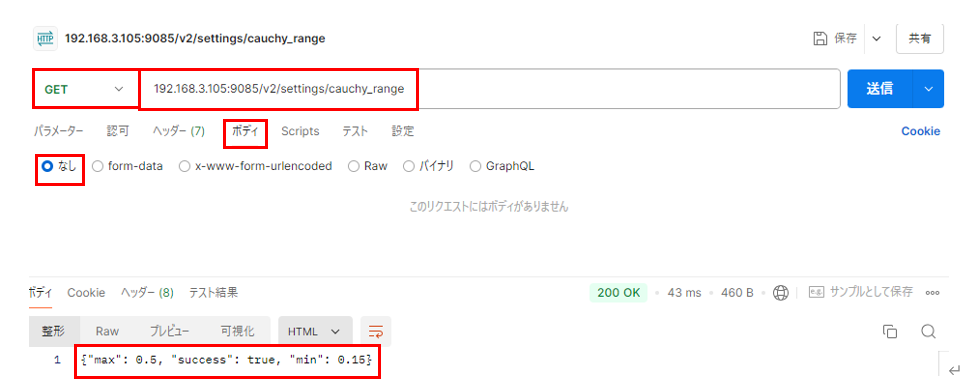
参考コード例 Python
import requests #「requests」ライブラリのインストールが必要です
import json
url = 'http://xxx.xxx.x.xxx:9085/v2/settings/cauchy_range' #IPアドレスを入力
res = requests.get(url)
data = json.loads(res.text)
print(data)参考コード例 Javascript
<script>
let request = new XMLHttpRequest();
request.open('GET', 'http://xxx.xxx.x.xxx:9085/v2/settings/cauchy_range', true); //IPアドレスを入力
request.setRequestHeader('content-type', 'application/json;charset=UTF-8');
request.responseType = 'json';
request.send();
request.onload = function() {
window.alert( JSON.stringify( this.response ) );
};
</script>STG11 自己位置測位パラメーターの設定
| Path | Method | Function |
|---|---|---|
| /v2/settings/ v2/settings/cauchy_range | POST | 自己位置測位パラメーターを設定する |
※パラメーターを変更した場合、自動運転時の挙動が変化する場合があります。必要に応じて、マップの再作成を行って下さい。
※設定の目安:- デフォルト: 厳密性Min:0.15、 厳密性Max:0.5
Request Body
{
"max": <float64>, #厳密性max
"min": <float64> #厳密性min
)Response Body
{
"success": <bool>
}APIプラットフォーム(例:Postman)
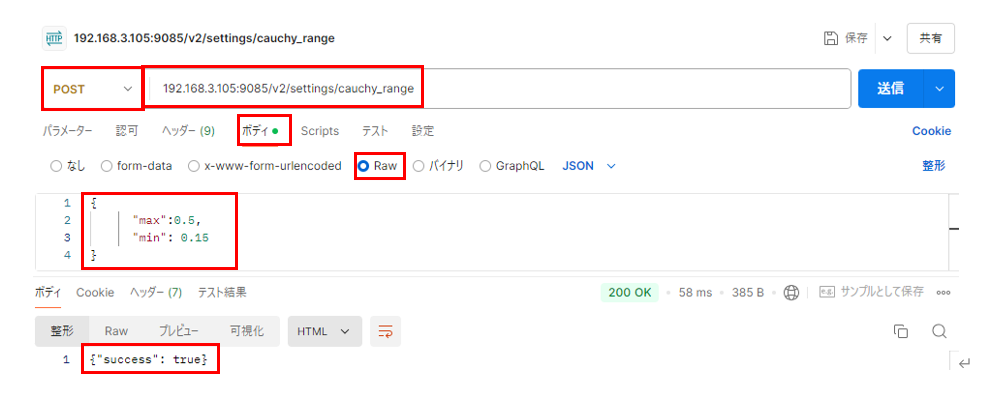
参考コード例 Python
import requests #「requests」ライブラリのインストールが必要です
import json
url = 'http://xxx.xxx.x.xxx:9085/v2/settings/cauchy_range' #IPアドレスを入力
params = {
"max": xxx, #厳密性max
"min": xxx, #厳密性min
}
res = requests.post(url, json=params)
data = json.loads(res.text)
print(data)参考コード例 Javascript
<script>
let request = new XMLHttpRequest();
request.open('POST', 'http://xxx.xxx.x.xxx:9085/v2/settings/cauchy_range', true); //IPアドレスを入力
request.setRequestHeader('content-type', 'application/json;charset=UTF-8');
request.responseType = 'json';
let body = {
max : xxx, //厳密性max
min : xxx //厳密性min
};
request.send(JSON.stringify(body));
request.onload = function() {
window.alert( JSON.stringify( this.response ) );
};
</script>STG12 LiDARフィルターの取得
| Path | Method | Function |
|---|---|---|
| /v2/settings/ v2/settings/ lidar_filter | GET | LiDARフィルターを取得する |
Request Body なし
Response Body
{
"sectors": [
{
"sector": 1,
"lower_angle": <float64>, #セクター1 下限角度
"upper_angle": <float64> #セクター1 上限角度
},
{
"sector": 2,
"lower_angle": <float64>, #セクター2 下限角度
"upper_angle": <float64> #セクター2 上限角度
},
{
"sector": 3,
"lower_angle": <float64>, #セクター3 下限角度
"upper_angle": <float64> #セクター3 上限角度
},
{
"sector": 4,
"lower_angle": <float64>, #セクター4 下限角度
"upper_angle": <float64> #セクター4 上限角度
},
{
"sector": 5,
"lower_angle": <float64>, #セクター5 下限角度
"upper_angle": <float64> #セクター5 上限角度
},
{
"sector": 6,
"lower_angle": <float64>, #セクター6 下限角度
"upper_angle": <float64> #セクター6 上限角度
},
{
"sector": 7,
"lower_angle": <float64>, #セクター7 下限角度
"upper_angle": <float64> #セクター7 上限角度
},
{
"sector": 8,
"lower_angle": <float64>, #セクター8 下限角度
"upper_angle": <float64> #セクター8 上限角度
}
],
"success": true
}APIプラットフォーム(例:Postman)
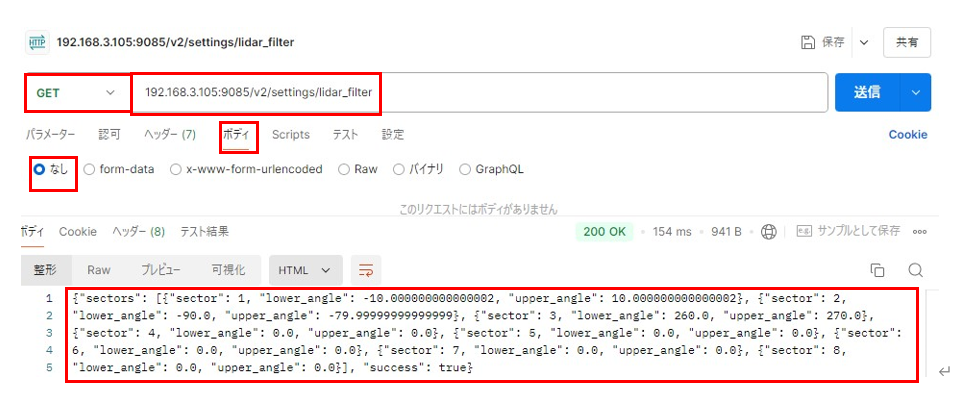
参考コード例 Python
import requests #「requests」ライブラリのインストールが必要です
import json
url = 'http://xxx.xxx.x.xxx:9085/v2/settings/lidar_filter' #IPアドレスを入力
res = requests.get(url)
data = json.loads(res.text)
print(data)参考コード例 Javascript
<script>
let request = new XMLHttpRequest();
request.open('GET', 'http://xxx.xxx.x.xxx:9085/v2/settings/cauchy_range', true); //IPアドレスを入力
request.setRequestHeader('content-type', 'application/json;charset=UTF-8');
request.responseType = 'json';
request.send();
request.onload = function() {
window.alert( JSON.stringify( this.response ) );
};
</script>STG13 LiDARフィルターの設定
| Path | Method | Function |
|---|---|---|
| /v2/settings/ v2/settings/ lidar_filter | POST | LiDARフィルターを設定する |
Request Body
{
"sector": x, #セクター番号:xは、1~8
"lower_angle": <float64>, #セクターx 下限角度
"upper_angle": <float64> #セクターx 上限角度
}Response Body
{
"success": true
}APIプラットフォーム(例:Postman)
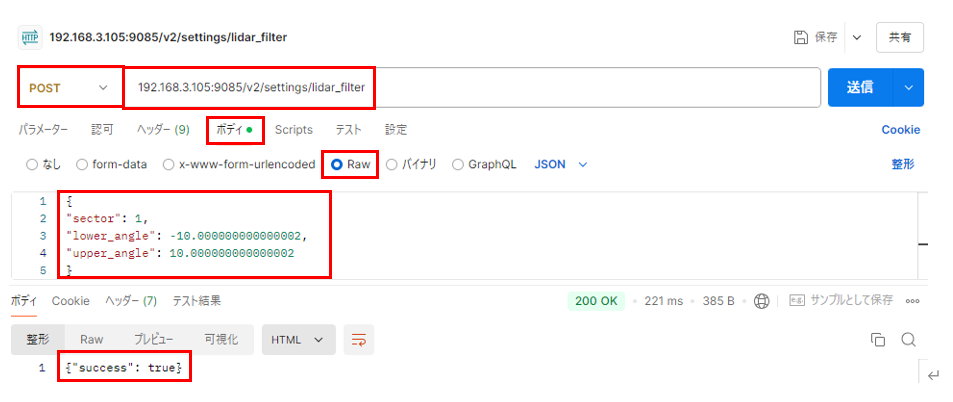
参考コード例 Python
import requests #「requests」ライブラリのインストールが必要です
import json
url = 'http://xxx.xxx.x.xxx:9085/v2/settings/lidar_filter' #IPアドレスを入力
params = {
"sector": x, #セクター番号:xは、1~8
"lower_angle": <float64>, #セクターx 下限角度
"upper_angle": <float64> #セクターx 上限角度
}
res = requests.post(url, json=params)
data = json.loads(res.text)
print(data)参考コード例 Javascript
<script>
let request = new XMLHttpRequest();
request.open('POST', 'http://xxx.xxx.x.xxx:9085/v2/settings/lidar_filter', true); //IPアドレスを入力
request.setRequestHeader('content-type', 'application/json;charset=UTF-8');
request.responseType = 'json';
let body = {
sector : x, #セクター番号:xは、1~8
lower_angle : <float64>, #セクターx 下限角度
upper_angle : <float64> #セクターx 上限角度
};
request.send(JSON.stringify(body));
request.onload = function() {
window.alert( JSON.stringify( this.response ) );
};
</script>STG14 直進ゲインの有効/無効設定
| Path | Method | Function |
|---|---|---|
| v2/settings/move_straight_pid_control | POST | 直進ゲインの有効/無効を設定する |
Request Body
{
"enable" : <bool> #True:有効, False:無効
}Response Body
{
"success": true
}APIプラットフォーム(例:Postman)
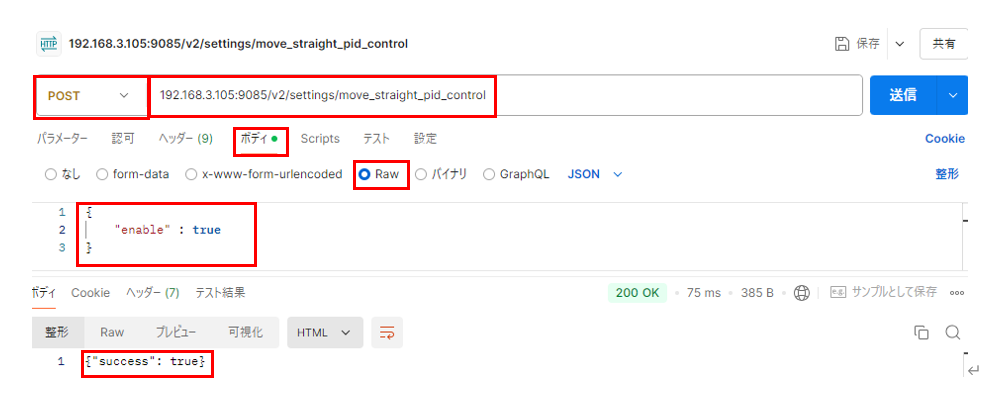
参考コード例 Python
import requests #「requests」ライブラリのインストールが必要です
import json
url = 'http://xxx.xxx.x.xxx:9085/v2/settings/move_straight_pid_control' #IPアドレスを入力
params = {
"enable": <bool> #直進ゲインの有効(True)/無効(False)
}
res = requests.post(url, json=params)
data = json.loads(res.text)
print(data)参考コード例 Javascript
<script>
let request = new XMLHttpRequest();
request.open('POST', 'http://xxx.xxx.x.xxx:9085/v2/settings/move_straight_pid_control', true); //IPアドレスを入力
request.setRequestHeader('content-type', 'application/json;charset=UTF-8');
request.responseType = 'json';
let body = {
enable : <bool> //直進ゲインの有効(True)/無効(False)
};
request.send(JSON.stringify(body));
request.onload = function() {
window.alert( JSON.stringify( this.response ) );
};
</script>STG15 直進ゲインの設定
| Path | Method | Function |
|---|---|---|
| v2/settings/ move_straight_pid_gains | POST | 直進ゲイン(Kp, Ki, Kd)を設定する |
Request Body
{
"Kp": <int> #直進ゲインKp値
"Ki": <int> #直進ゲインKi値
"Kd": <int> #直進ゲインKd値
}Response Body
{
"success": true
}APIプラットフォーム(例:Postman)
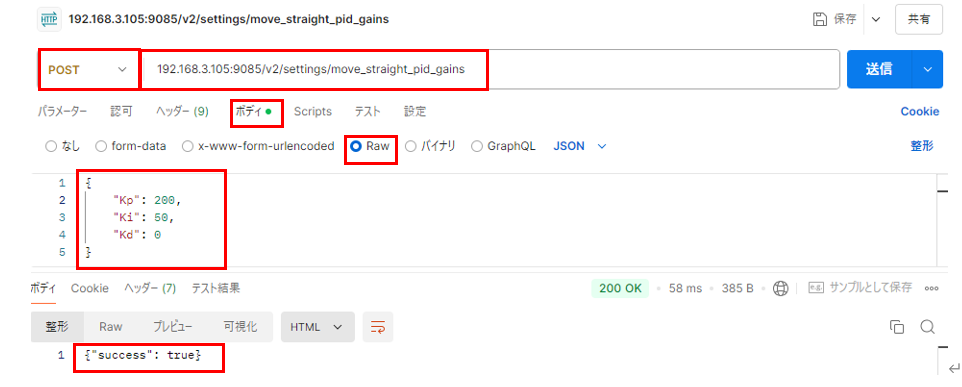
参考コード例 Python
import requests #「requests」ライブラリのインストールが必要です
import json
url = 'http://xxx.xxx.x.xxx:9085/v2/settings/move_straight_pid_gains' #IPアドレスを入力
params = {
"Kp": <int>, #直進ゲインKp値
"Ki": <int>, #直進ゲインKi値
"Kd": <int> #直進ゲインKd値
}
res = requests.post(url, json=params)
data = json.loads(res.text)
print(data)参考コード例 Javascript
<script>
let request = new XMLHttpRequest();
request.open('POST', 'http://xxx.xxx.x.xxx:9085/v2/settings/move_straight_pid_gains', true); //IPアドレスを入力
request.setRequestHeader('content-type', 'application/json;charset=UTF-8');
request.responseType = 'json';
let body = {
Kp : <int>, #直進ゲインKp値
Ki : <int>, #直進ゲインKi値
Kd : <int> #直進ゲインKd値
};
request.send(JSON.stringify(body));
request.onload = function() {
window.alert( JSON.stringify( this.response ) );
};
</script>STG16 ユーザーサウンドの追加
| Path | Method | Function |
|---|---|---|
| /v2/ user_sound | PUT | ユーザーサウンドの追加 |
Request Body
{
"track": <string> #追加するトラック番号
"name": <string> #追加するユーザーサウンドの名称
"file": <string Base64> #追加するユーザーサウンドのファイル
}Response Body
{
"success": <bool>
}APIプラットフォーム(例:Postman)
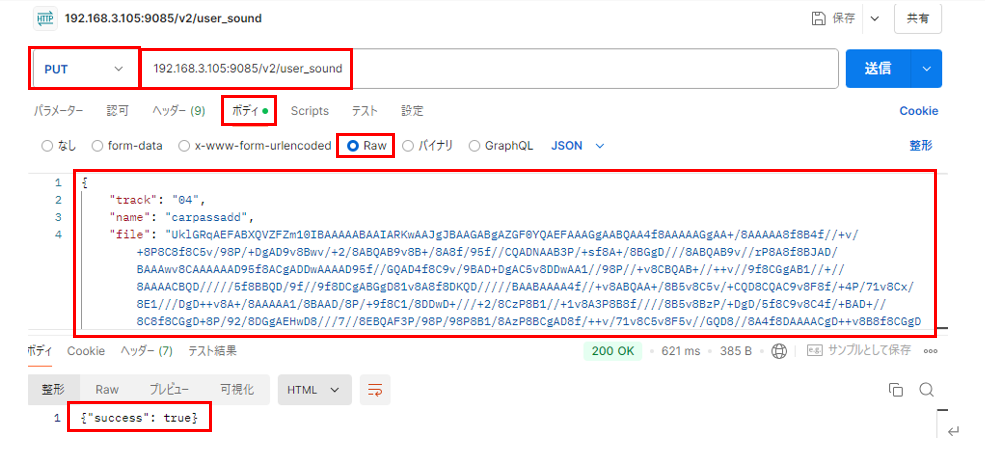
参考コード例 Python
import requests #「requests」ライブラリのインストールが必要です
import json
url = 'http://xxx.xxx.x.xxx:9085/v2/user_sound' #IPアドレスを入力
params = {
"track": <string> #追加するトラック番号
"name": <string> #追加するユーザーサウンドの名称
"file": <string Base64> #追加するユーザーサウンドのファイル(waveファイルを、base64に変換が必要)
}
res = requests.put(url, json=params)
data = json.loads(res.text)
print(data)参考コード例 Javascript
<script>
let request = new XMLHttpRequest();
request.open("PUT", "http://xxx.xxx.x.xxx:9085/v2/user_sound", true); //IPアドレスを入力
request.setRequestHeader("content-type", "application/json;charset=UTF-8");
request.responseType = "json";
let body = {
track: <string> //追加するトラック番号
name: <string> //追加するユーザーサウンドの名称
file: <string Base64> //追加するユーザーサウンドのファイル(waveファイルを、base64に変換が必要)
};
request.send(JSON.stringify(body));
request.onload = function () {
window.alert(JSON.stringify(this.response));
};
</script>STG17 ユーザーサウンドの削除
| Path | Method | Function |
|---|---|---|
| /v2/user_sound | DELETE | ユーザーサウンドを削除する |
Request Body
{
"track" <string> #削除したいトラック番号
}Response Body
{
"success":<bool>
}APIプラットフォーム(例:Postman)
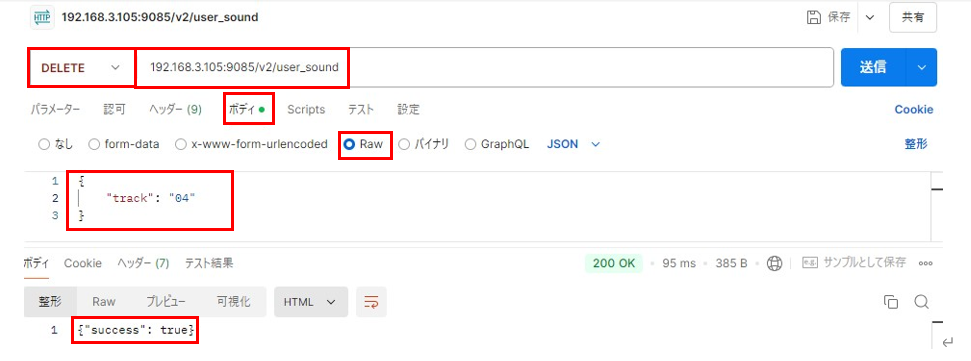
参考コード例 Python
import requests #「requests」ライブラリのインストールが必要です
import json
url = 'http://xxx.xxx.x.xxx:9085/v2/user_sound' #IPアドレスを入力
params = {'track': xxx } #削除したいトラック番号を入力
res = requests.delete(url, json=params)
data = json.loads(res.text)
print(data)参考コード例 Javascript
<script>
let request = new XMLHttpRequest();
request.open('DELETE', 'http://192.XXX.X.XX:9085/v2/user_sound', true); //IPアドレスを入力
request.setRequestHeader('content-type', 'application/json;charset=UTF-8');
request.responseType = 'json';
let body ={track:XXX}; //削除したいトラック番号を入力
request.send(JSON.stringify(body));
request.onload = function() {
window.alert( JSON.stringify( this.response ) );
};
</script>STG18 ユーザーサウンドの取得
| Path | Method | Function |
|---|---|---|
| /v2/user_sound | GET | ユーザーサウンドを取得する |
Request Body
{
"track" <string> #取得したいトラック番号
}Response Body
{
"success":<bool>,
"track": <string>, #トラック番号
"name": <string>, #ユーザーサウンドの名称
"file": <string,Base64> #ユーザーサウンドのファイル
}APIプラットフォーム(例:Postman)
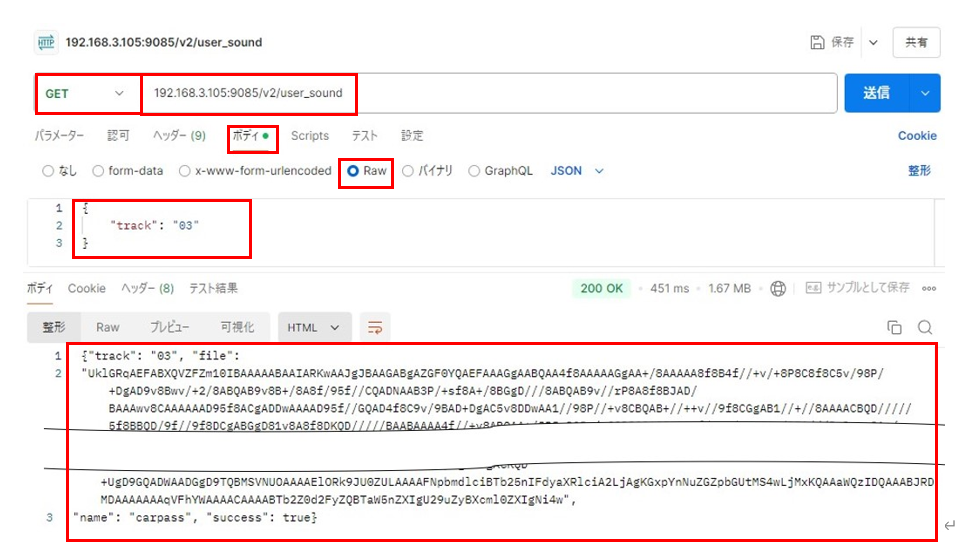
参考コード例 Python
import requests #「requests」ライブラリのインストールが必要です
import json
url = 'http://xxx.xxx.x.xxx:9085/v2/user_sound' #IPアドレスを入力
params = {'track': xxx } #取得したいトラック番号を入力
res = requests.get(url, json=params)
data = json.loads(res.text)
print(data)参考コード例 Javascript
<script>
let request = new XMLHttpRequest();
request.open('GET', 'http://xxx.xxx.x.xxx:9085/v2/user_sound', true); //IPアドレスを入力
request.setRequestHeader('content-type', 'application/json;charset=UTF-8');
request.responseType = 'json';
let body ={track:xxx}; //取得したいトラック番号を入力
request.send(JSON.stringify(body));
request.onload = function() {
window.alert( JSON.stringify( this.response ) );
};
</script>STG19 ユーザーサウンドリストの取得
| Path | Method | Function |
|---|---|---|
| /v2/user_sound/list | GET | ユーザーサウンドリストを取得する |
Request Body なし
Response Body
{
"list": [
{
"track": "01",
"name": <string>,
"file": <string>
},
.
.
{
"track": "20",
"name": "",
"file": ""
}
],
"success": <bool>
}APIプラットフォーム(例:Postman)
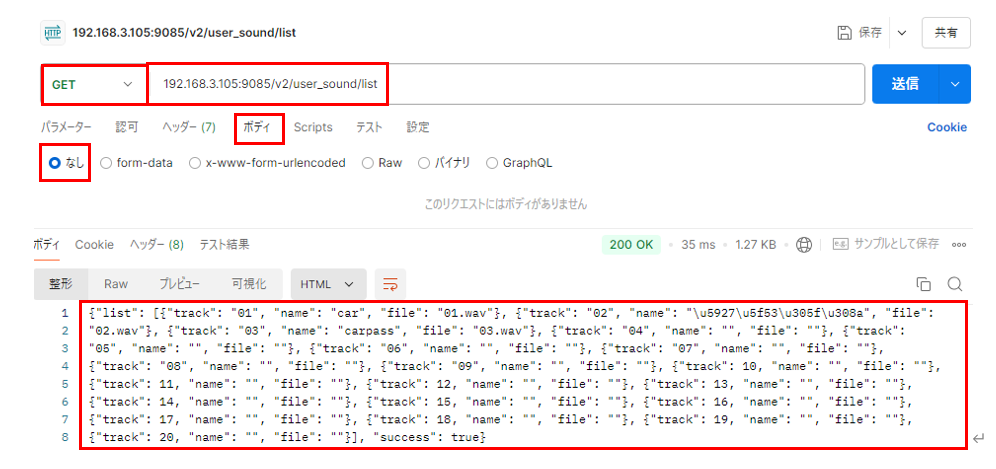
参考コード例 Python
import requests #「requests」ライブラリのインストールが必要です
import json
url = 'http://xxx.xxx.x.xxx:9085/v2/user_sound/list' #IPアドレスを入力
res = requests.get(url)
data = json.loads(res.text)
print(data)参考コード例 Javascript
<script>
let request = new XMLHttpRequest();
request.open("GET", "http://xxx.xxx.x.xxx:9085/v2/user_sound/list", true); //IPアドレスを入力
request.setRequestHeader("content-type", "application/json;charset=UTF-8");
request.responseType = "json";
request.send();
request.onload = function () {
window.alert(JSON.stringify(this.response));
};
</script>S1 メインコントローラのシャットダウン
| Path | Method | Function |
|---|---|---|
| /v2/system/shutdown | POST | メインコントローラ のシャットダウンを⾏う |
Request Body: なし
Response Body
{
"success":<bool>
}APIプラットフォーム(例:Postman)
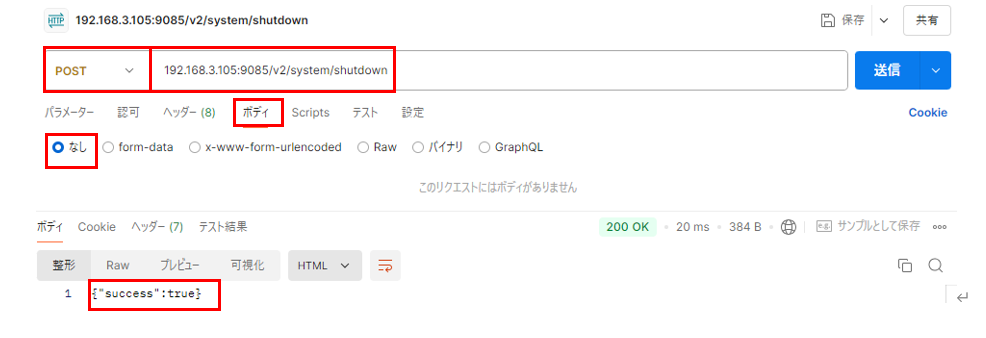
参考コード例 Python
import requests #「requests」ライブラリのインストールが必要です
import json
url = 'http://xxx.xxx.x.xxx:9085/v2/system/shutdown' #IPアドレスを入力
res = requests.post(url)
data = json.loads(res.text)
print(data)参考コード例 Javascript
<script>
let request = new XMLHttpRequest();
request.open('POST', 'http://xxx.xxx.x.xxx:9085/v2/system/shutdown', true); //IPアドレスを入力
request.setRequestHeader('content-type', 'application/json;charset=UTF-8');
request.responseType = 'json';
request.send();
request.onload = function() {
window.alert( JSON.stringify( this.response ) );
};
</script>S2 メインコントローラの再起動
| Path | Method | Function |
|---|---|---|
| /v2/system/restart | POST | メインコントローラ の再起動を⾏う |
Request Body: なし
Response Body
{
"success":<bool>
}APIプラットフォーム(例:Postman)
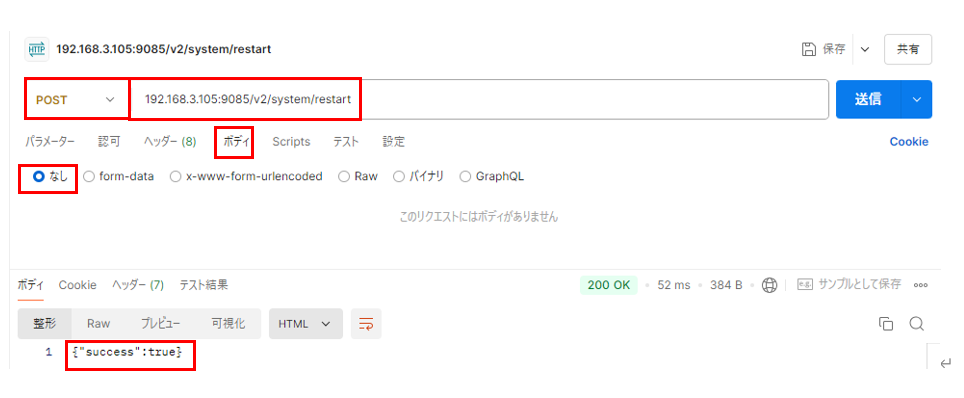
参考コード例 Python
import requests #「requests」ライブラリのインストールが必要です
import json
url = 'http://xxx.xxx.x.xxx:9085/v2/system/restart' #IPアドレスを入力
res = requests.post(url)
data = json.loads(res.text)
print(data)参考コード例 Javascript
<script>
let request = new XMLHttpRequest();
request.open('POST', 'http://xxx.xxx.x.xxx:9085/v2/system/restart', true); //IPアドレスを入力
request.setRequestHeader('content-type', 'application/json;charset=UTF-8');
request.responseType = 'json';
request.send();
request.onload = function() {
window.alert( JSON.stringify( this.response ) );
};
</script>S3 ロボットコントローラの再起動
| Path | Method | Function |
|---|---|---|
| /v2/system/controller/reboot | POST | ロボットコントローラ の再起動を⾏う |
Request Body: なし
Response Body
{
"success":<bool>
}APIプラットフォーム(例:Postman)
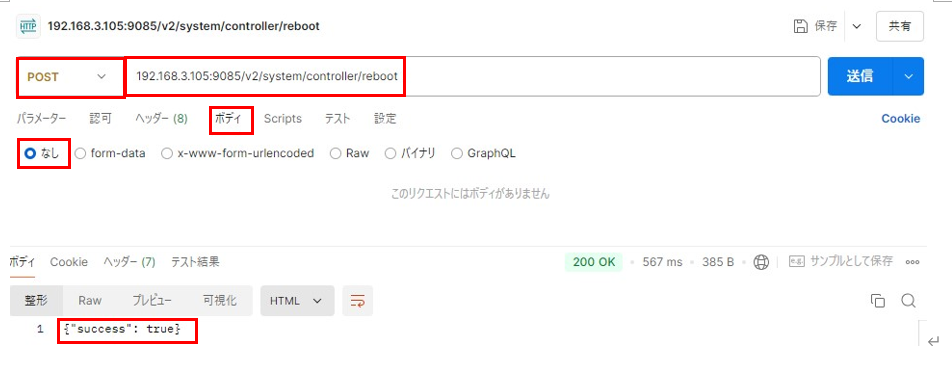
参考コード例 Python
import requests #「requests」ライブラリのインストールが必要です
import json
url = 'http://192.XXX.X.XX:9085/v2/system/controller/reboot' #IPアドレスを入力
res = requests.post(url, json=params)
data = json.loads(res.text)
print(data)参考コード例 Javascript
<script>
let request = new XMLHttpRequest();
request.open('POST', 'http://192.XXX.X.XX:9085/v2/system/controller/reboot', true); #IPアドレスを入力
request.setRequestHeader('content-type', 'application/json;charset=UTF-8');
request.responseType = 'json';
request.send();
request.onload = function() {
window.alert( JSON.stringify( this.response ) );
};
</script>C1ライントレースのオフセット値(前後)の取得
| Path | Method | Function |
|---|---|---|
| /v2/calibration/line_tracer_offset | GET | ライントレースのオフセット値(前後)を取得する |
Request Body: なし
Response Body
{
"offset_correction": <float32>, #ライントレースのオフセット値(前後)
"success": <bool >
}APIプラットフォーム(例:Postman)
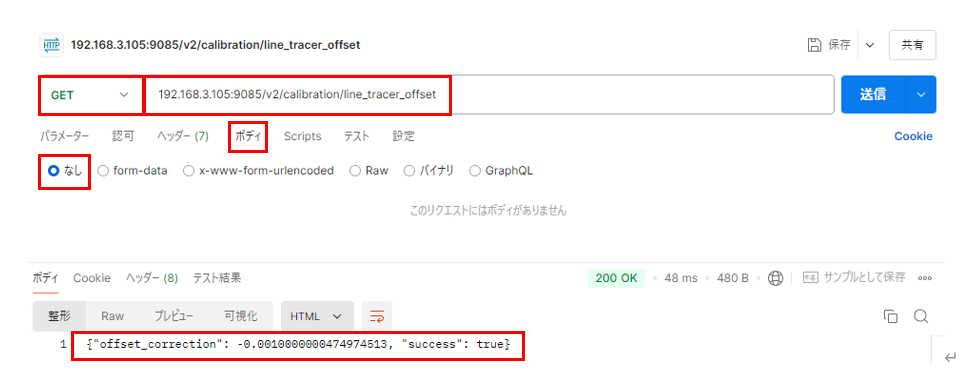
参考コード例 Python
import requests #「requests」ライブラリのインストールが必要です
import json
url = 'http://xxx.xxx.x.xxx:9085/v2/calibration/line_tracer_offset' #IPアドレスを入力
res = requests.get(url)
data = json.loads(res.text)
print(data)参考コード例 Javascript
<script>
let request = new XMLHttpRequest();
request.open('GET', 'http://xxx.xxx.x.xxx:9085/v2/calibration/line_tracer_offset', true); //IPアドレスを入力
request.setRequestHeader('content-type', 'application/json;charset=UTF-8');
request.responseType = 'json';
request.send();
request.onload = function() {
window.alert( JSON.stringify( this.response ) );
};
</script>C2ライントレースのオフセット値(前後)の取得
| Path | Method | Function |
|---|---|---|
| /v2/calibration/line_tracer_offset | POST | ライントレースのオフセット値(前後)を設定する |
Request Body
{
"offset_correction": <float32>, #ライントレースのオフセット値(前後)
}Response Body
{
"success": <bool>
}APIプラットフォーム(例:Postman)
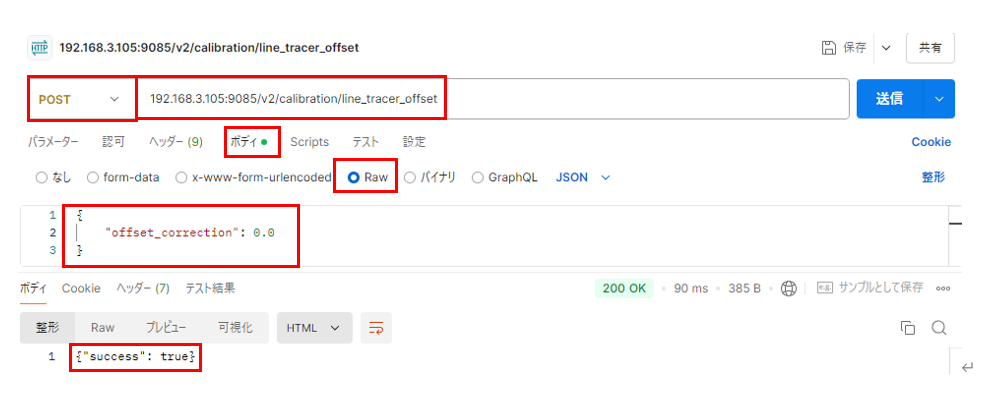
参考コード例 Python
import requests #「requests」ライブラリのインストールが必要です
import json
url = 'http://xxx.xxx.x.xxx:9085/v2/calibration/line_tracer_offset' #IPアドレスを入力
params = {
"offset_correction": <float32> #ライントレースのオフセット値(前後)
}
res = requests.post(url, json=params)
data = json.loads(res.text)
print(data)参考コード例 Javascript
<script>
let request = new XMLHttpRequest();
request.open('POST', 'http://xxx.xxx.x.xxx:9085/v2/settings/line_tracer_offset', true); //IPアドレスを入力
request.setRequestHeader('content-type', 'application/json;charset=UTF-8');
request.responseType = 'json';
let body {
offset_correction: <float32> //ライントレースのオフセット値(前後)
};
request.send(JSON.stringify(body));
request.onload = function() {
window.alert( JSON.stringify( this.response ) );
};
</script>C3 ライントレースのオフセット値(左右)の取得
| Path | Method | Function |
|---|---|---|
| /v2/calibration/line_tracer_side_offset | GET | ライントレースのオフセット値(左右)を取得する |
Request Body: なし
Response Body
{
"side_offset_correction": <int32>, #ライントレースのオフセット値(前後)[pixel]
"success": <bool >
}APIプラットフォーム(例:Postman)
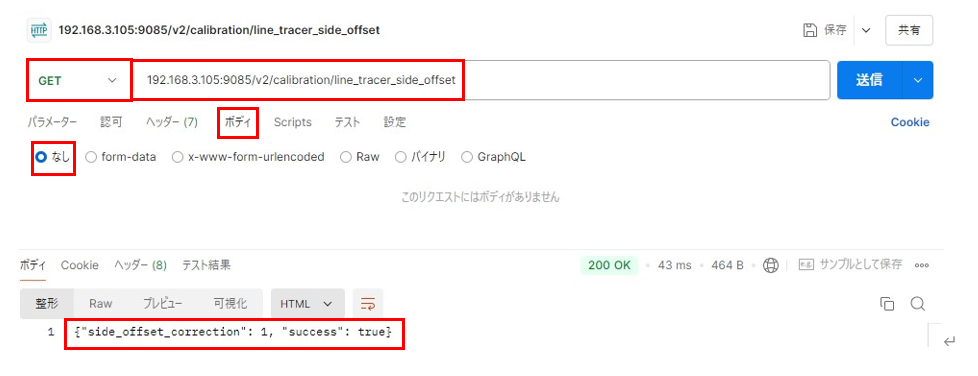
参考コード例 Python
import requests #「requests」ライブラリのインストールが必要です
import json
url = 'http://xxx.xxx.x.xxx:9085/v2/calibration/line_tracer_side_offset' #IPアドレスを入力
res = requests.get(url)
data = json.loads(res.text)
print(data)参考コード例 Javascript
<script>
let request = new XMLHttpRequest();
request.open('GET', 'http://xxx.xxx.x.xxx:9085/v2/calibration/line_tracer_side_offset', true); //IPアドレスを入力
request.setRequestHeader('content-type', 'application/json;charset=UTF-8');
request.responseType = 'json';
request.send();
request.onload = function() {
window.alert( JSON.stringify( this.response ) );
};
</script>C4ライントレースオフセット値(左右)の設定
| Path | Method | Function |
|---|---|---|
| /v2/calibration/line_tracer_side_offset | POST | ライントレースのオフセット値(左右)を設定する |
Request Body
{
"side_offset_correction": <int32>, #ライントレースのオフセット値(左右)
"auto_calibrate": <bool> #自動キャリブレーション機能の有効/無効設定
}Response Body
{
"success": <bool>
}APIプラットフォーム(例:Postman)
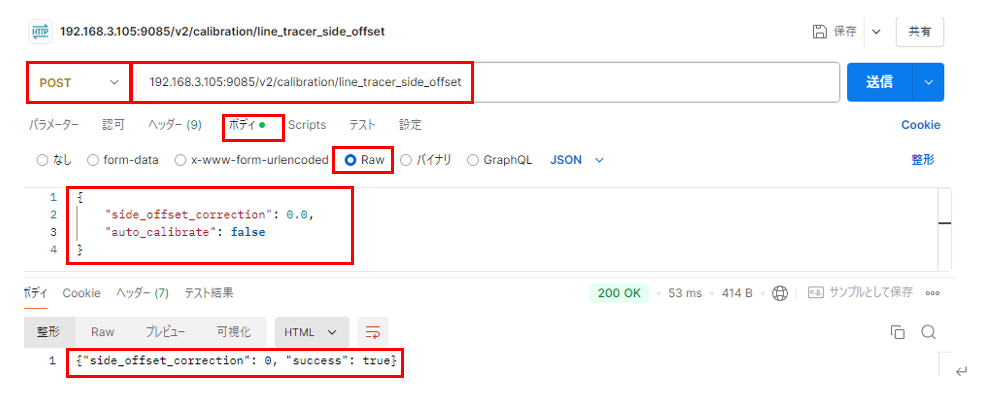
参考コード例 Python
import requests #「requests」ライブラリのインストールが必要です
import json
url = 'http://xxx.xxx.x.xxx:9085/v2/calibration/line_tracer_side_offset' #IPアドレスを入力
params = {
"side_offset_correction": <int32>, #ライントレースのオフセット値(左右)[pixel]
"auto_calibrate": <bool> #自動キャリブレーション機能の有効/無効設定
}
res = requests.post(url, json=params)
data = json.loads(res.text)
print(data)参考コード例 Javascript
<script>
let request = new XMLHttpRequest();
request.open('POST', 'http://192.XXX.X.XX:9085/v2/calibration/line_tracer_side_offset ', true); //IPアドレスを入力
request.setRequestHeader('content-type', 'application/json;charset=UTF-8');
request.responseType = 'json';
let body = {
‘side_offset_correction’: <int32>, //ライントレースのオフセット値(左右)
‘auto_calibrate’: <bool> //自動キャリブレーション機能の有効/無効設定
};
request.send(JSON.stringify(body));
request.onload = function() {
window.alert( JSON.stringify( this.response ) );
};
</script>C5 ライントレースのオフセット値(壁際で停止)の取得
| Path | Method | Function |
|---|---|---|
| /v2/calibration/line_tracer_wall_distance_offset | GET | ライントレースのオフセット値(壁際で停止)を取得する |
Request Body
なし
Response Body
{
"right_side_offset": <float32>, #ライントレース(壁際で停止)のオフセット値(右)
"left_side_offset": <float32>, #ライントレース(壁際で停止)のオフセット値(左)
"success": <bool >
}APIプラットフォーム(例:Postman)
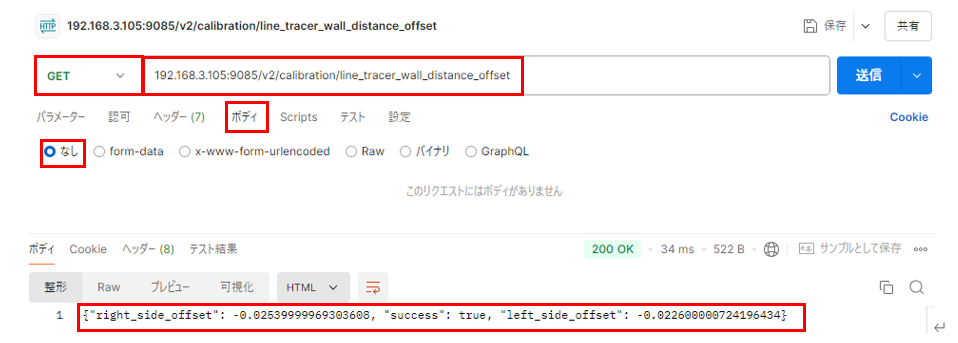
参考コード例 Python
import requests #「requests」ライブラリのインストールが必要です
import json
url = 'http://xxx.xxx.x.xxx:9085/v2/calibration/line_tracer_wall_distance_offset' #IPアドレスを入力
res = requests.get(url)
data = json.loads(res.text)
print(data)参考コード例 Javascript
<script>
let request = new XMLHttpRequest();
request.open('GET', 'http://xxx.xxx.x.xxx:9085/v2/calibration/line_tracer_wall_distance_offset', true); //IPアドレスを入力
request.setRequestHeader('content-type', 'application/json;charset=UTF-8');
request.responseType = 'json';
request.send();
request.onload = function() {
window.alert( JSON.stringify( this.response ) );
};
</script>C6ライントレースオフセット値(壁際で停止)の設定
| Path | Method | Function |
|---|---|---|
| /v2/calibration/line_tracer_wall_distance_offset | POST | ライントレースのオフセット値(壁際で停止)を設定する |
Request Body
{
"right_side_offset": <float32>, #ライントレース(壁際で停止)のオフセット値(右)
"left_side_offset": <float32>, #ライントレース(壁際で停止)のオフセット値(左)
"auto_calibrate": <bool>, #自動キャリブレーション機能の有効/無効設定
"wall_distance": <float32>, #Aliの前面から壁際までの距離
}Response Body
{
"right_side_offset": <float32>, #ライントレース(壁際で停止)のオフセット値(右)
"left_side_offset": <float32>, #ライントレース(壁際で停止)のオフセット値(左)
"success": <bool >
}APIプラットフォーム(例:Postman)
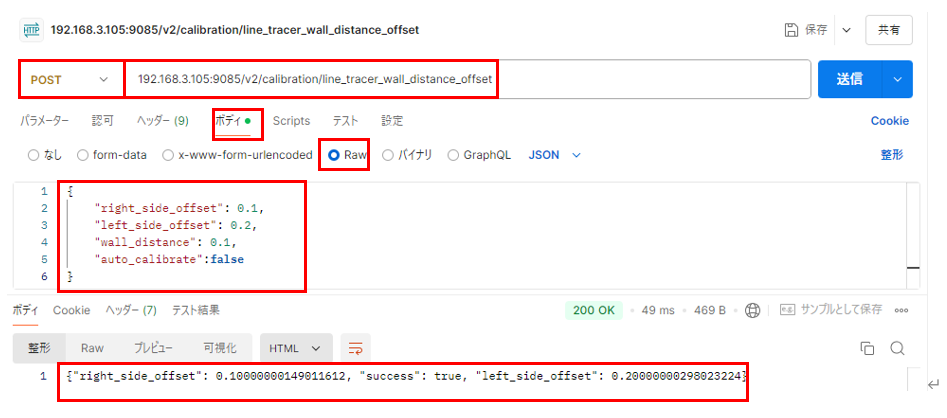
参考コード例 Python
import requests #「requests」ライブラリのインストールが必要です
import json
url = 'http://xxx.xxx.x.xxx:9085/v2/calibration/line_tracer_wall_distance_offset' #IPアドレスを入力
params = {
"right_side_offset": <float32>, #ライントレース(壁際で停止)のオフセット値(右)
"left_side_offset": <float32>, #ライントレース(壁際で停止)のオフセット値(左)
"wall_distance": <float32>, #ライントレース壁までの距離
"auto_calibrate": <bool> #自動キャリブレーション機能の有効/無効設定
}
res = requests.post(url, json=params)
data = json.loads(res.text)
print(data)参考コード例 Javascript
<script>
let request = new XMLHttpRequest();
request.open('POST', 'http://192.XXX.X.XX:9085/v2/calibration/line_tracer_side_offset ', true); //IPアドレスを入力
request.setRequestHeader('content-type', 'application/json;charset=UTF-8');
request.responseType = 'json';
let body = {
right_side_offset: <float32>, //#ライントレース(壁際で停止)のオフセット値(右)
left_side_offset: <float32>, #//ライントレース(壁際で停止)のオフセット値(左)
wall_distance: <float32>, #//ライントレース壁までの距離
auto_calibrate: <bool>
};
request.send(JSON.stringify(body));
request.onload = function() {
window.alert( JSON.stringify( this.response ) );
};
</script>C7 充電ドッキング距離のオフセットの取得
| Path | Method | Function |
|---|---|---|
| /v2/calibration/dockingl_distance_offset | GET | 充電ドッキング距離のオフセット値を取得する |
Request Body
なし
Response Body
{
"offset": <float32>, #充電ドッキング距離のオフセット値
“success”: <bool >
}APIプラットフォーム(例:Postman)
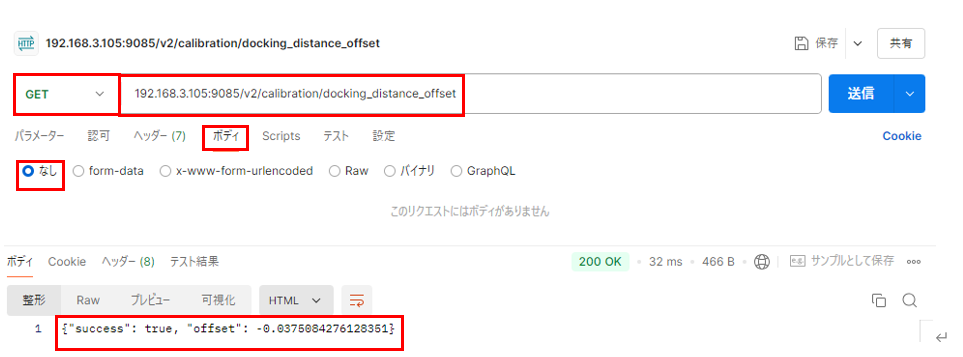
参考コード例 Python
import requests #「requests」ライブラリのインストールが必要です
import json
url = 'http://xxx.xxx.x.xxx:9085/v2/calibration/docking_distance_offset' #IPアドレスを入力
res = requests.get(url)
data = json.loads(res.text)
print(data)参考コード例 Javascript
<script>
let request = new XMLHttpRequest();
request.open('GET', 'http://xxx.xxx.x.xxx:9085/v2/calibration/docking_distance_offset', true); //IPアドレスを入力
request.setRequestHeader('content-type', 'application/json;charset=UTF-8');
request.responseType = 'json';
request.send();
request.onload = function() {
window.alert( JSON.stringify( this.response ) );
};
</script>C8充電ドッキング距離のオフセットの設定
| Path | Method | Function |
|---|---|---|
| /v2/calibration/docking_distance_offset | POST | 充電ドッキング距離を設定する |
Request Body
{
"offset": <float32>, #充電ドッキング距離のオフセット値
"auto_calibrate": <bool>, #自動キャリブレーション機能の有効/無効設定
}Response Body
{
"offset": <float32>, #充電ドッキング距離のオフセット値
"success": <bool >
}APIプラットフォーム(例:Postman)
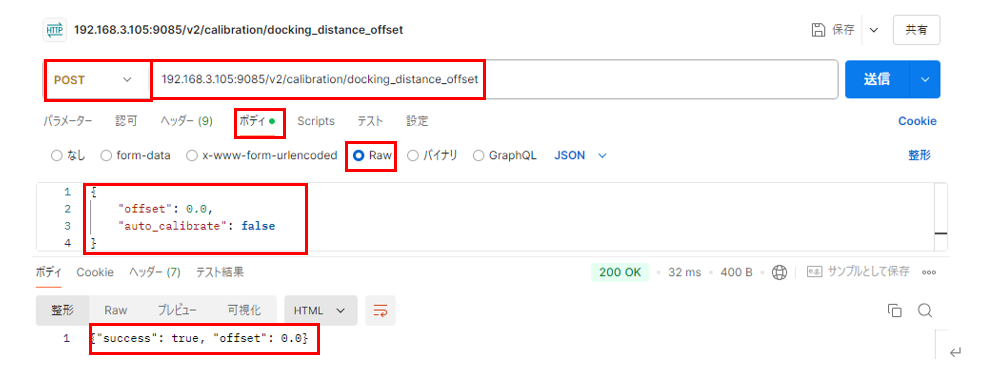
参考コード例 Python
import requests #「requests」ライブラリのインストールが必要です
import json
url = 'http://xxx.xxx.x.xxx:9085/v2/calibration/docking_distance_offset' #IPアドレスを入力
params = {
"offset": <float32>, #充電ドッキング距離のオフセット値
"auto_calibrate": <bool> #自動キャリブレーション機能の有効/無効設定
}
res = requests.post(url, json=params)
data = json.loads(res.text)
print(data)参考コード例 Javascript
<script>
let request = new XMLHttpRequest();
request.open('POST', 'http://192.XXX.X.XX:9085/v2/calibration/docking_distance_offset ', true); //IPアドレスを入力
request.setRequestHeader('content-type', 'application/json;charset=UTF-8');
request.responseType = 'json';
let body = {
offset: <float32>, //充電ドッキング距離のオフセット値
auto_calibrate: <bool> //自動キャリブレーション機能の有効/無効設定
};
request.send(JSON.stringify(body));
request.onload = function() {
window.alert( JSON.stringify( this.response ) );
};
</script>cmdsについて
cmds の配列内には、cmd (タスク) を格納する。
cmd 内で タスクの種類は cmdType で定義する。
タスクは上から順番に実⾏される。
cmds の例
cmd Type 100 の例を以下に示す。
{
"arg":{
"disableReplanning": false,
"disableStartAnnouncement": false,
"disableStopAnnouncement": false,
"enableObstacleAvoidance": true,
"enableRerouteRecovery": false,
"ignoreTheta": true,
"mode": 1,
"name": "",
"obstacleTimeout": 0,
"passingPoint": false,
"pathWidth": 2,
"theta": 0.2104844733192039,
"type": 0,
"x": -2.4687551467702415,
"y": 0.11556883023304287
},
"cmdType": 100
}cmdType の定義は次項参照。
cmdType の定義
MoveToPosition の座標指定について、詳細は後半 「座標指定について」 を参照下さい。
| Cmd Type | Name |
|---|---|
| 10 | Wait For Time 一定時間待機 |
| 20 | Pause taskset execution タスクセットの一時停止 |
| 100 | Move To Position 座標移動 |
| 110 | Follow path 経路移動 |
| 200 | LineTracer ライントレーサ |
| 300 | Wait For GPIO Input GPIO入力待機 |
| 310 | Write GPIO Output GPIO出力書込 |
| 320 | Send message by MQTT MQTTメッセージの送信 |
| 400 | Turn In Place 回転 |
| 410 | Move Straight 直進 |
| 500 | Play Sound サウンド再生 |
| 600 | Enable Power Output 電源出⼒ |
| 610 | Set Footprint フットプリント変更 |
| 620 | Set OBS Sensor State 障害物センサ切替 |
| 630 | Set Max Speed 最⼤速度変更 |
cmd 10: 一定時間待機
Data Scheme:
コードを表示するためにクリックしてください
{
"cmds":[{
"arg":{
"time":<uint32> #Wait time ms
},
"cmdType":10
}]
}コードを表示するためにクリックしてください
{
"cmds":[{
"arg":{
"time":3000
},
"cmdType":10
}]
}cmd 20: タスクセットの一時停止
Data Scheme:
コードを表示するためにクリックしてください
{
"cmds":[{
“arg”:{} ,
"cmdType":20
}]
}コードを表示するためにクリックしてください
{
"cmds":[{
“arg”:{},
"cmdType":20
}]
}cmd 100: 座標移動
Data Scheme:
コードを表示するためにクリックしてください
{
"cmds":[{
"cmdType":100,
"arg":{
"disableReplanning": false,
"disableStartAnnouncement": false,
"disableStopAnnouncement": false,
"enableObstacleAvoidance": true,
- "enableRerouteRecovery": false,
"ignoreTheta": true,
"mode": 1,
"name": "",
"obstacleTimeout": 0,
"passingPoint": false,
"pathWidth": 2,
"theta": 0.2104844733192039,
"type": 0,
"x": -2.4687551467702415,
"y": 0.11556883023304287
}
}]
}コードを表示するためにクリックしてください
{
"cmds":[{
"cmdType":100,
"arg":{
"disableReplanning": false,
"disableStartAnnouncement": false,
"disableStopAnnouncement": false,
"enableObstacleAvoidance": true,
- "enableRerouteRecovery": false,
"ignoreTheta": true,
"mode": 1,
"name": "",
"obstacleTimeout": 0,
"passingPoint": false,
"pathWidth": 2,
"theta": 0.2104844733192039,
"type": 0,
"x": -2.4687551467702415,
"y": 0.11556883023304287
}
}]
}cmd 110: 経路移動
Data Scheme:
コードを表示するためにクリックしてください
{
"cmds":[{
"cmdType":110,
"arg":{
"disableStartAnnouncement":<bool>,
"disableStopAnnouncement":<bool>,
"enableObstacleAvoidance":<bool>,
"ignoreTheta":<bool>,
# if true, the direction(angle) isn’t considered.
"path":[{"x":<float64>,
"y":<float64>},
・・・
{"x":<float64>,
"y":<float64>}]
"width":<float64>,
#Avoid obstacles in a range of [m] in diameter.
"theta":<float64>,
"passingPoint":<bool>,
#if true, AMR will pass the point without stopping
}
}]
}コードを表示するためにクリックしてください
{
"cmds":[{
"cmdType":110,
"arg":{
"disableStartAnnouncement": true,
"disableStopAnnouncement": true,
"enableObstacleAvoidance": true,
"ignoreTheta": true
"path":[{"x":3.947,
"y":0.134},
{"x":5.126,
"y":0.320}],
"width":1.0,
"theta":1.343,
"passingPoint":false,
}
}]
}cmd 200: ライントレーサ
Data Scheme:
コードを表示するためにクリックしてください
{
"cmds":[{
"arg":{
"distance":<float64>,
#only available mode:2, unit:[m]
"disableStartAnnouncement":<bool>,
"marker_size":<float64>,
#Reserve
"mode":<int>,
#0:STOP_INTERSECTION,2:STOP_DISTANCE
"marker_distance":<float64>,
#Reserve
"speed":<float64>,
#line trace speed.
“marker_id”:<int>
},
"cmdType":200
}]
}コードを表示するためにクリックしてください
{
"cmds":[{
"arg":{
"distance":1.0,
"disableStartAnnouncement":true,
"marker_size":0.05,
"mode":2,
"marker_distance":0.3,
"speed":0.25,
"marker_id":1,
},
"cmdType":200
}]
}cmd 300: GPIO入力待機
Data Scheme:
コードを表示するためにクリックしてください
{
"cmds":[{
"arg":{
“pin”:<int>,
#pin number {101: IN1, 102: IN2}
"action":<int>,
#{1: LOW->HIGH, 2: HIGH->LOW,
# 3: TOGGLE, 4: HIGH, 5: LOW}
# action of signal timeout
"timeout":<float32>
# timeout (sec) to go to error "110"
},
"cmdType":300
}]
}
# timeout :0 waits indefinitely
# action HIGH / LOW moves to next task
# if it is already in the state.コードを表示するためにクリックしてください
{
"cmds":[{
"arg":{
"pin":101,
"action":2,
"timeout":2000
},
"cmdType":300
}]
}cmd 310: GPIO出力書込
Data Scheme:
コードを表示するためにクリックしてください
{
"cmds":[{
"arg":{
"pin":<int>,
#pin number {201: OUT1, 202: OUT2}
"action":<int>
#{1: HIGH, 2: LOW, 3: TOGGLE}
# action of signal
},
"cmdType":310
}]
}コードを表示するためにクリックしてください
{
"cmds":[{
"arg":{
"pin":201,
"action":2
},
"cmdType":310
}]
}cmd 320: MQTTメッセージの送信
Data Scheme:
コードを表示するためにクリックしてください
{
"cmds":[{
"arg":{
"message":<string>
#MQTT message
},
"cmdType":320
}]
}コードを表示するためにクリックしてください
{
"cmds":[{
"arg":{
"message": “End of task”
},
"cmdType":320
}]
}cmd 400: 回転
Data Scheme:
コードを表示するためにクリックしてください
{
"cmds":[{
"arg":{
"angle":<float32>, #degrees
"velocity":<float32>, #degrees/sec
"direction":<int>
#{0:clockwise, 1:counterclockwise}
},
"cmdType":400
}]
}コードを表示するためにクリックしてください
{
"cmds":[{
"arg":{
"angle":90,
"velocity":30,
"direction":0
},
"cmdType":400
}]
}cmd 410: 直進
Data Scheme:
コードを表示するためにクリックしてください
{
"cmds":[{
"arg":{
"direction":<int>,
#{0: FORWARD, 1: BACKWARD}
#direction to move
"distance":<float32>,
#meters to
"velocity":<float32>
#meters /sec
},
"cmdType":410
}]
}コードを表示するためにクリックしてください
{
"cmds":[{
"arg":{
"direction":0,
"distance":1,
"velocity":0.3
},
"cmdType":410
}]
}cmd 500: サウンド再生
Data Scheme:
コードを表示するためにクリックしてください
{
"cmds":[{
"arg":{
"track": <int32>,
#track number choose from menu.
#-1 for stop ping sound
"loop": <bool>
# if true, play sound continuously on repeat
# (e.g. sound while moving)
},
"cmdType":500
}]
}コードを表示するためにクリックしてください
{
"cmds":[{
"arg":{
"track":1,
"loop":false
},
"cmdType":500
}]
}cmd 600: 電源出⼒
Data Scheme:
コードを表示するためにクリックしてください
{
"cmds":[{
"arg":{
"enable_5V":<bool> ,
# enable/disable 5 V output via relay
"enable_24V":<bool>
# enable/disable 24 V output via relay
},
"cmdType":600
}]
}コードを表示するためにクリックしてください
{
"cmds":[{
"arg":{
"enable_5V":true,
"enable_24V":true
},
"cmdType":600
}]
}cmd 610: フットプリント変更
Data Scheme:
コードを表示するためにクリックしてください
{
"cmds":[{
"arg":{
"footprint":<string>,
# list of 2d points to make footprint
"robot_radius":0.0
# robot_radius is always 0.
#Only used if footprint is empty.
},
"cmdType":610
}]
}コードを表示するためにクリックしてください
{
"cmds":[{
"arg":{
"footprint":"[[0.3,0.3],[0.3,-0.3].[-0.3,-0.3],[-0.3,0.3]]",
"robot_radius":0.0
},
"cmdType":610
}]
}cmd 620: 障害物センサ切替
Data Scheme:
コードを表示するためにクリックしてください
{
"cmds":[{
"arg":{
"enable_cliff_center":<bool>,
"enable_cliff_left":<bool>,
"enable_cliff_right":<bool>,
"enable_front_center":<bool>,
"enable_front_left":<bool>,
"enable_front_right":<bool>,
"enable_left":<bool>,
"enable_right":<bool>
#if true, obstacle sensors detection should be enabled.
},
"cmdType":620
}]
}コードを表示するためにクリックしてください
{
"cmds":[{
"arg":{
"enable_cliff_center": true,
"enable_cliff_left":<bool>,
"enable_cliff_right":<bool>,
"enable_front_center":<bool>,
"enable_front_left":<bool>,
"enable_front_right":<bool>,
"enable_left":<bool>,
"enable_right":<bool>
},
"cmdType":620
}]
}cmd 630: 最⼤速度変更
Data Scheme:
コードを表示するためにクリックしてください
{
"cmds":[{
"arg":{
"max_speed":<float32>
# maximum forward velocity,
#must be equal or less than 0.5 [m/s]
},
"cmdType":630
}]
}コードを表示するためにクリックしてください
{
"cmds":[{
"arg":{
"max_speed":0.3
},
"cmdType":630
}]
}タスクセットの実行が完了して 「Idle」 状態となったとき、フットプリントは元の設定値に戻ります。
マップ座標指定
マップ原点 (Origin)
先ず、マップ原点 origin の定義が必要となる。KeiganALI でマップを作成した場合には、マップ原点は⾃動的に設定される。マップ原点は、M4 /map API で取得できる response 内の、yaml 情報に格納される。
origin の, x, y は、下図におけるそれぞれ X0, Y0 となる。 (基本的にマイナスまたは0の値)
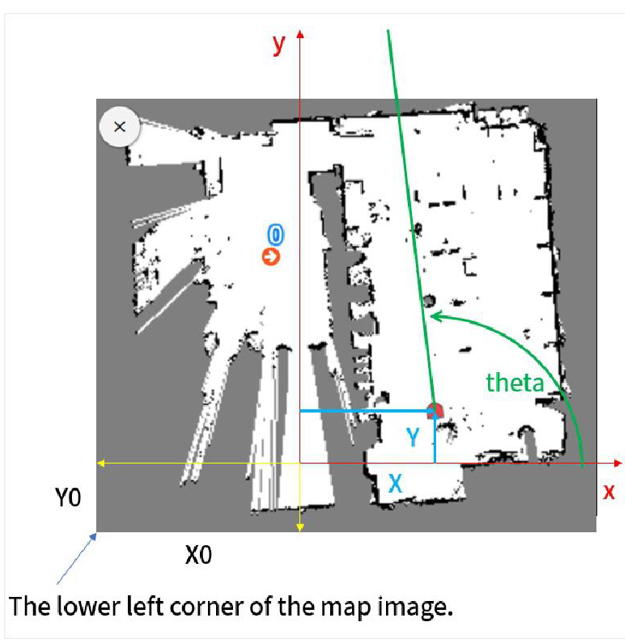
AMRの位置指定
このとき、AMRの位置はマップ原点に対する位置 (x, y) = (X, Y) として指定できる。
AMRの向きは、θ(theta)で指定され、x軸からの⾓度で定義できる。
θの範囲は、-π 〜 +π (-180°〜 +180°)となる。
MoveToPosition 等の命令では、AMRの⽬標位置 x, y 及び向き θ を指定する必要がある。
MQTT API /status で取得できる location も同様となる。

